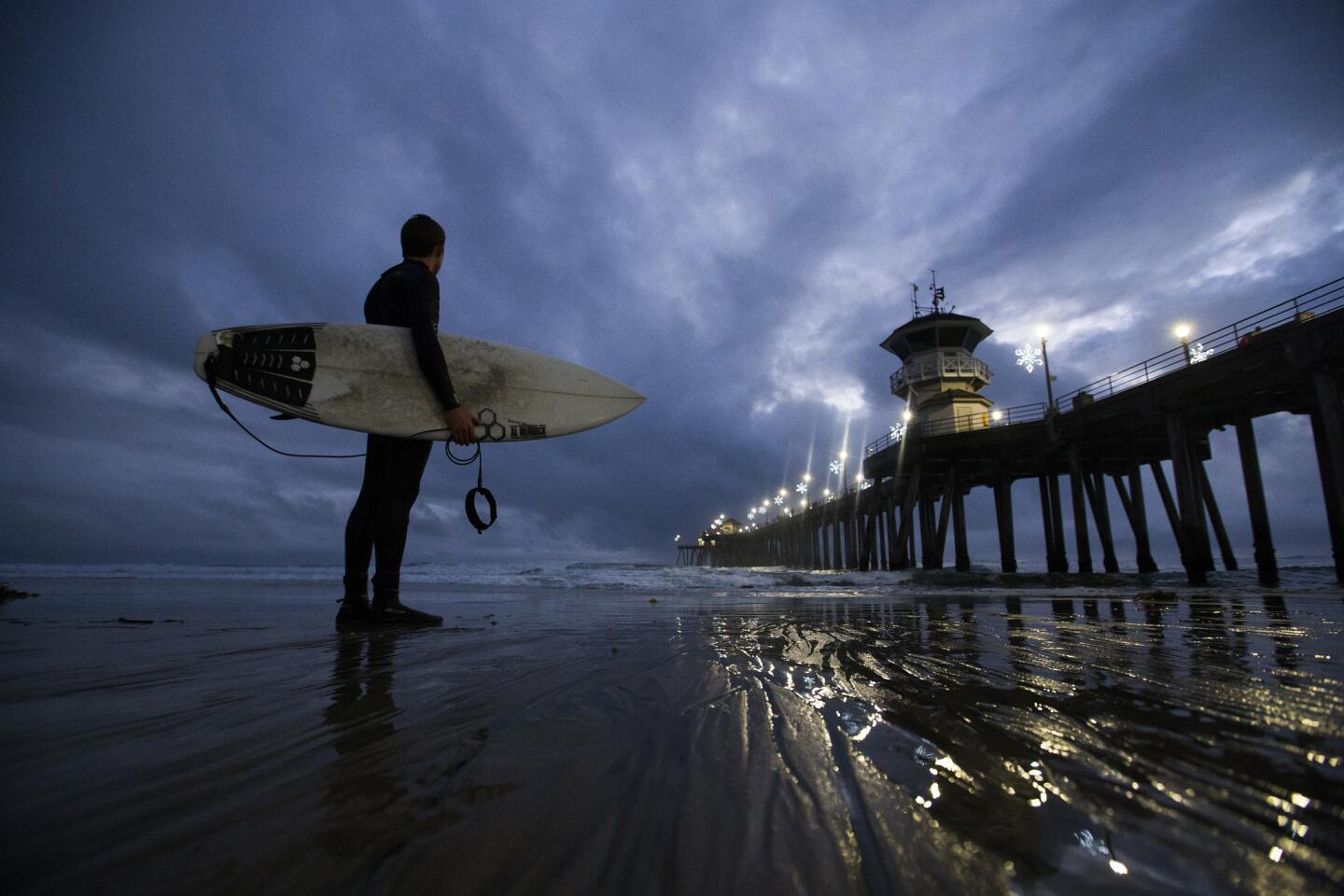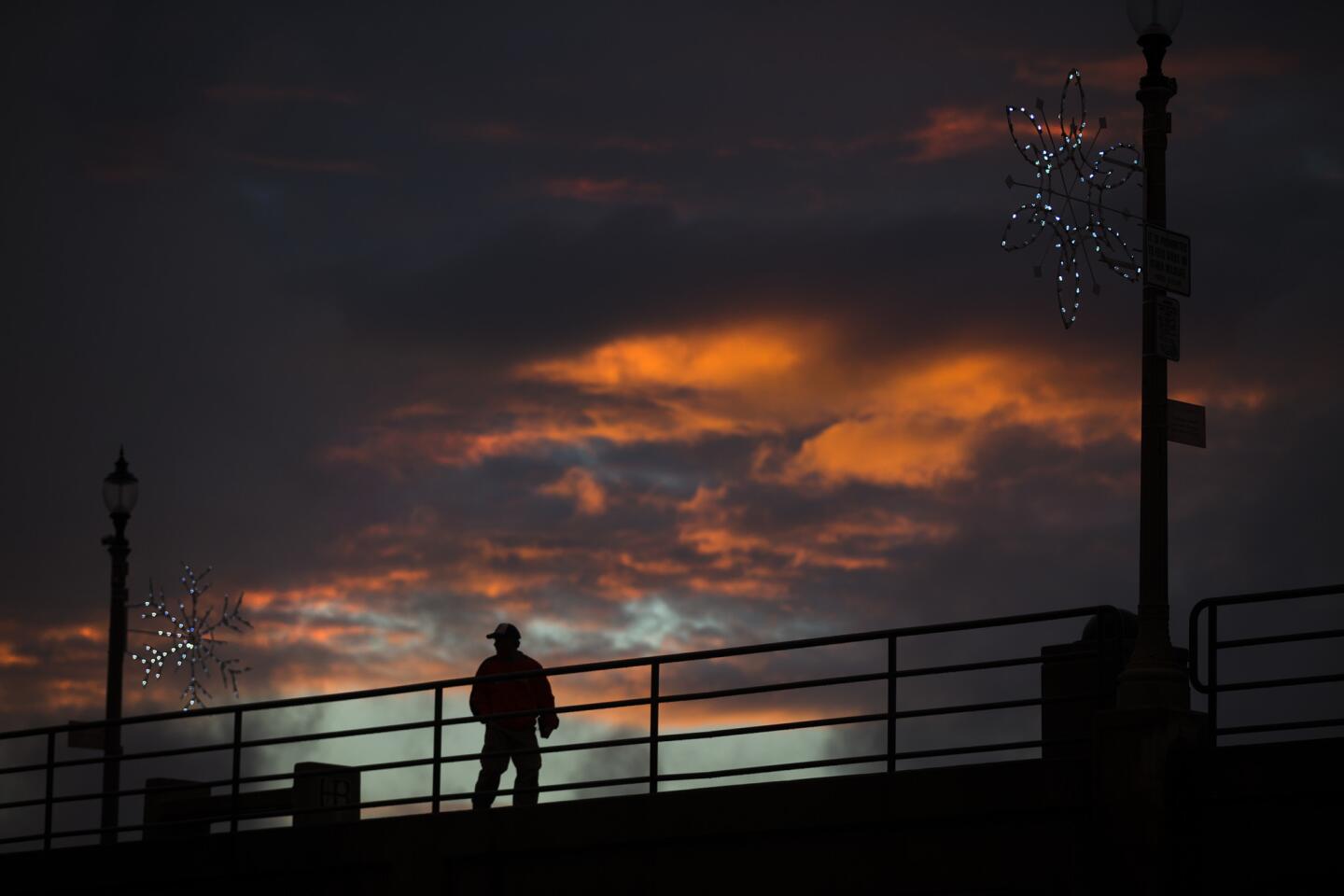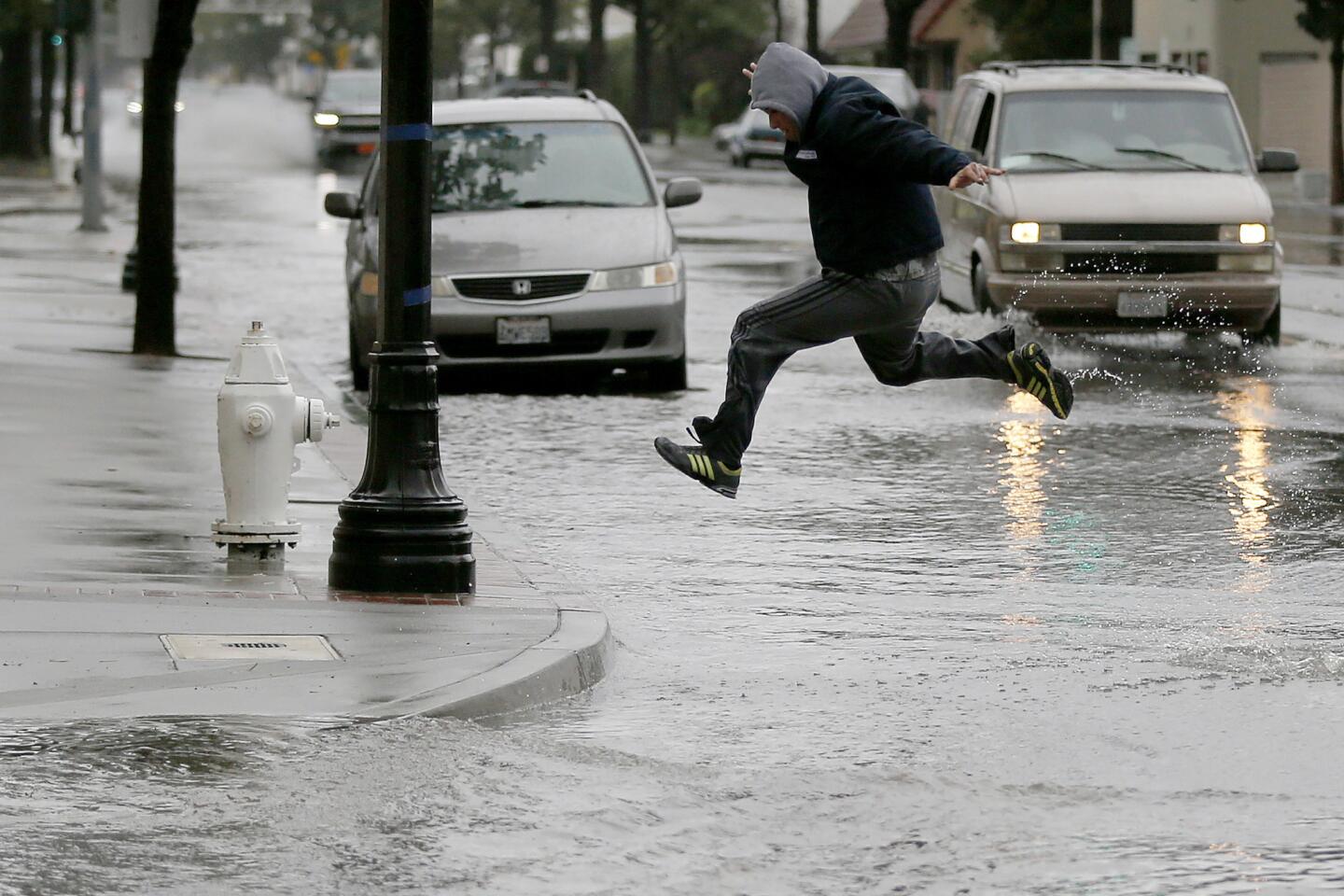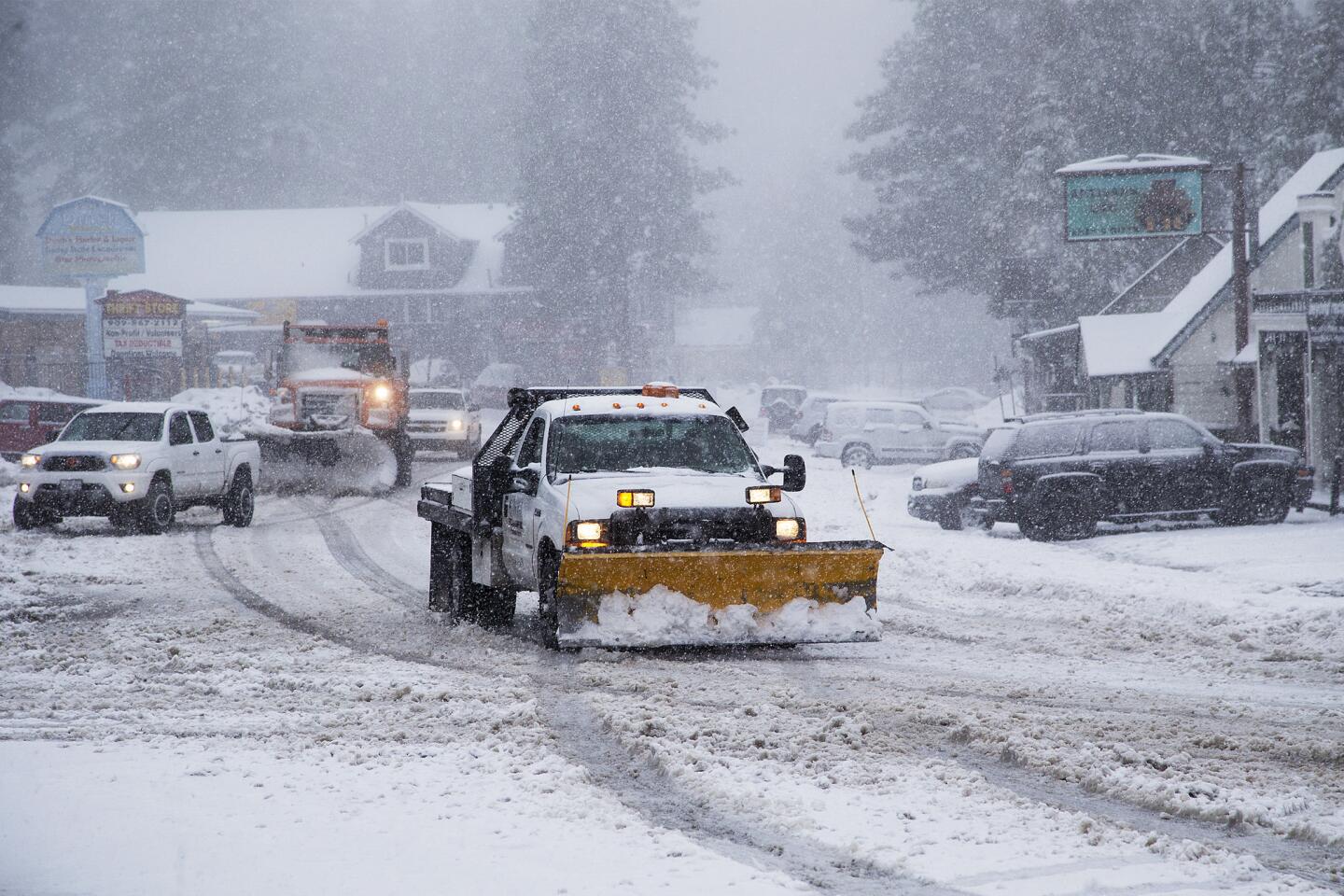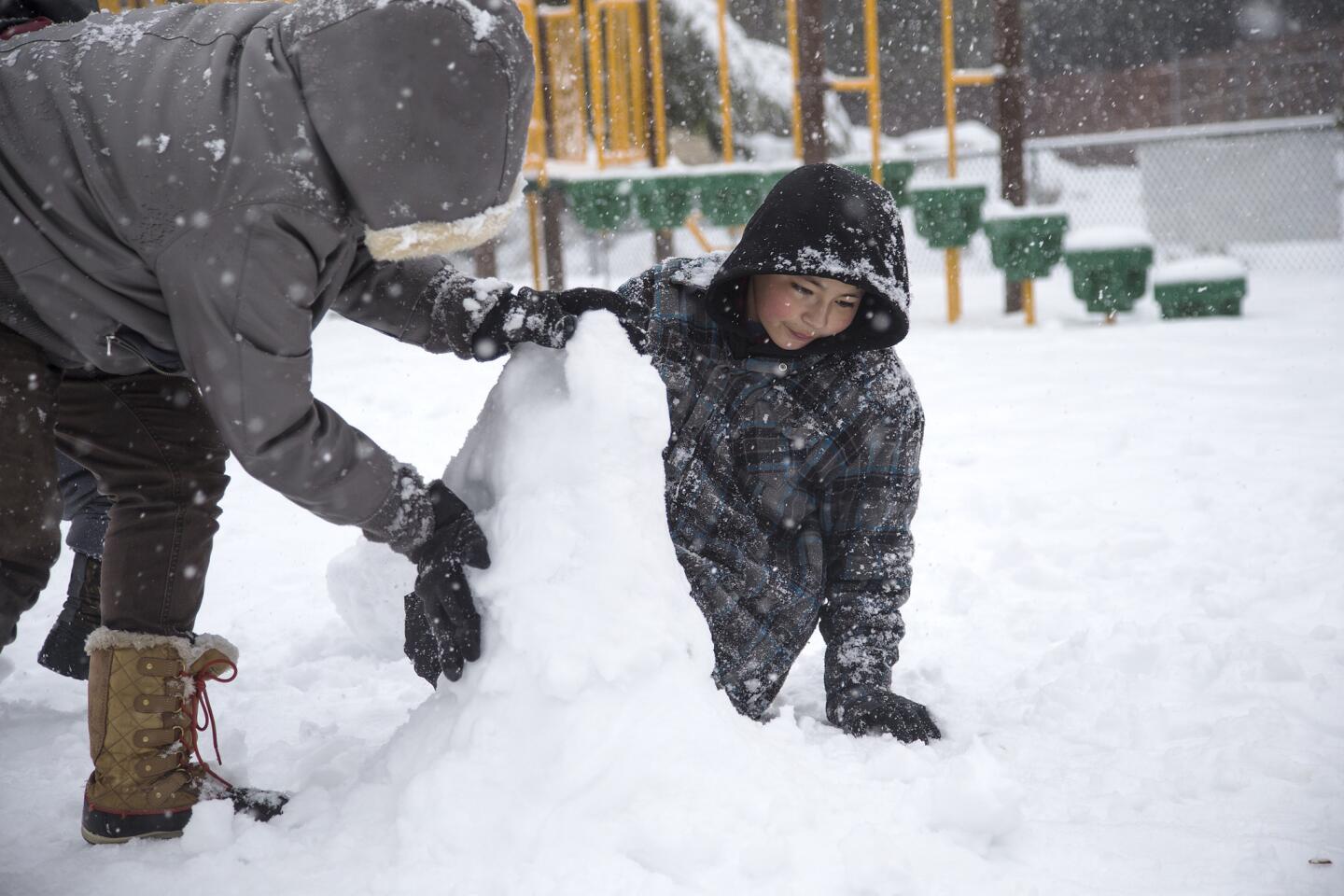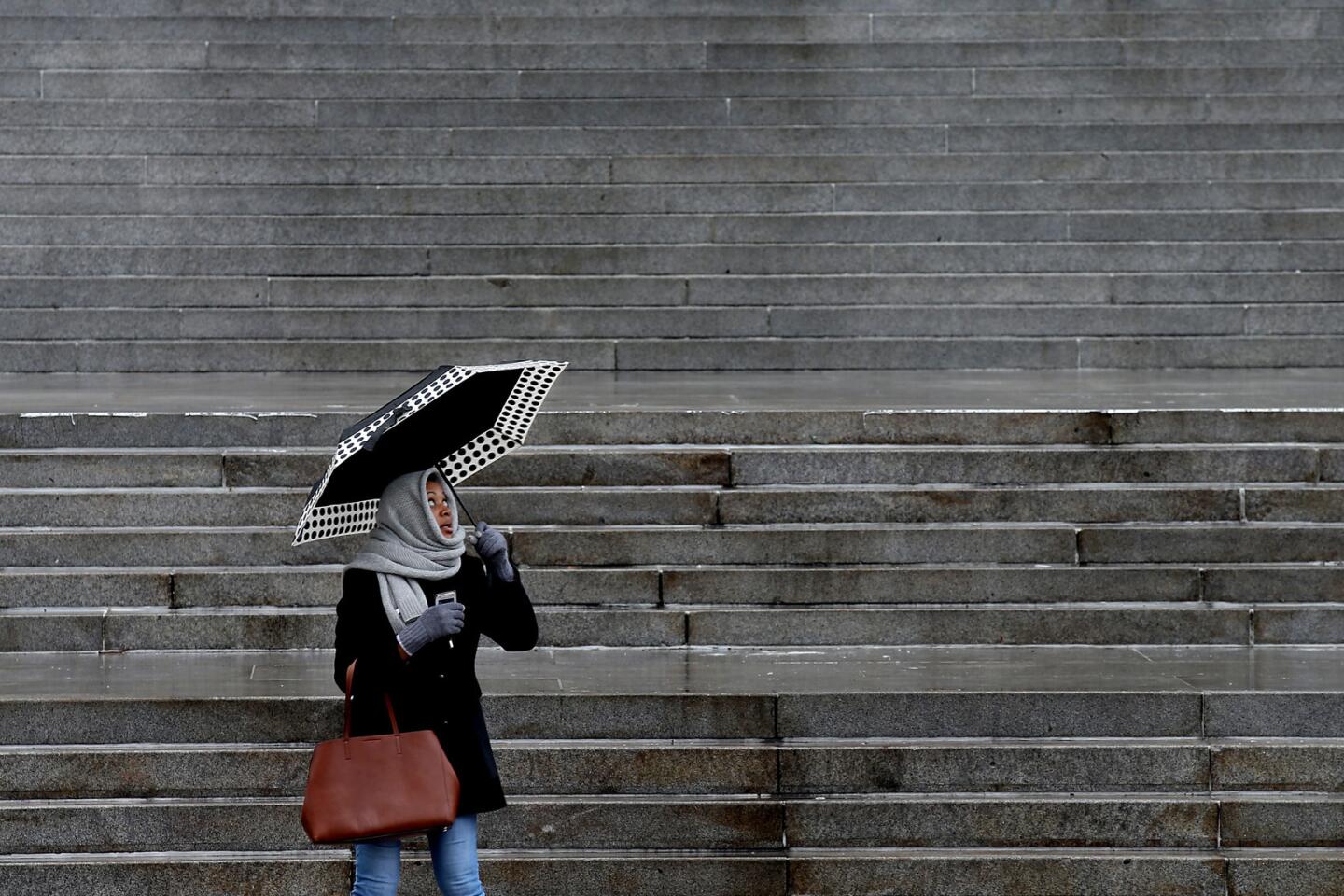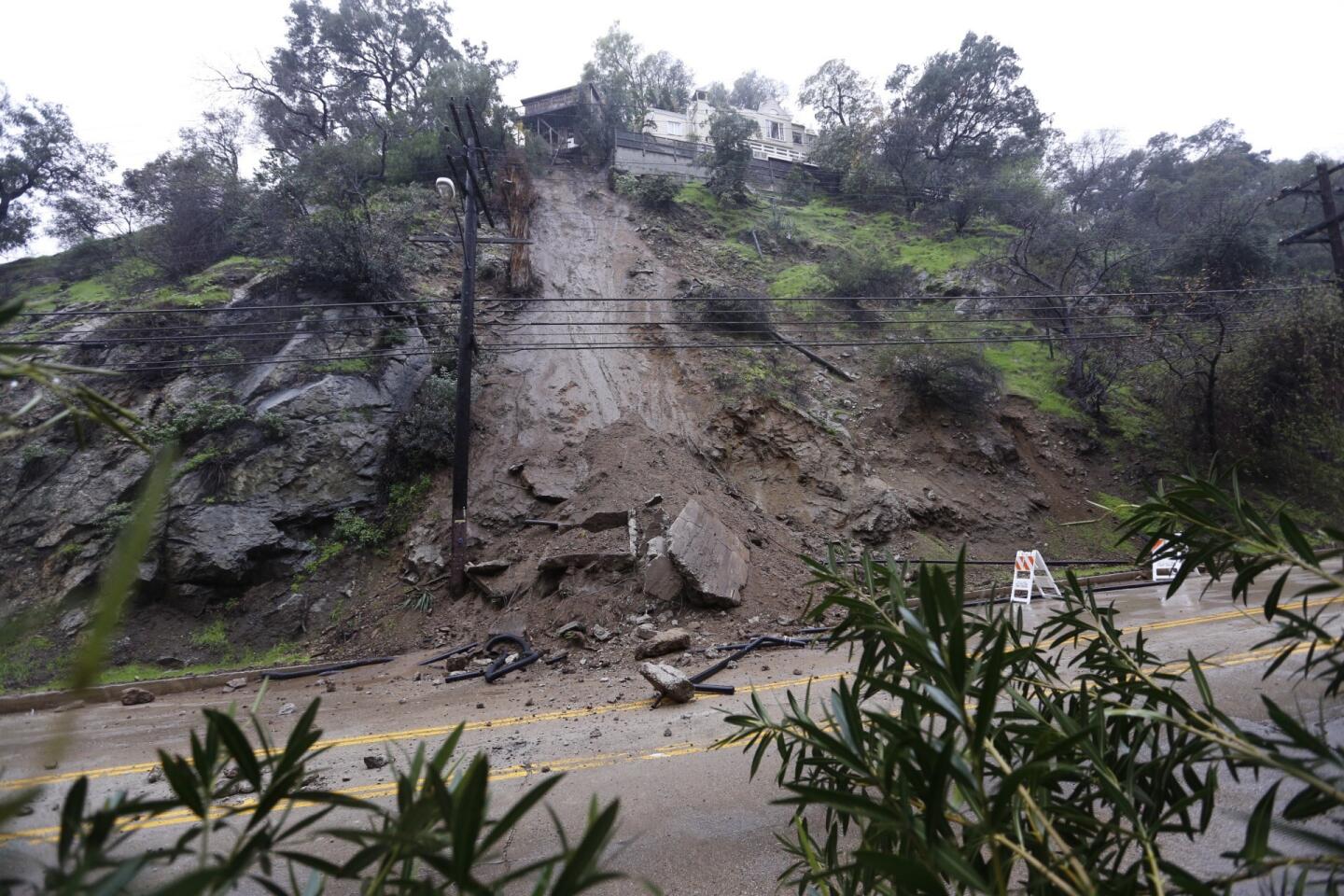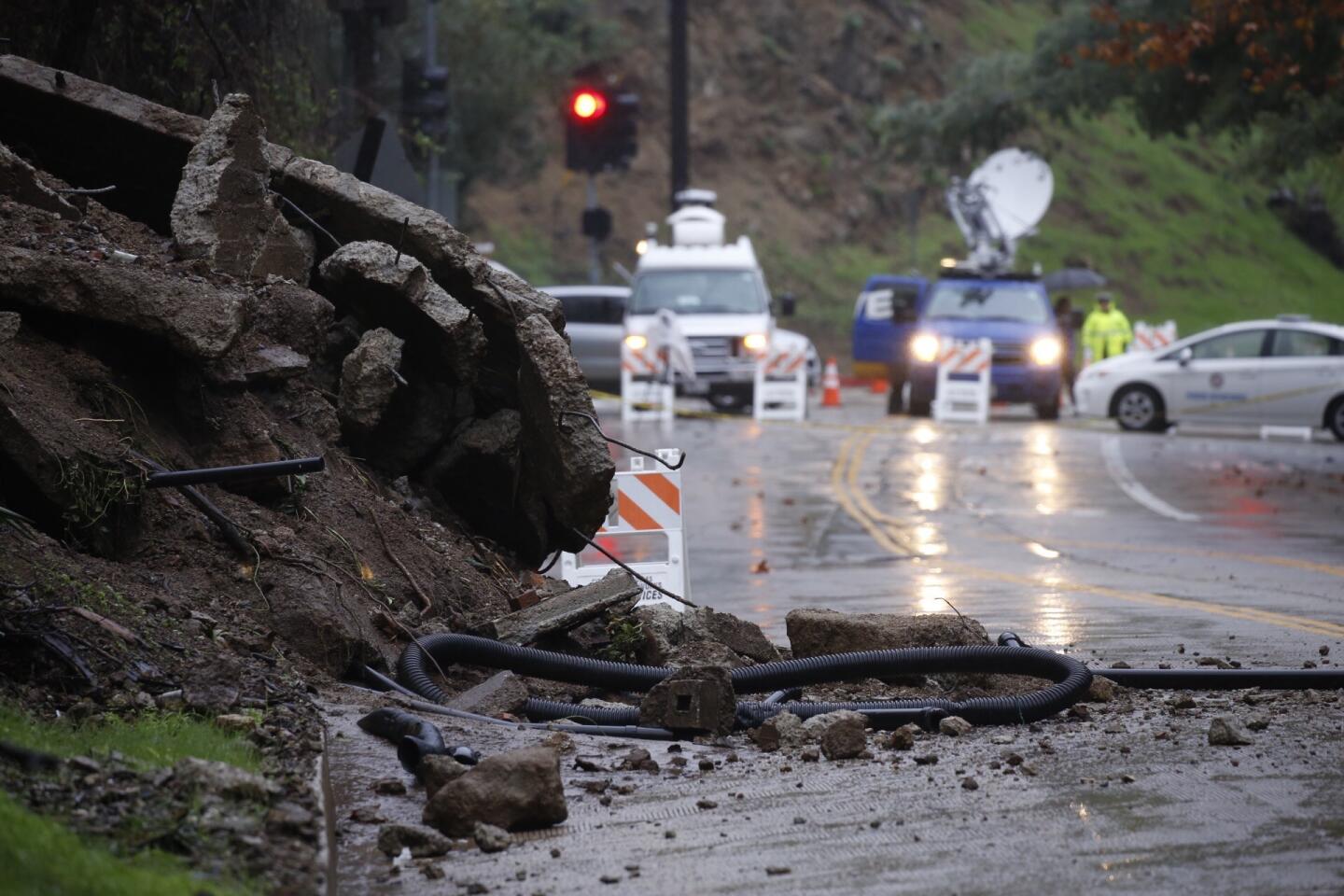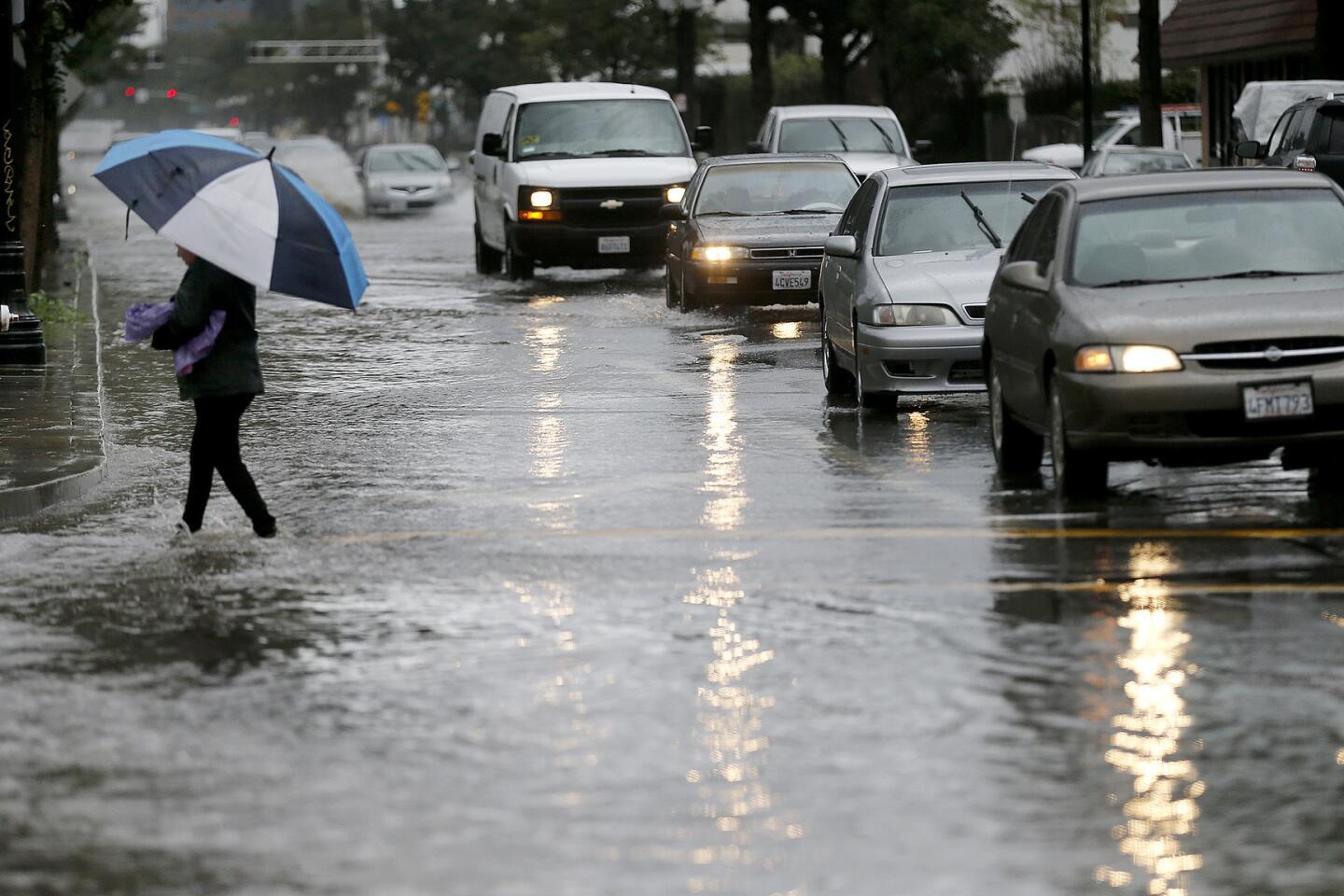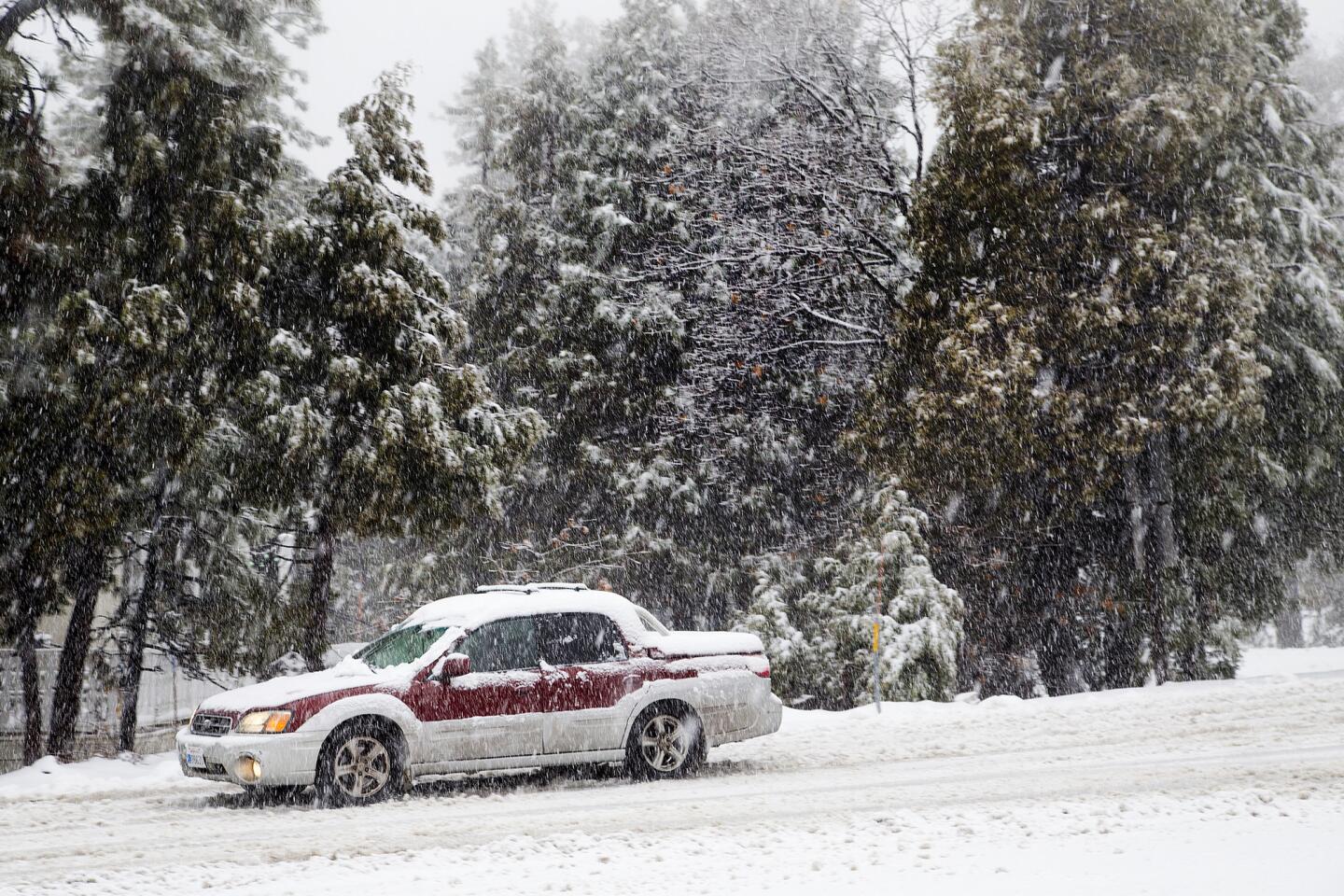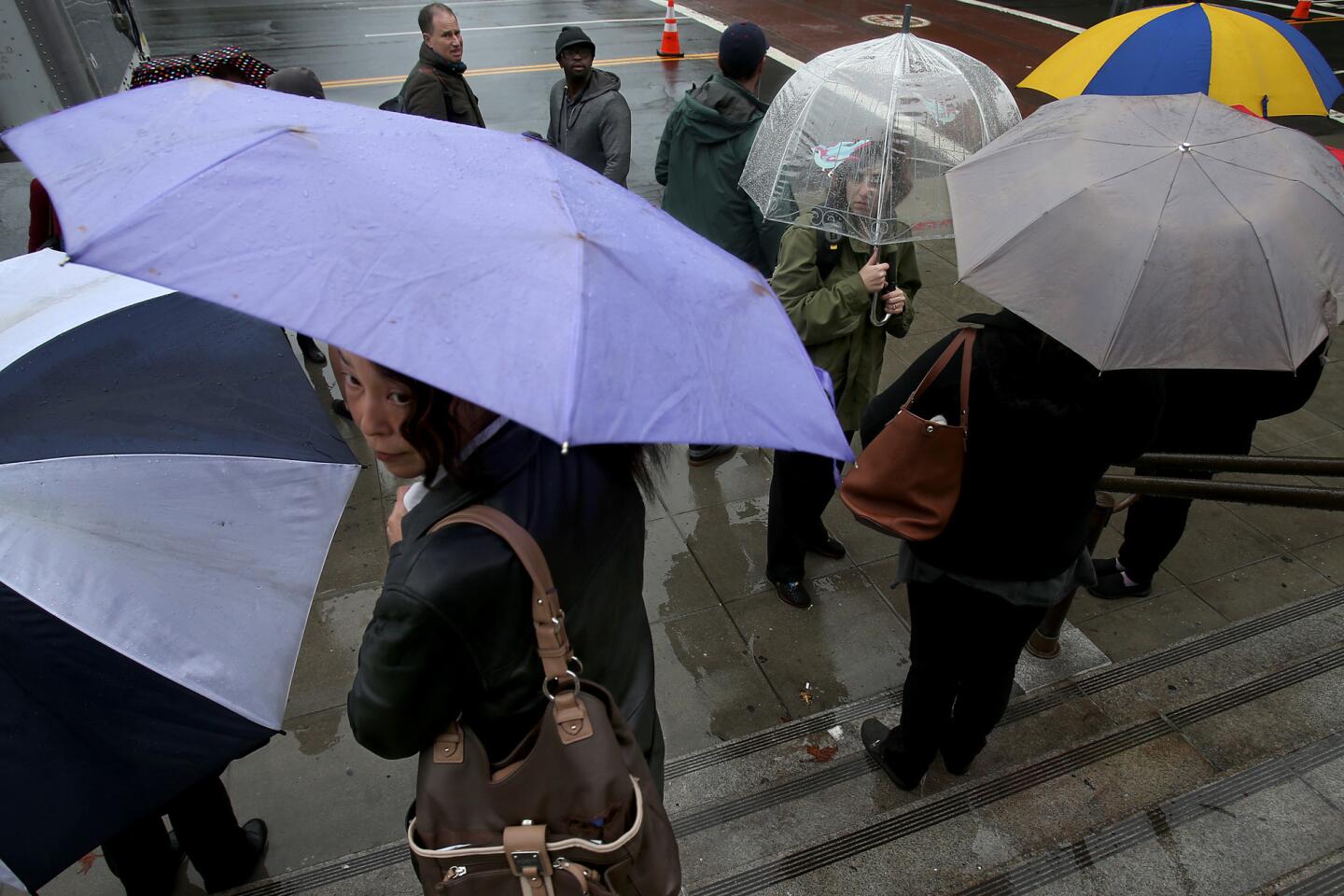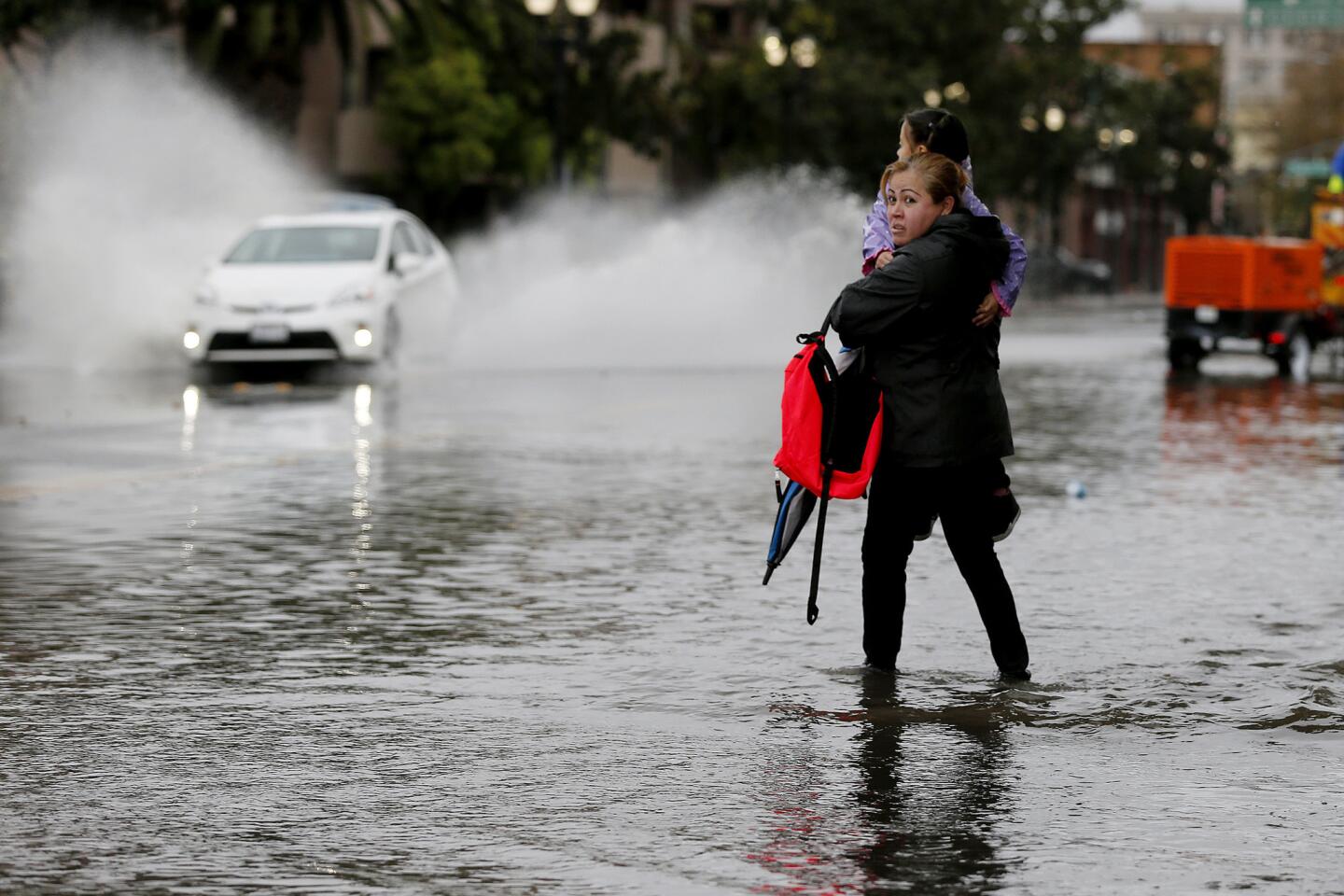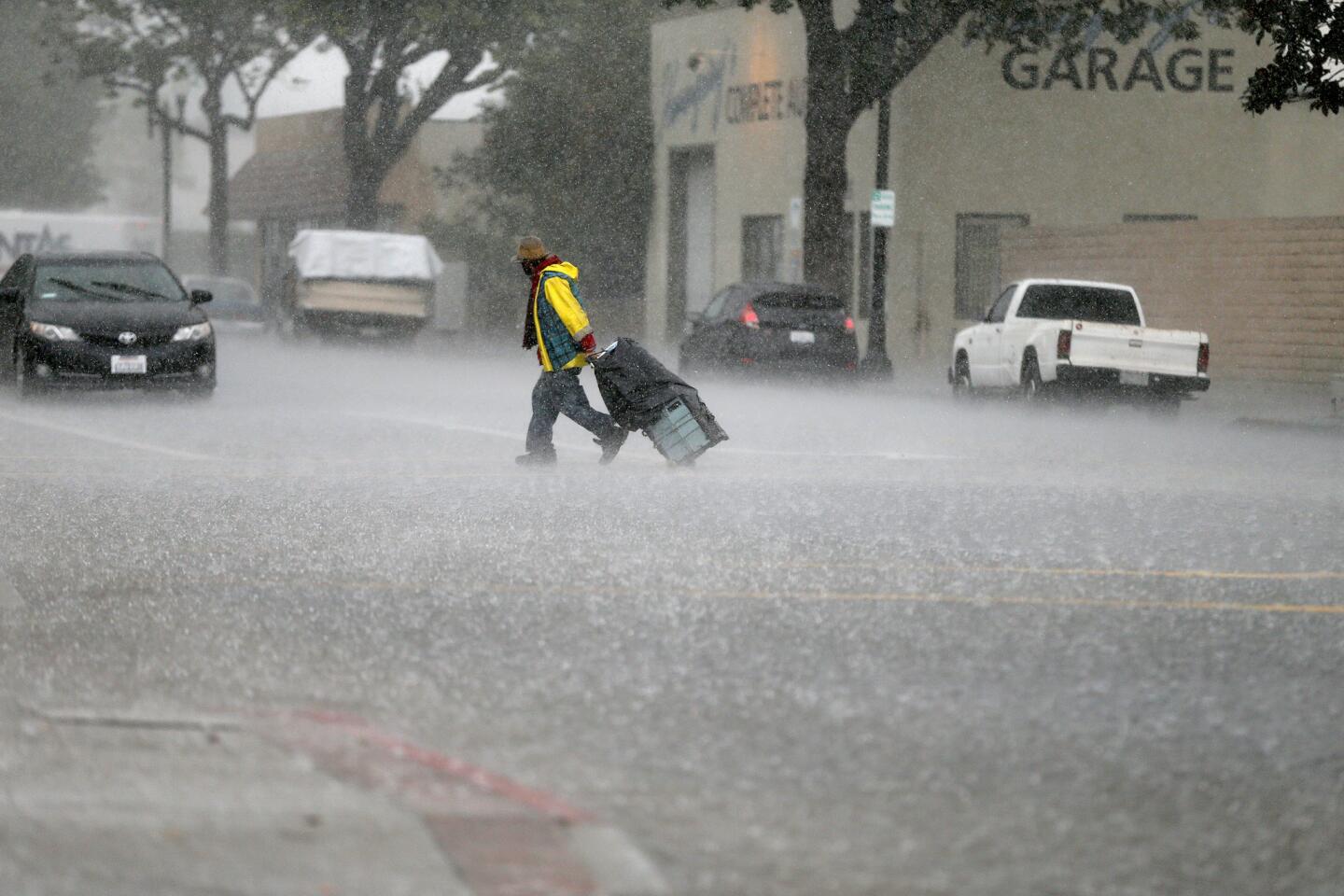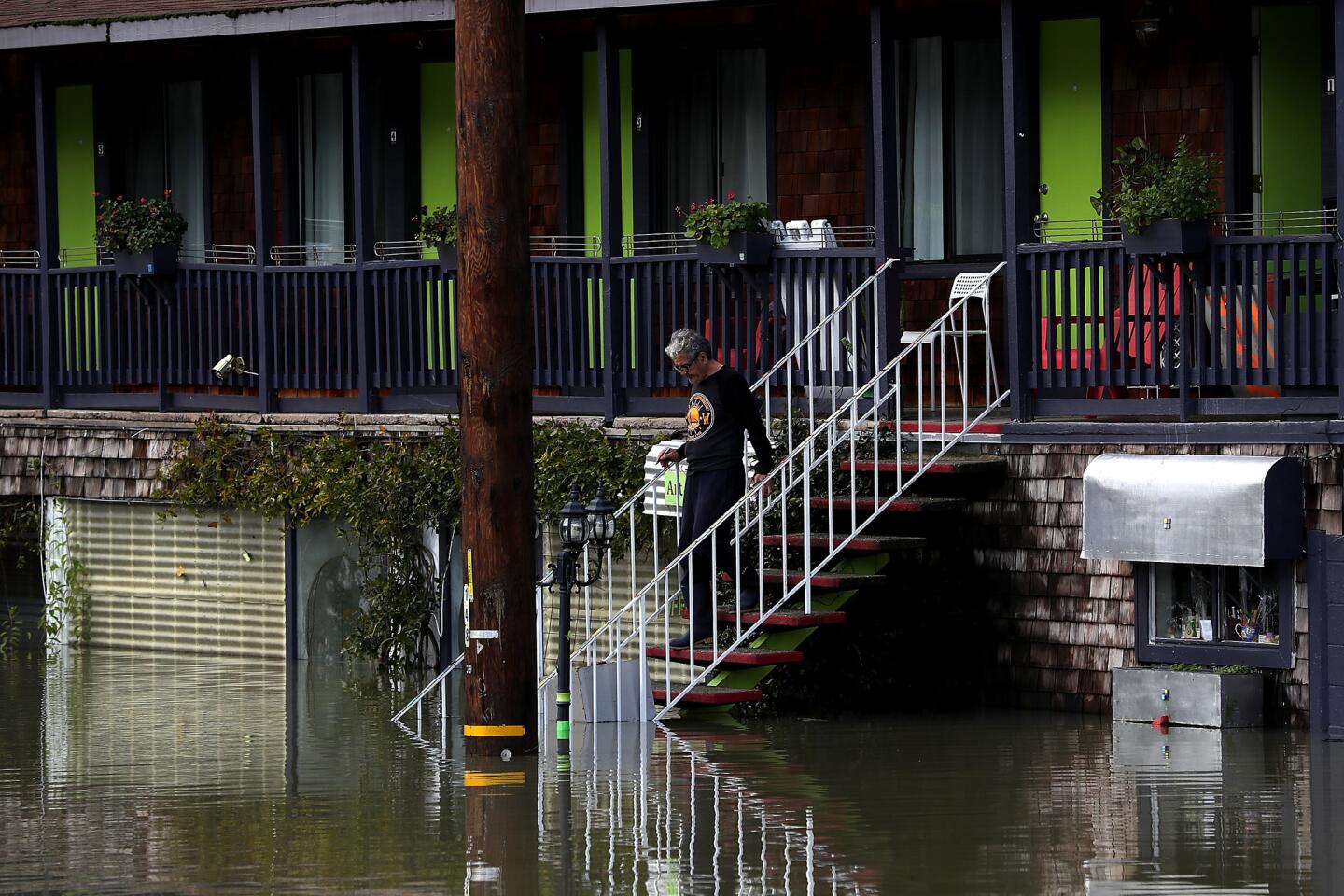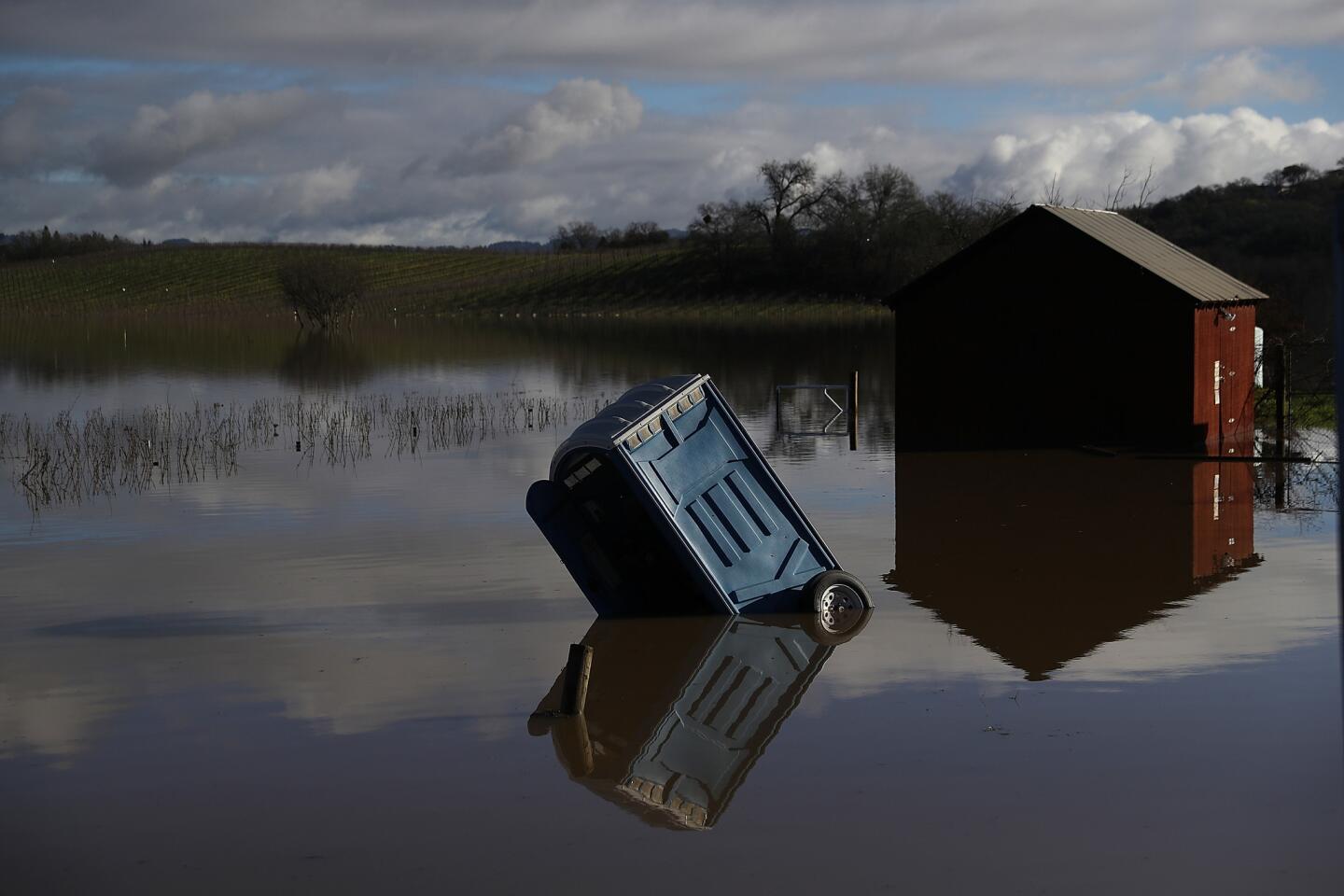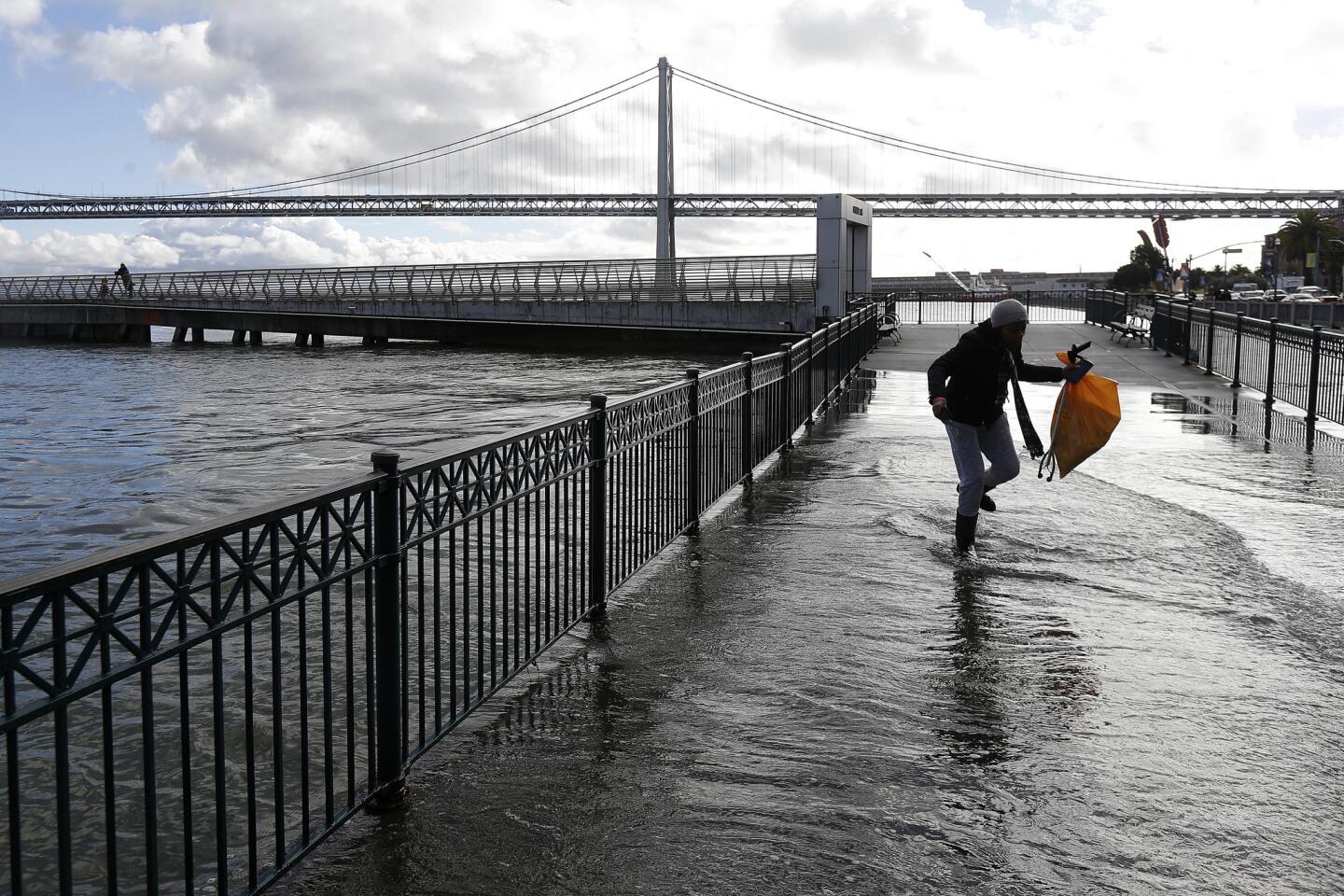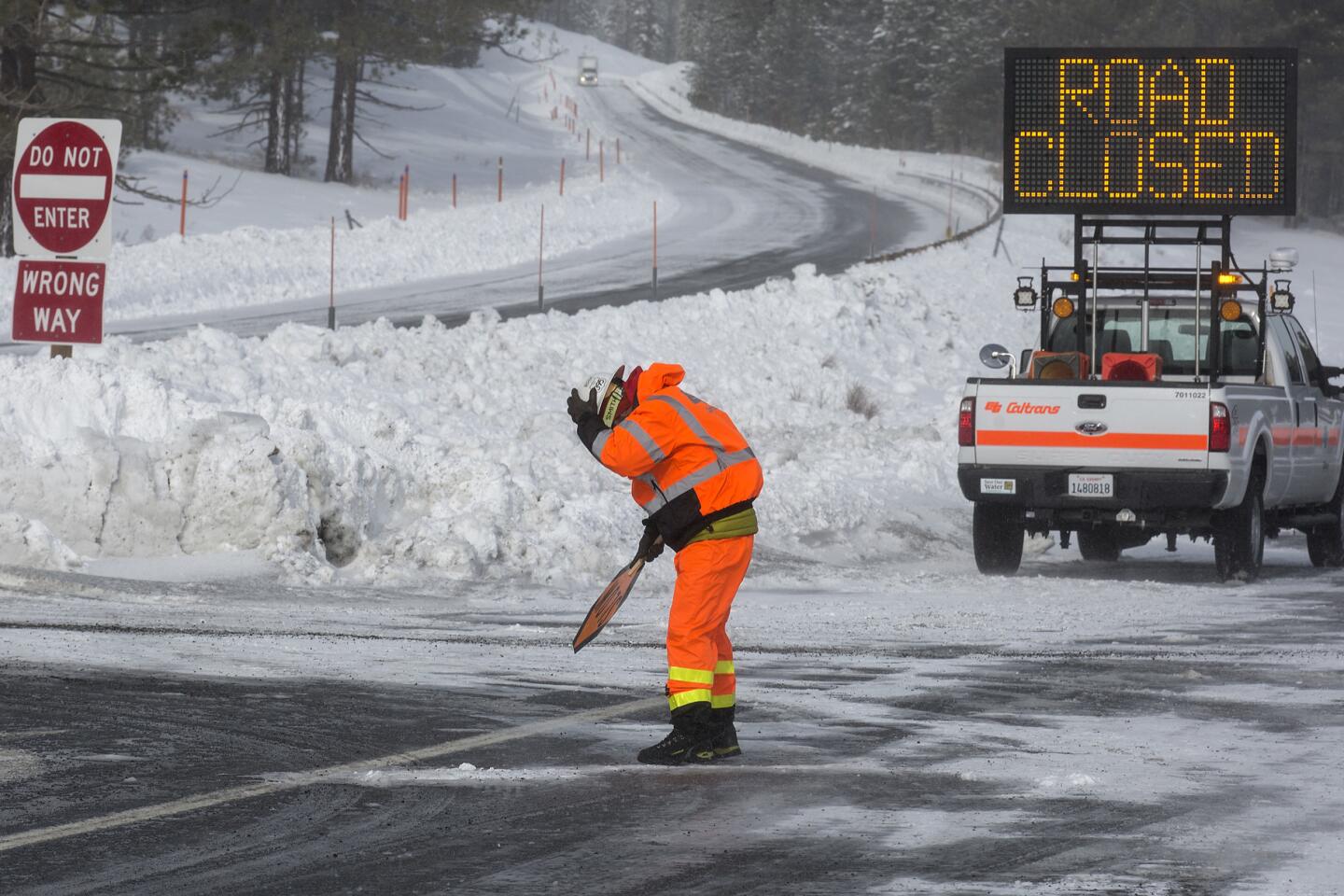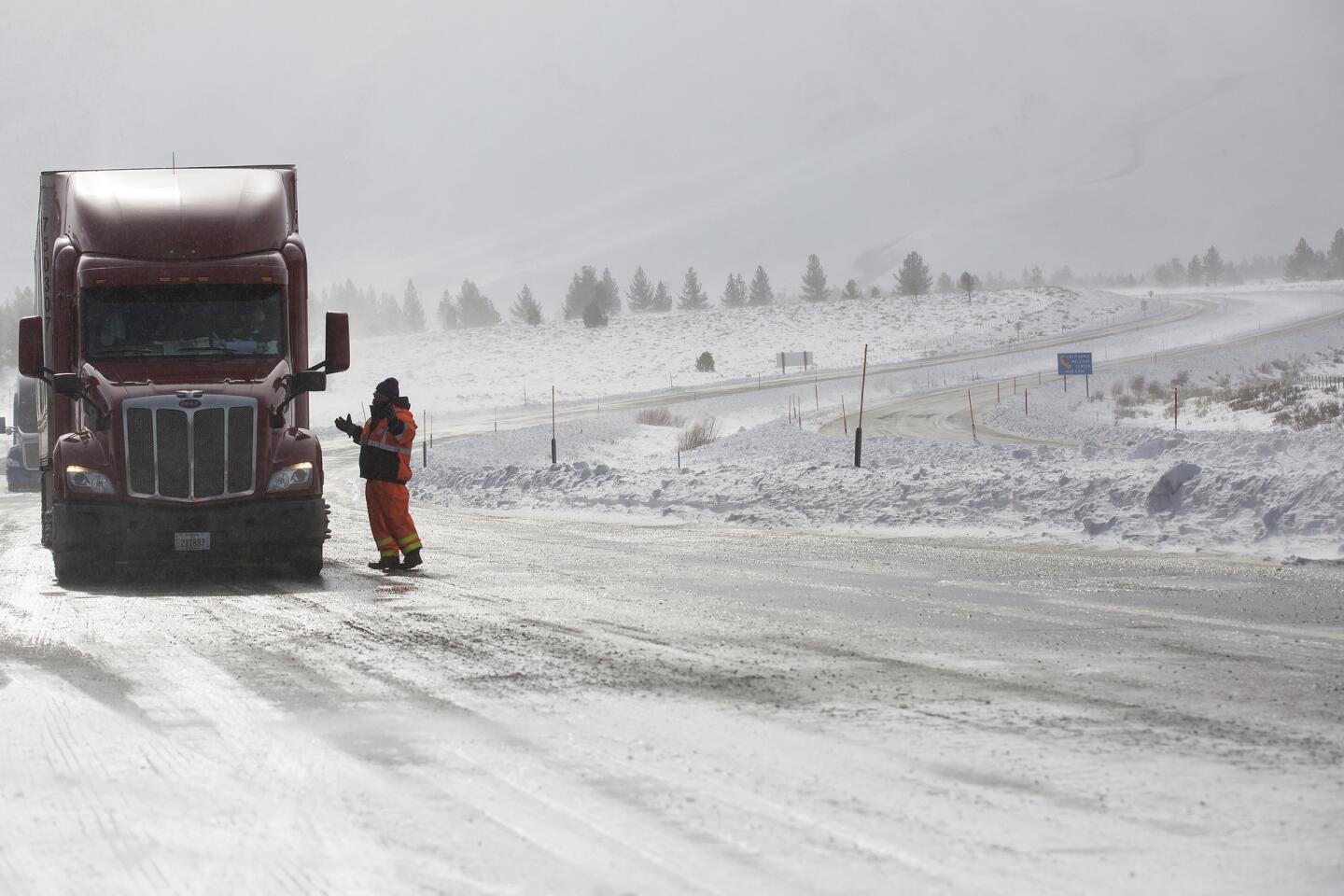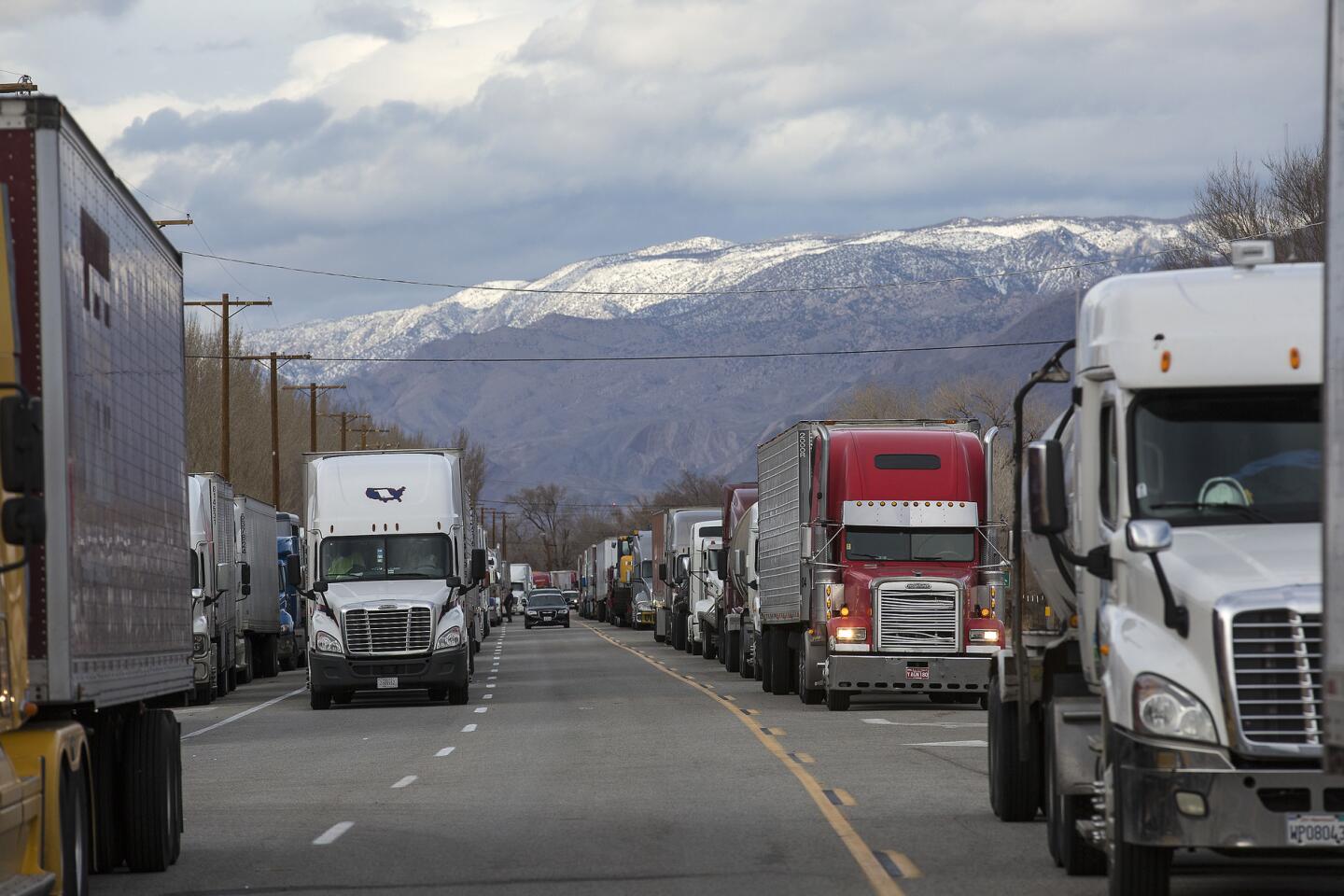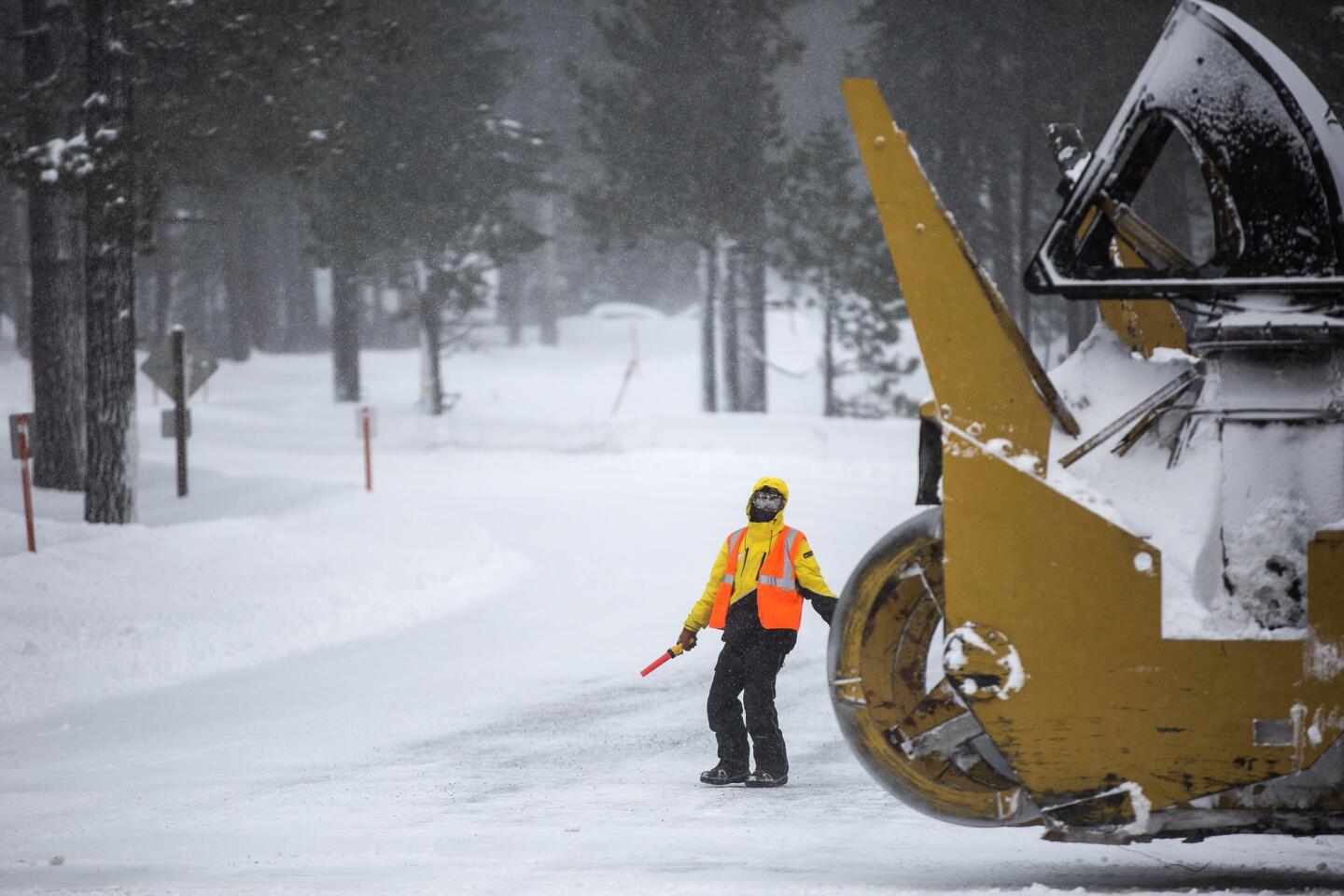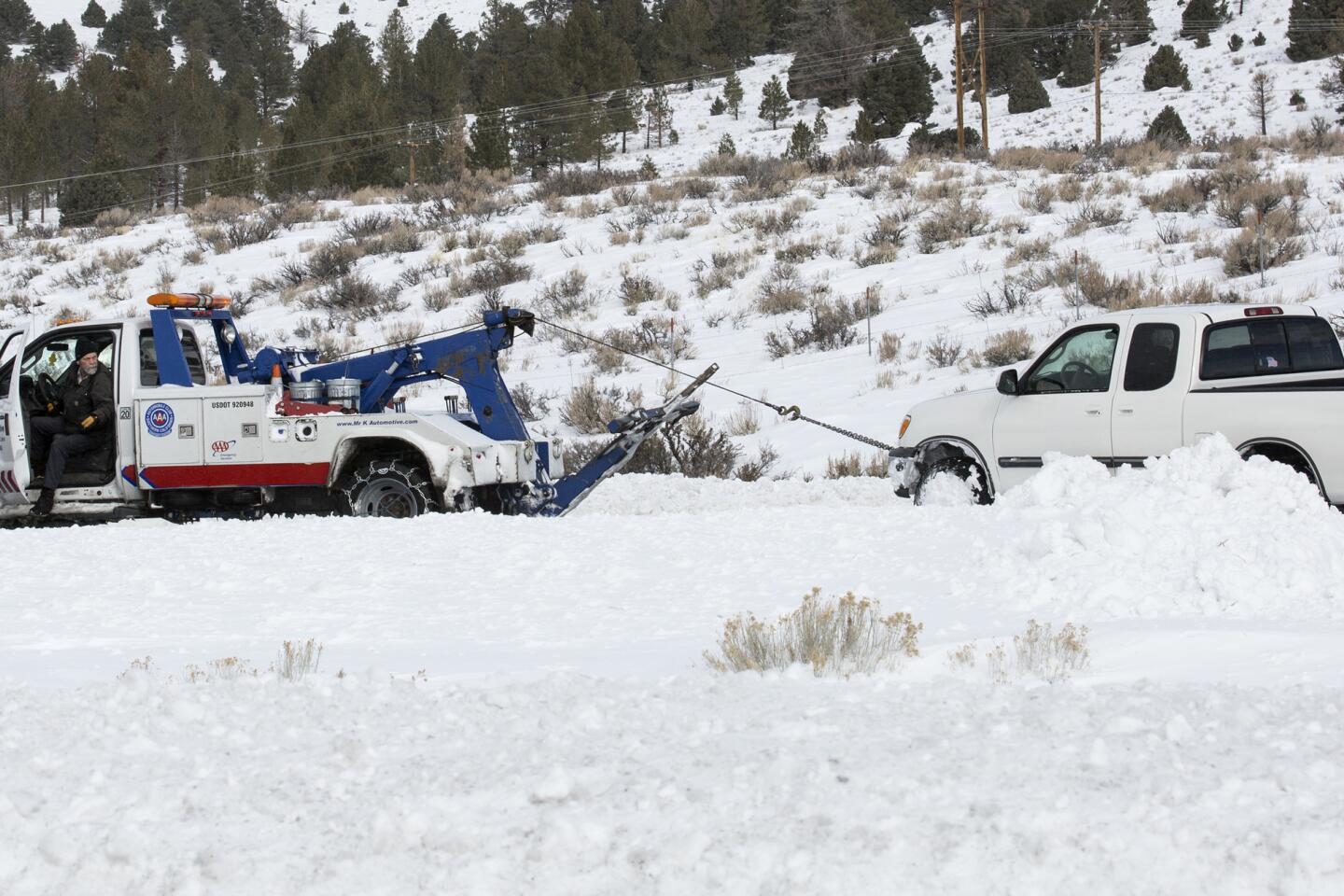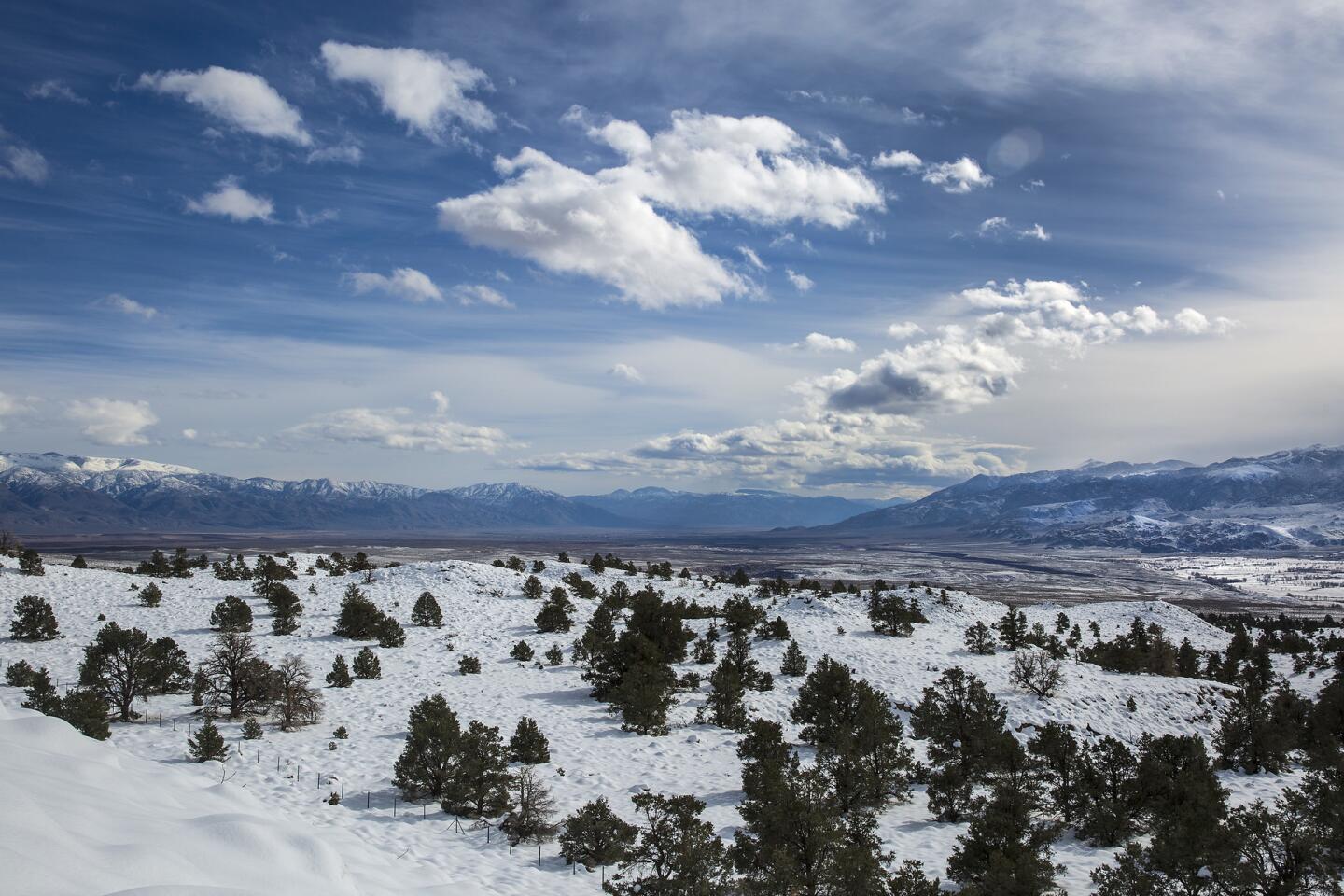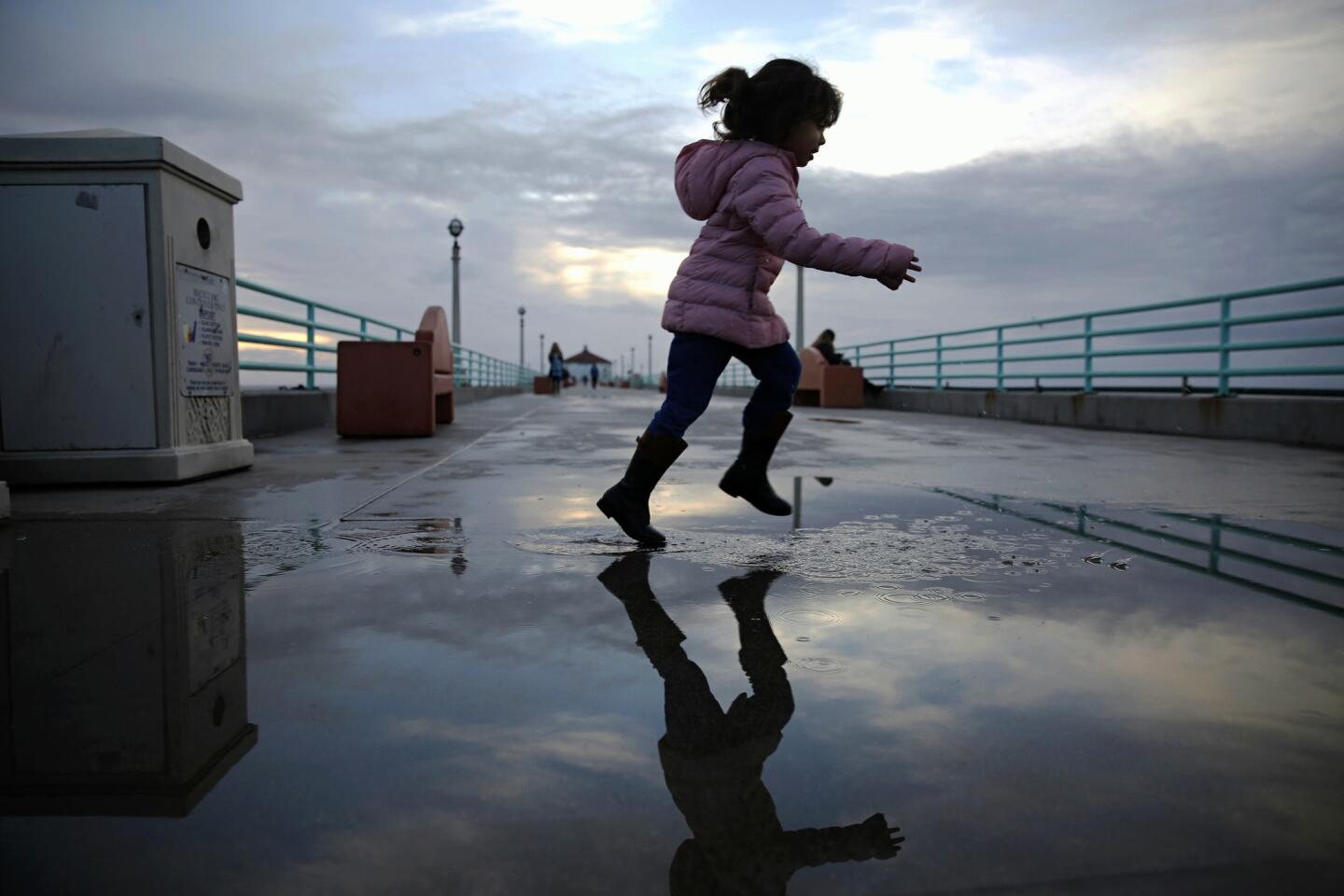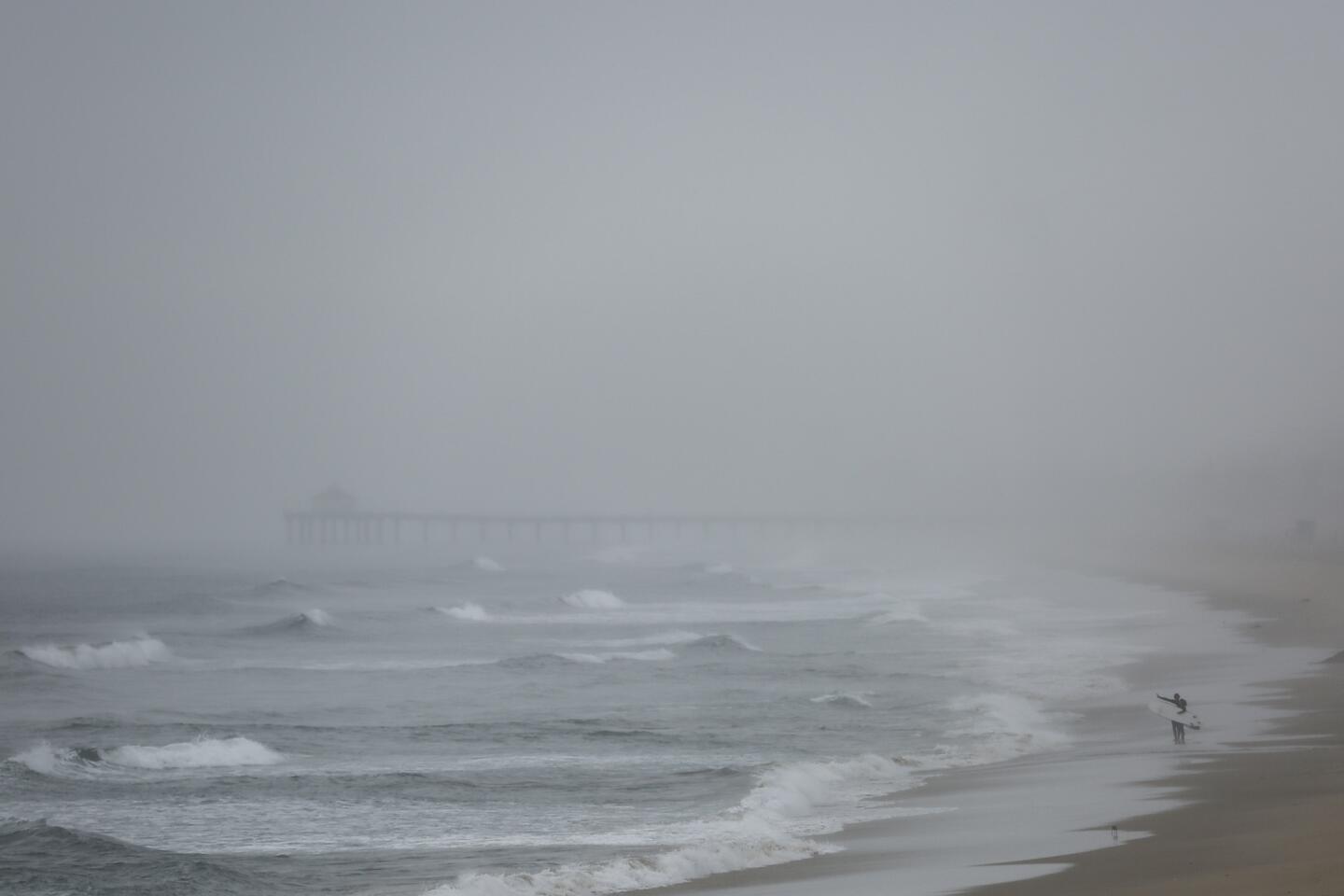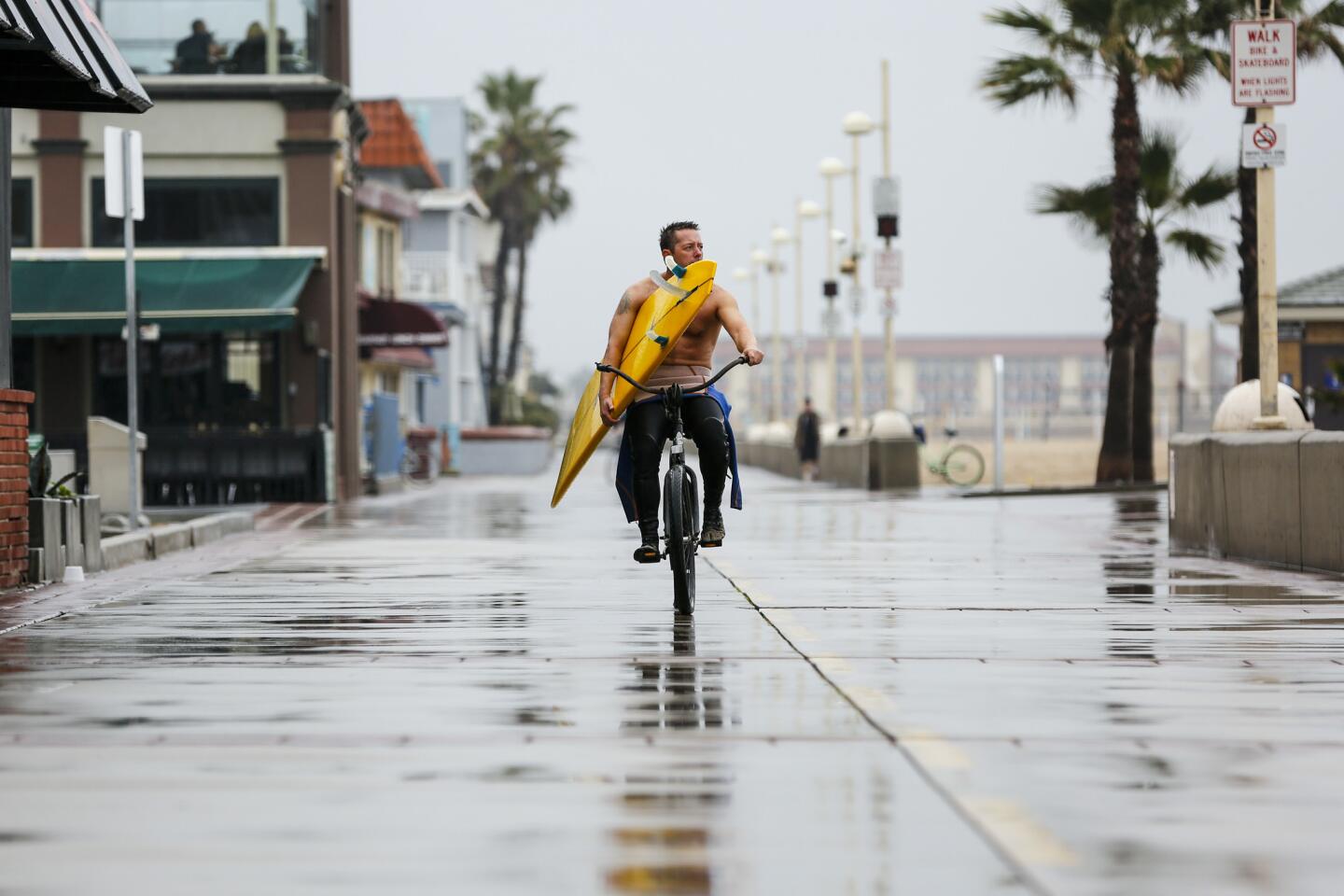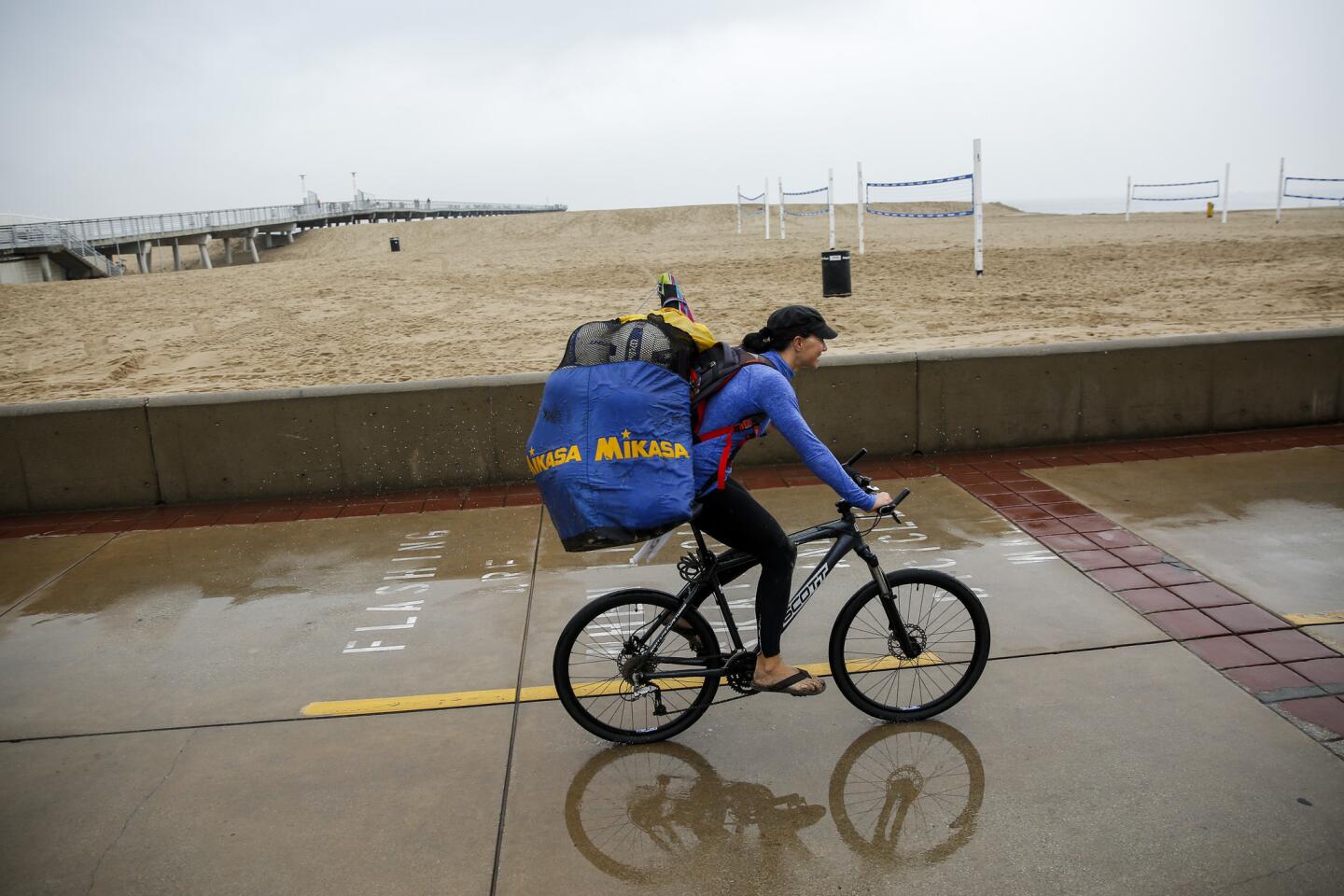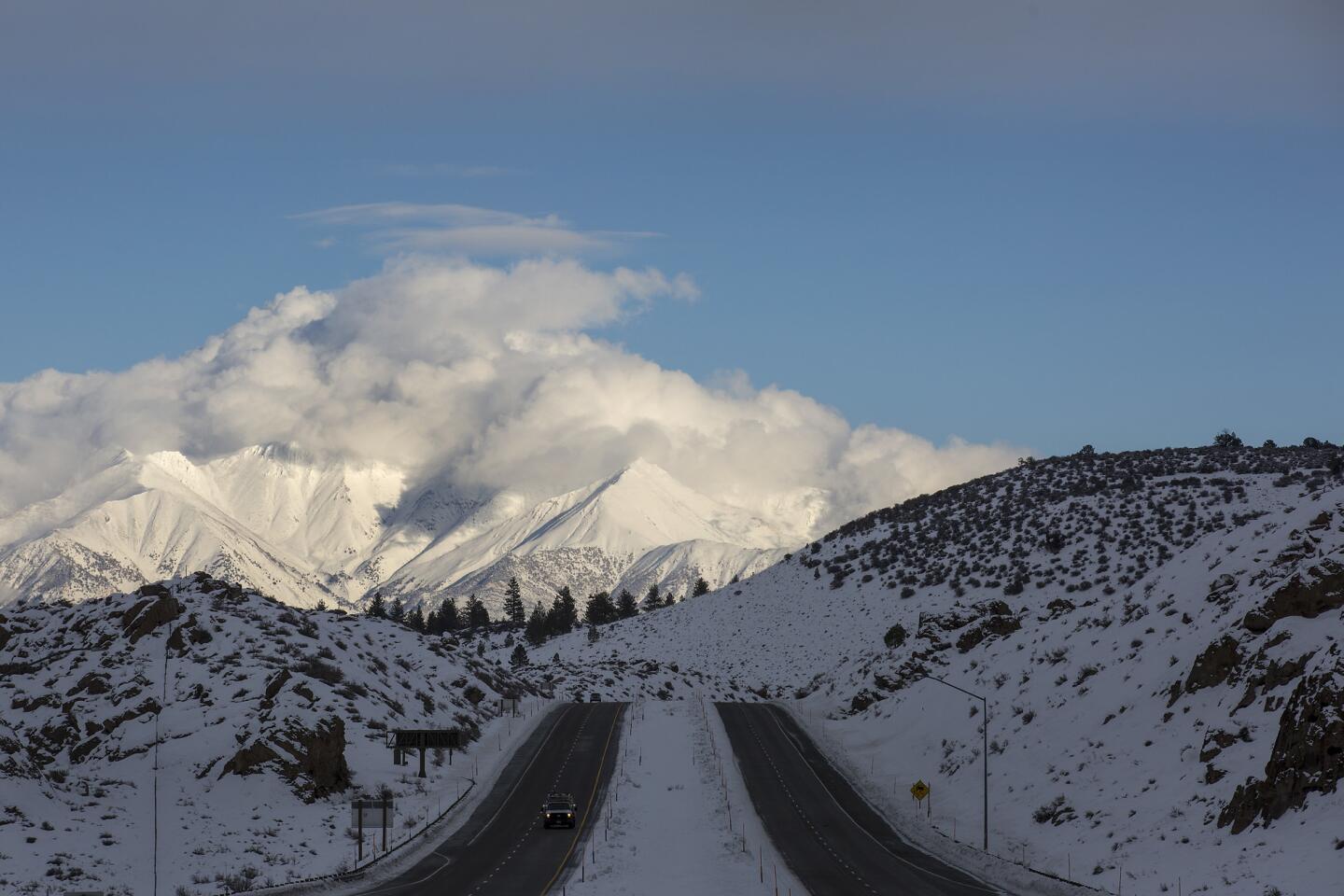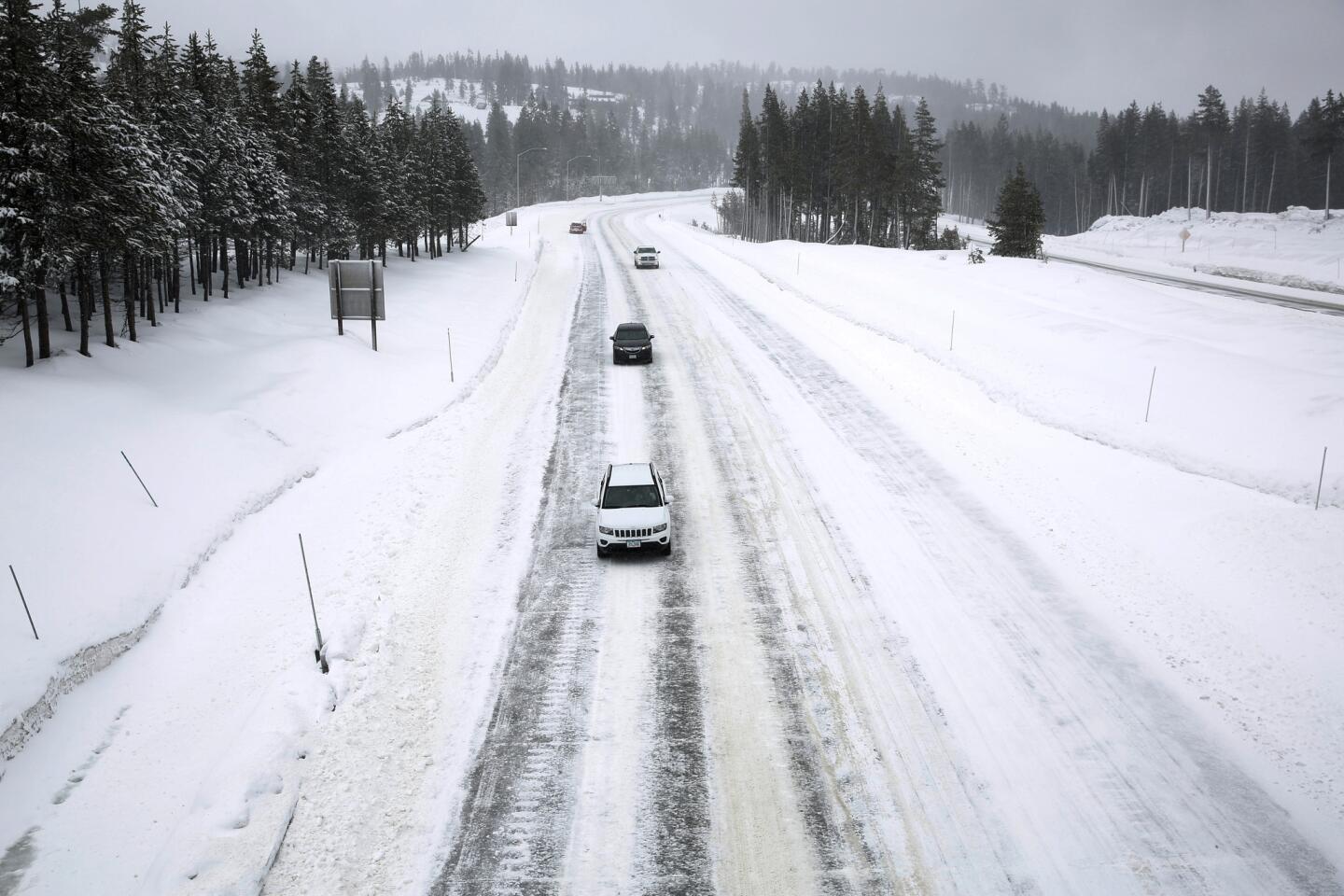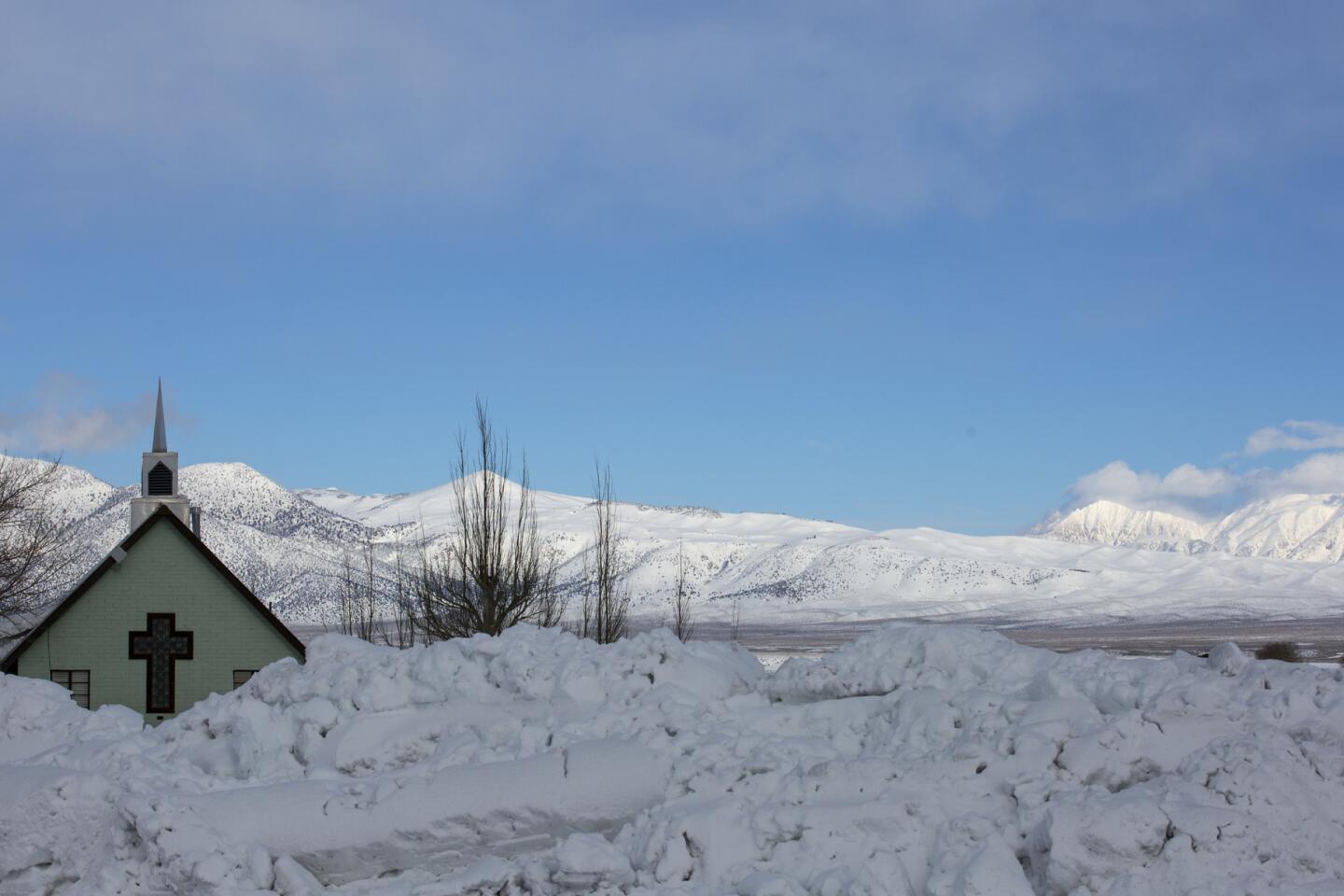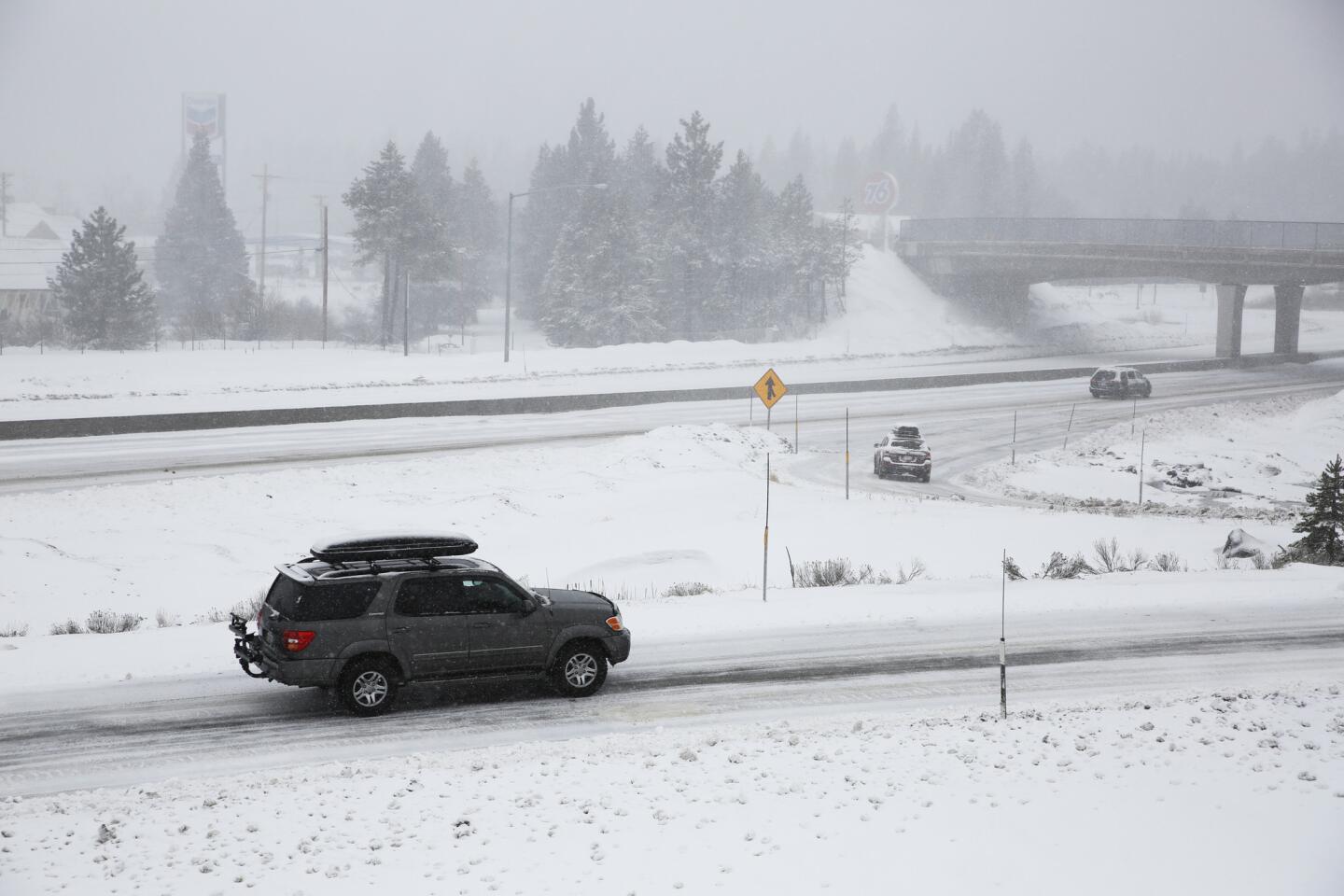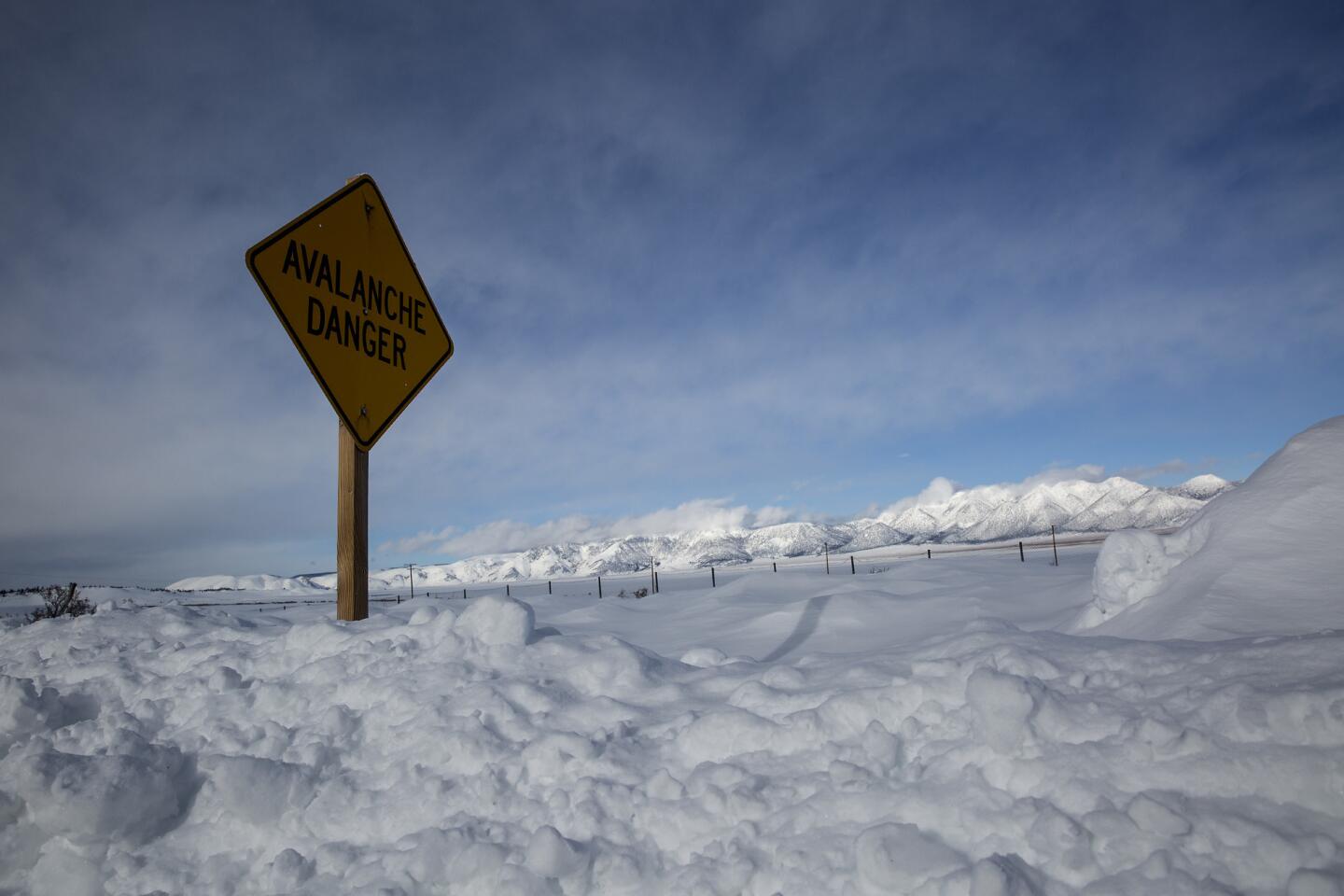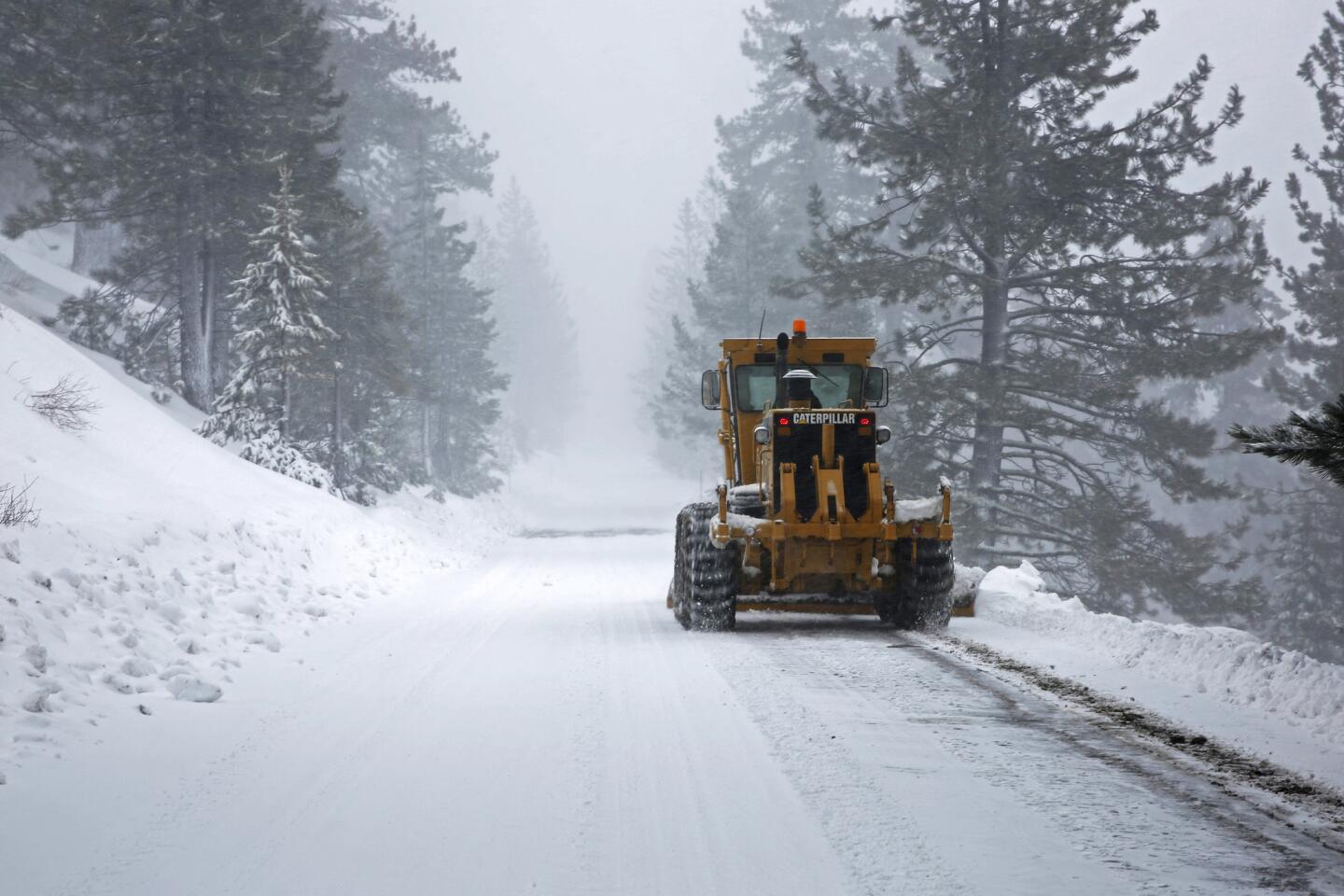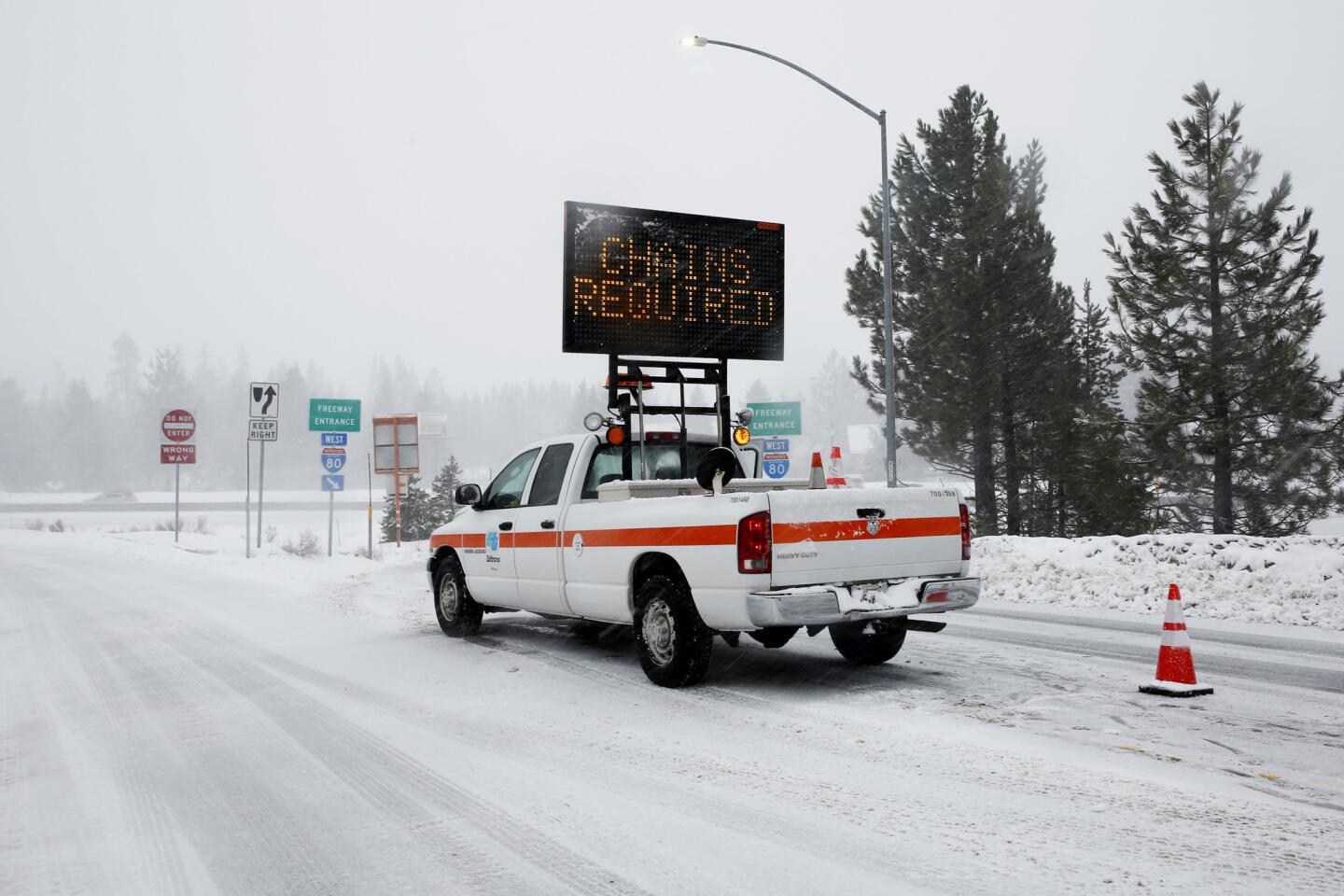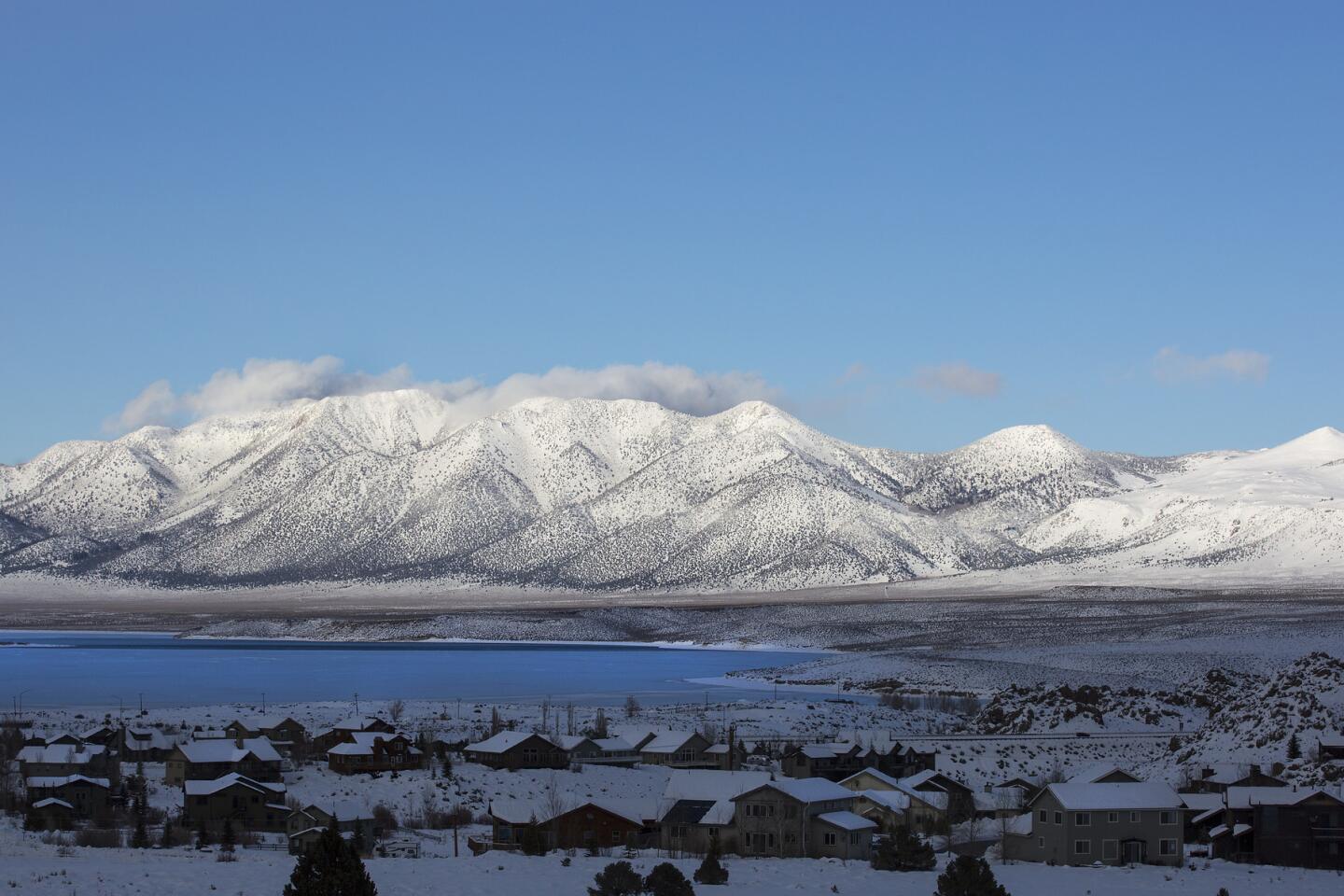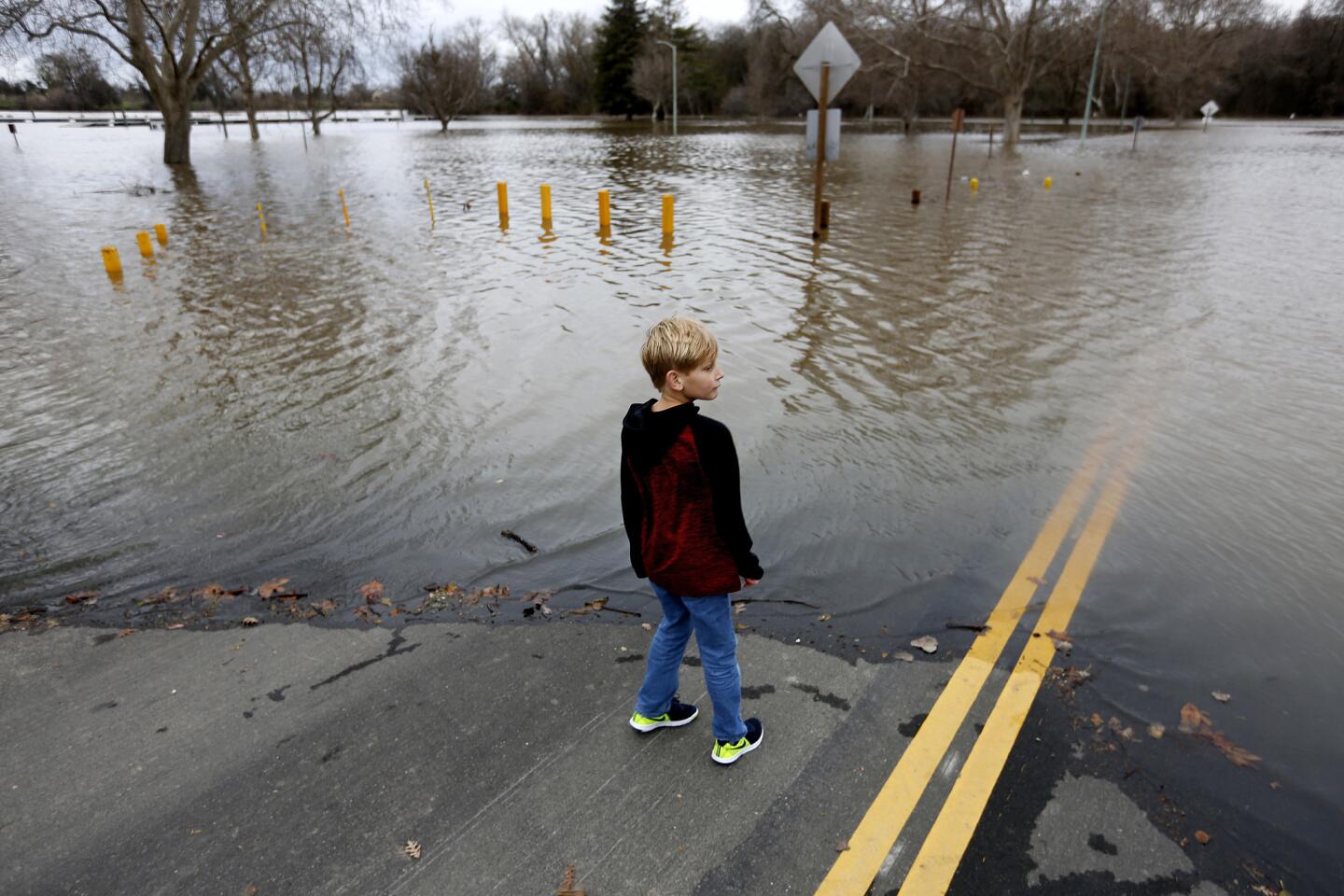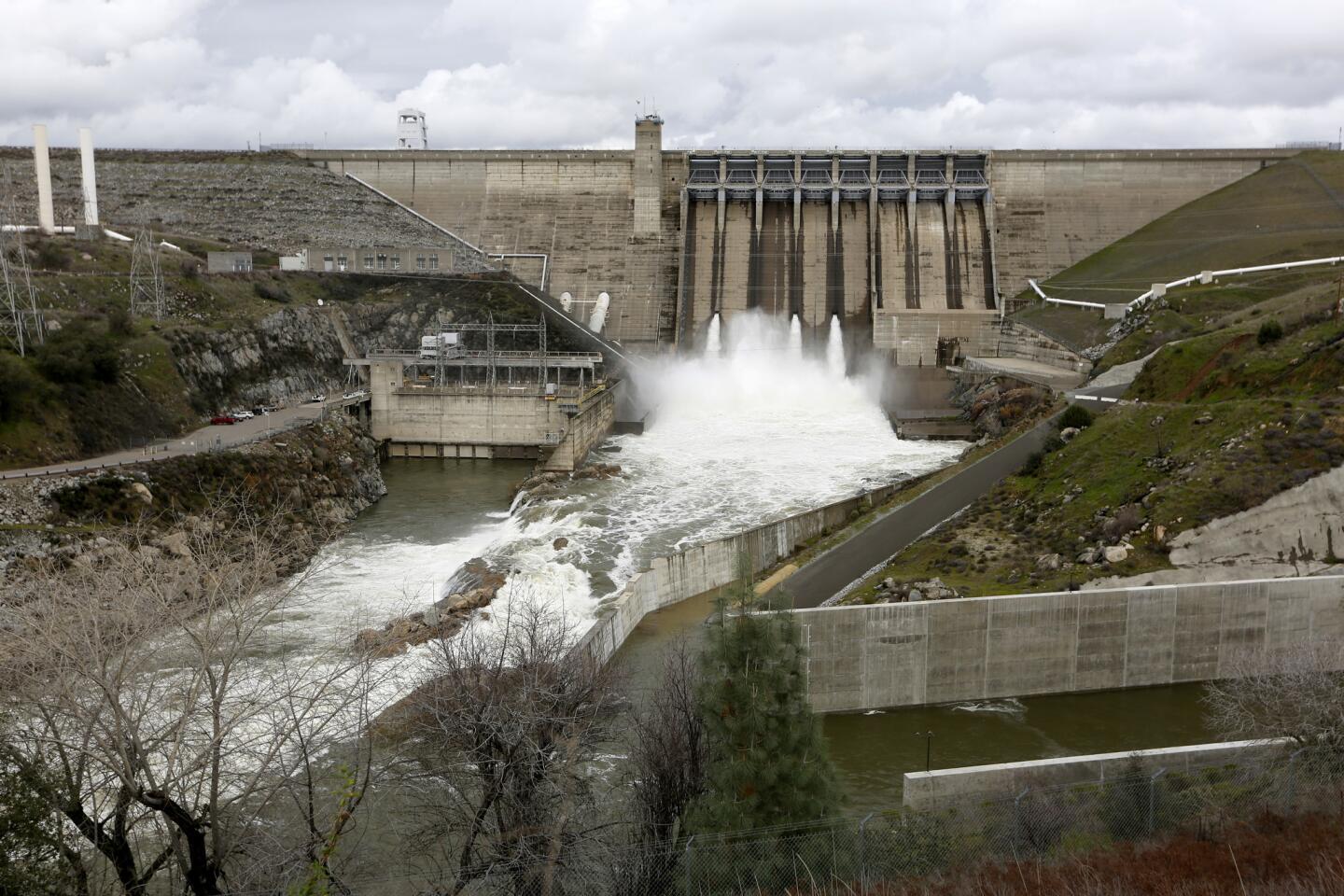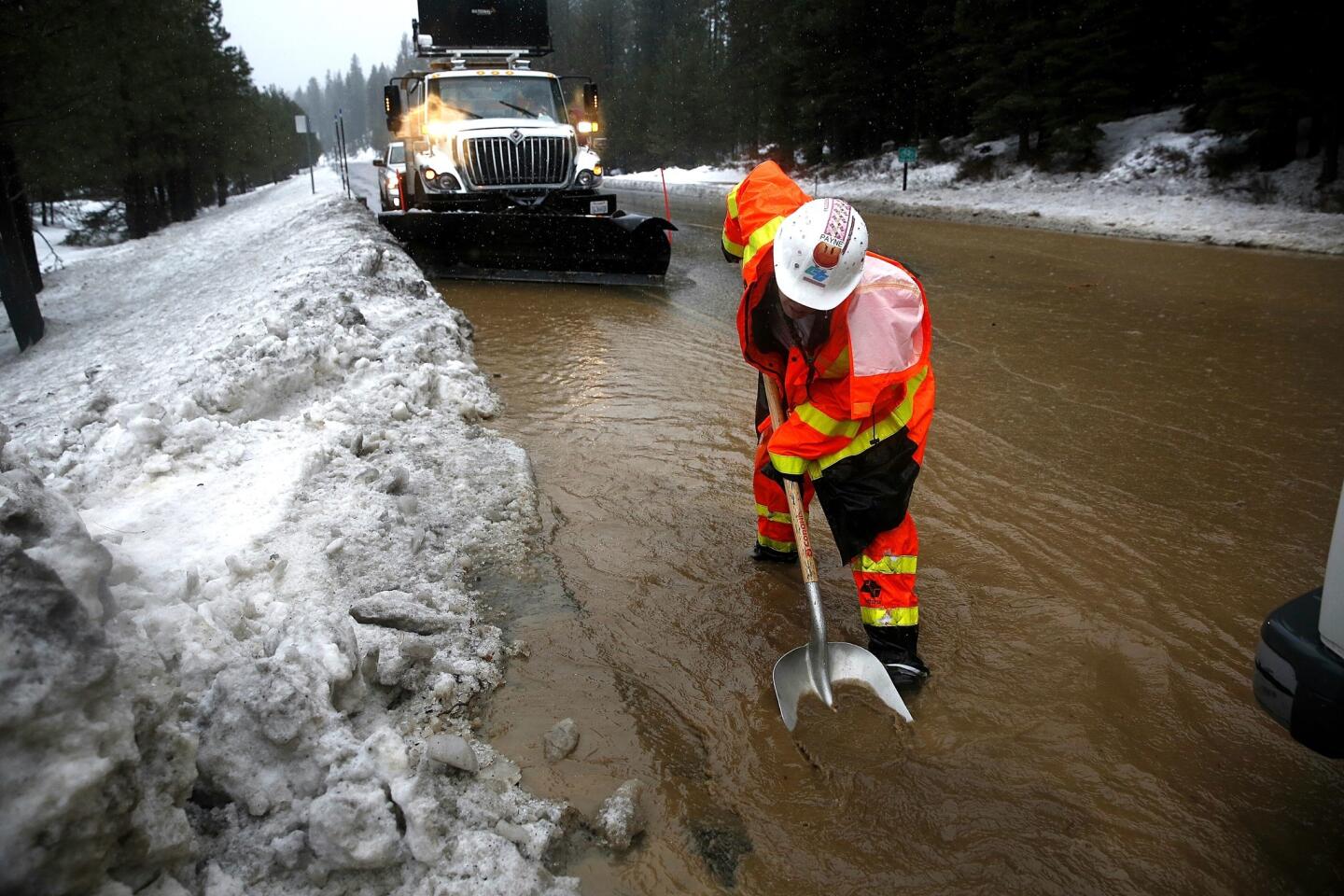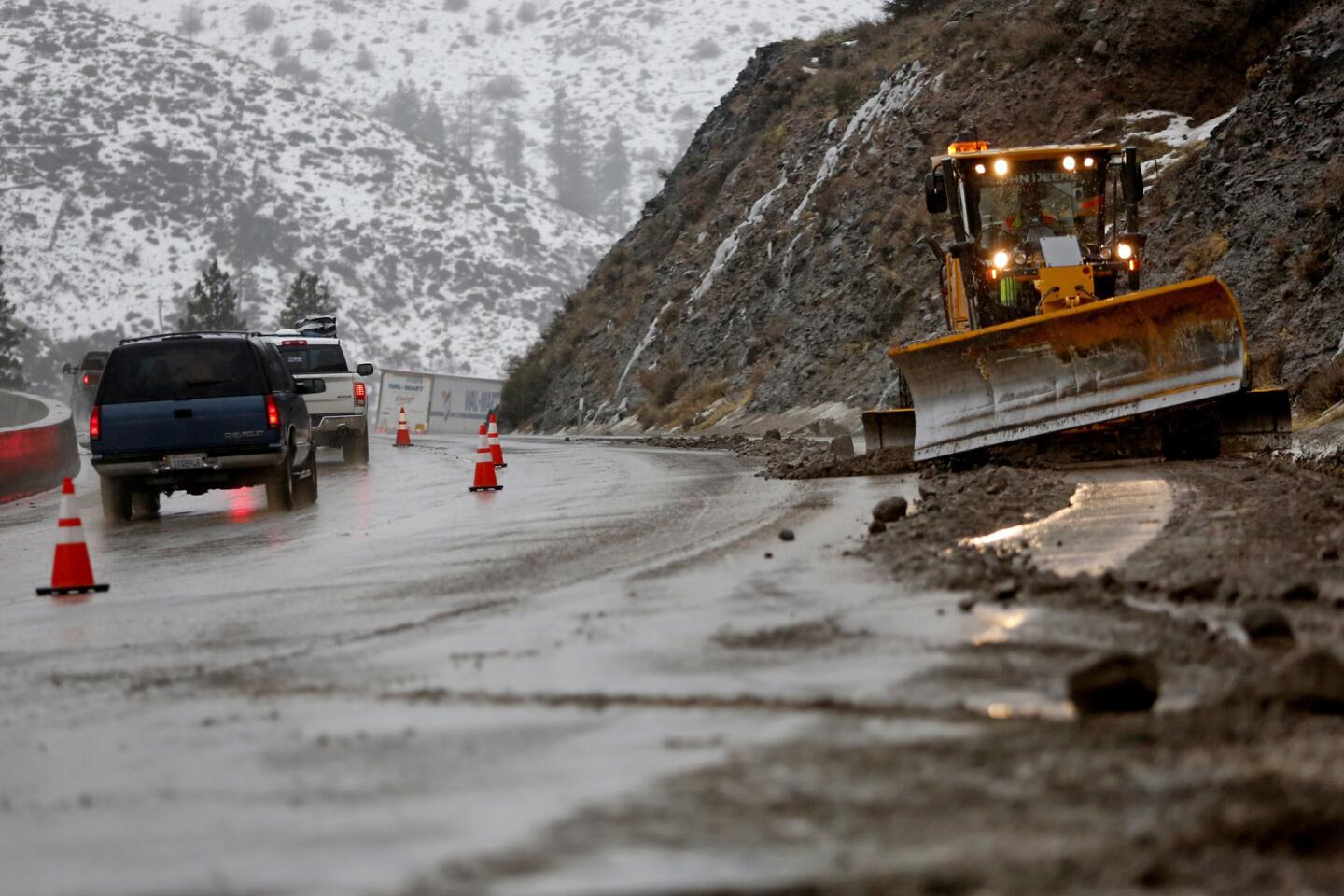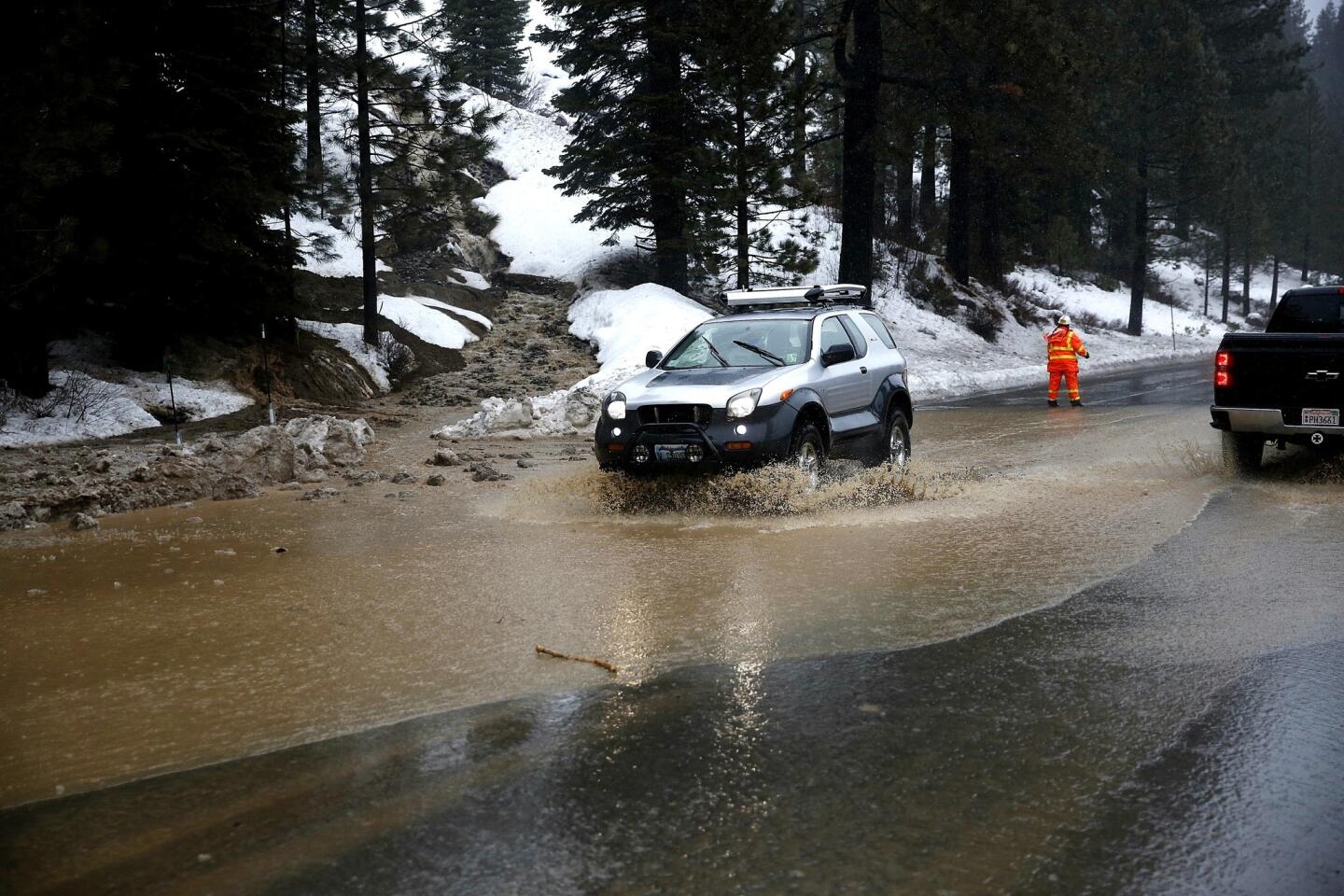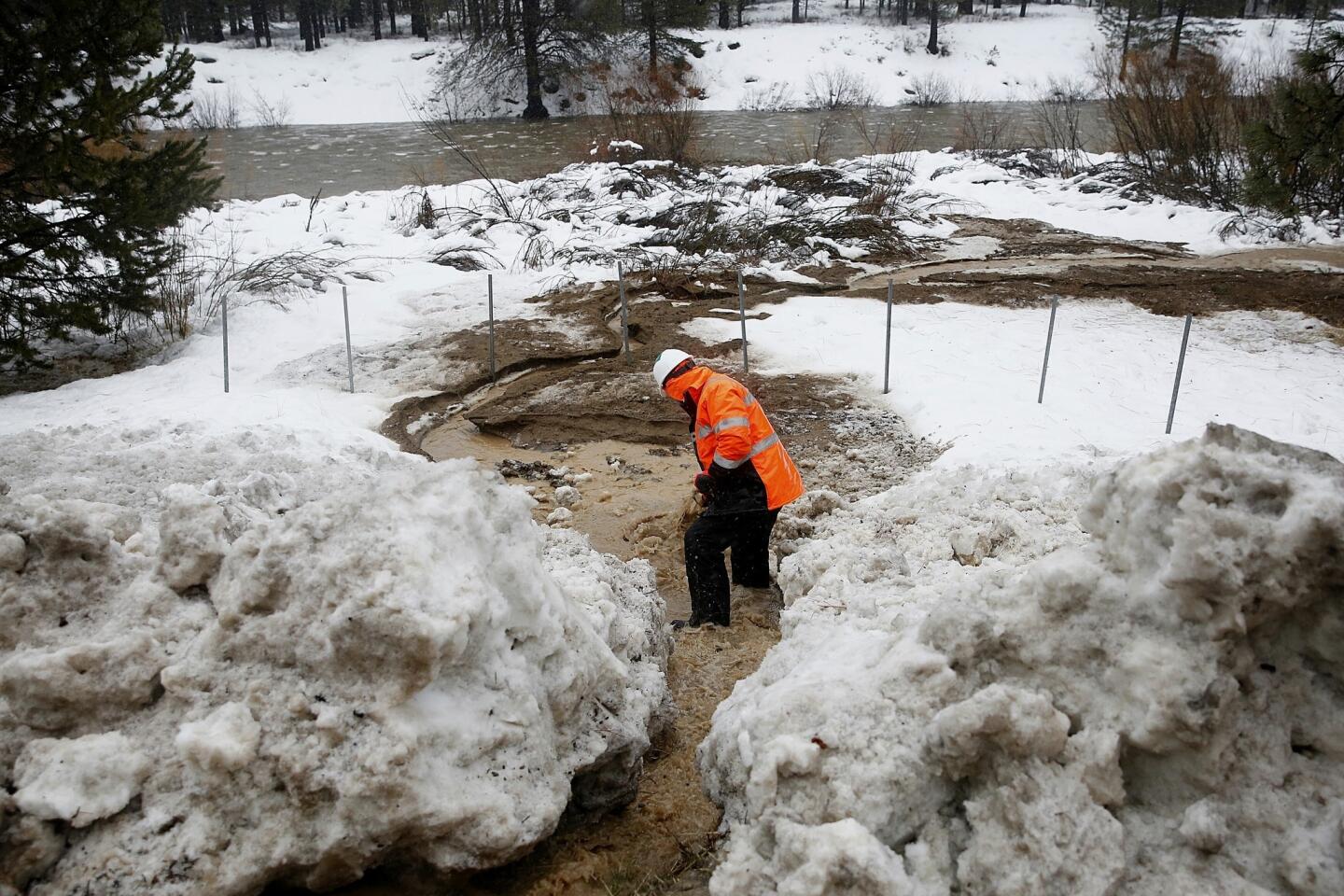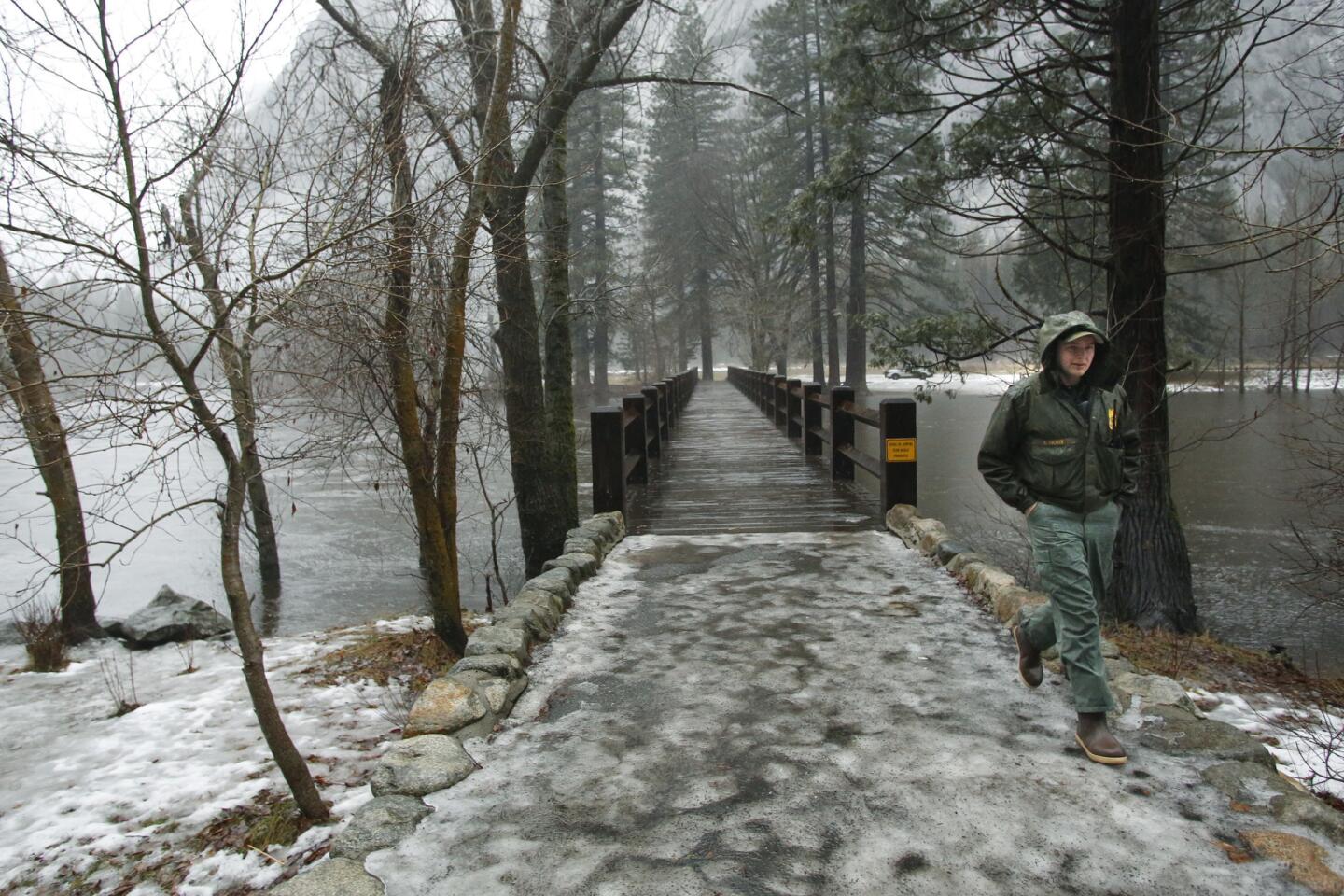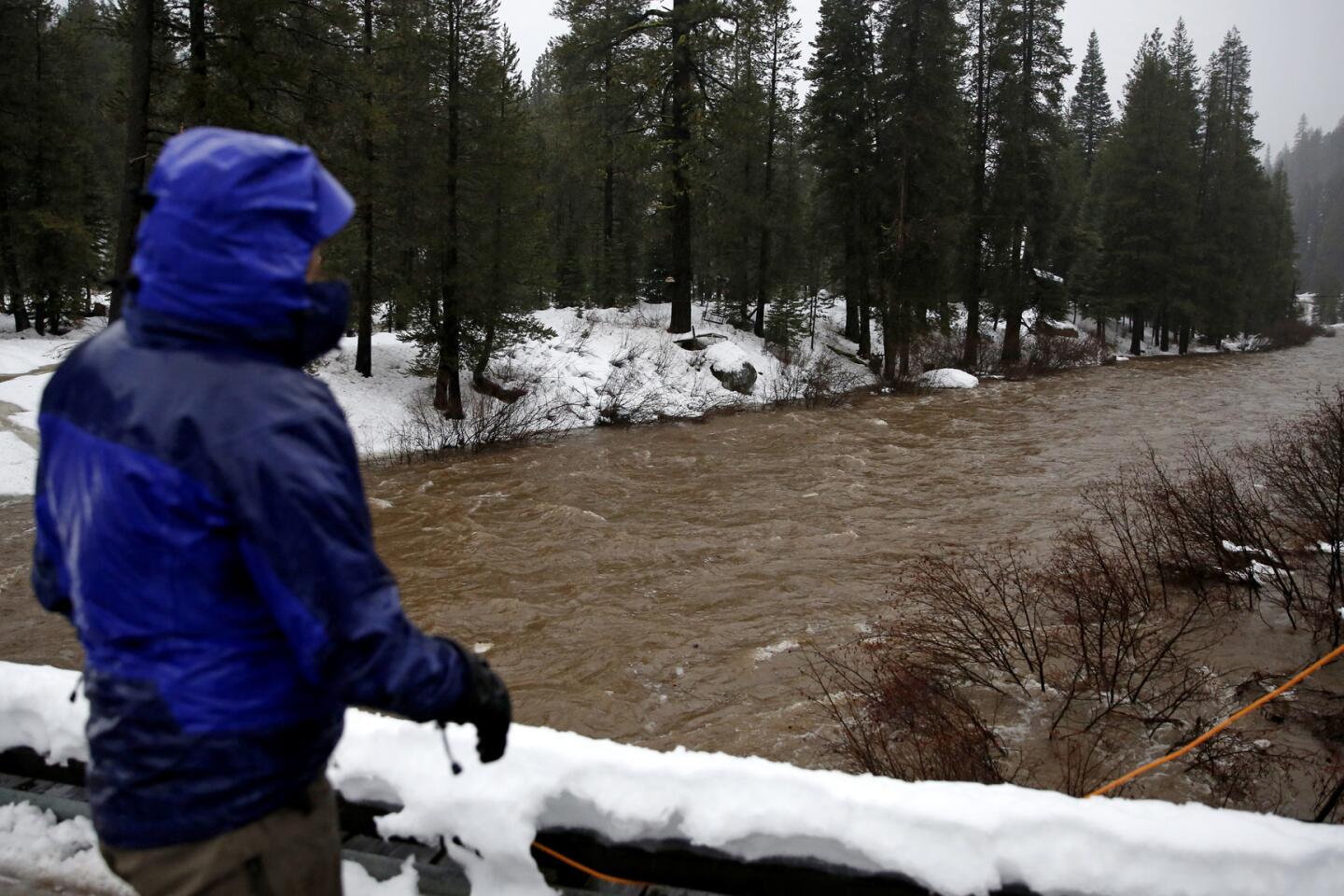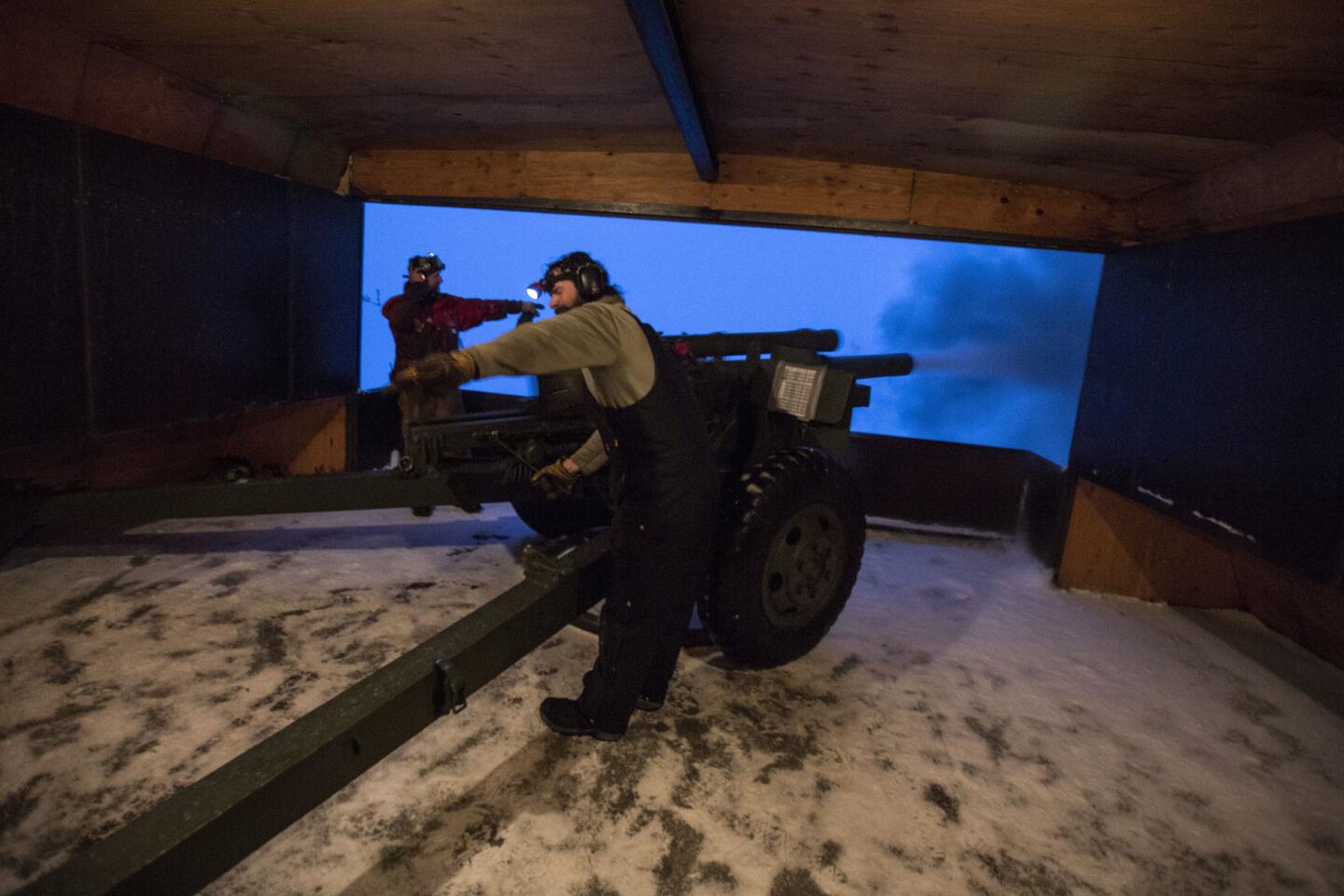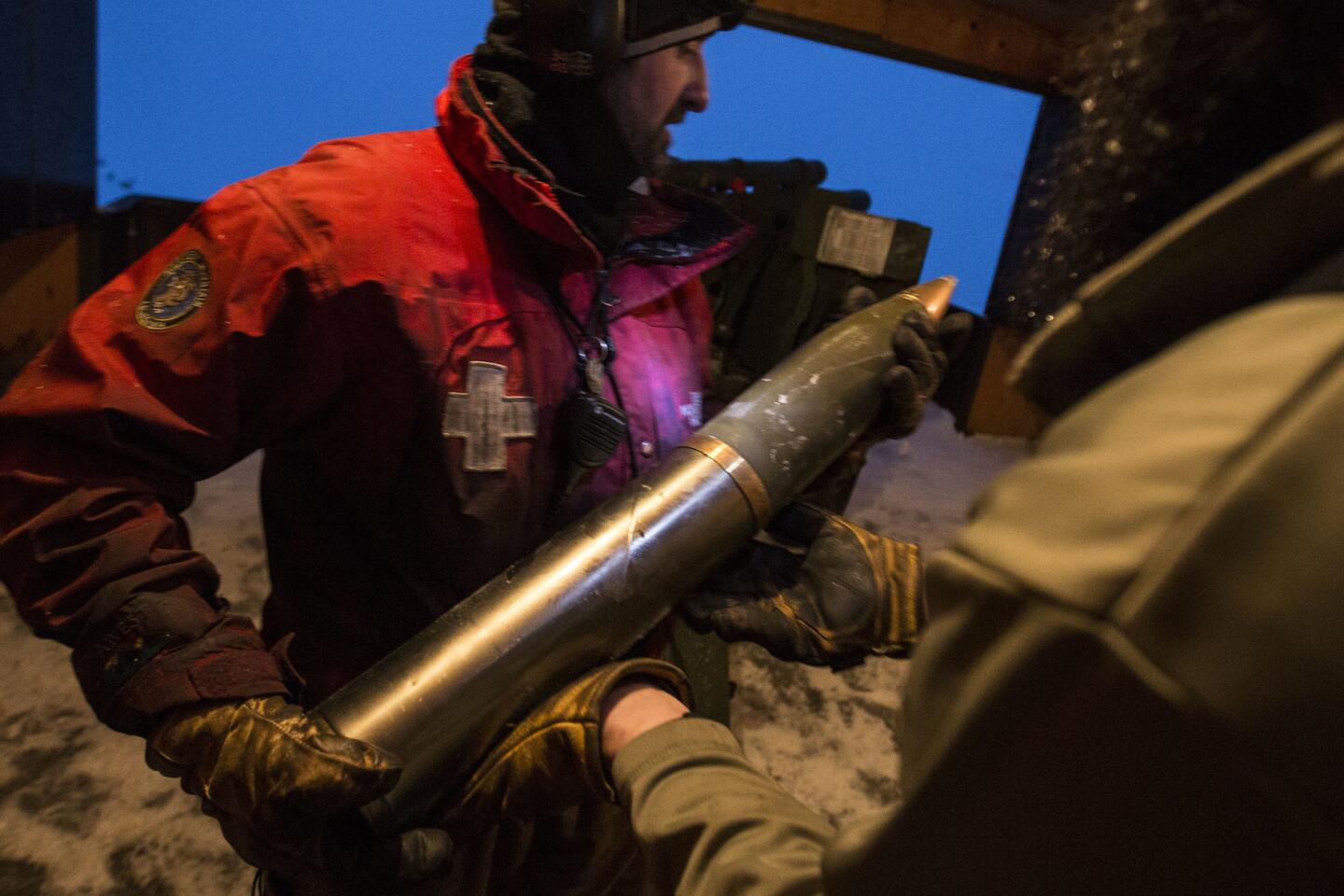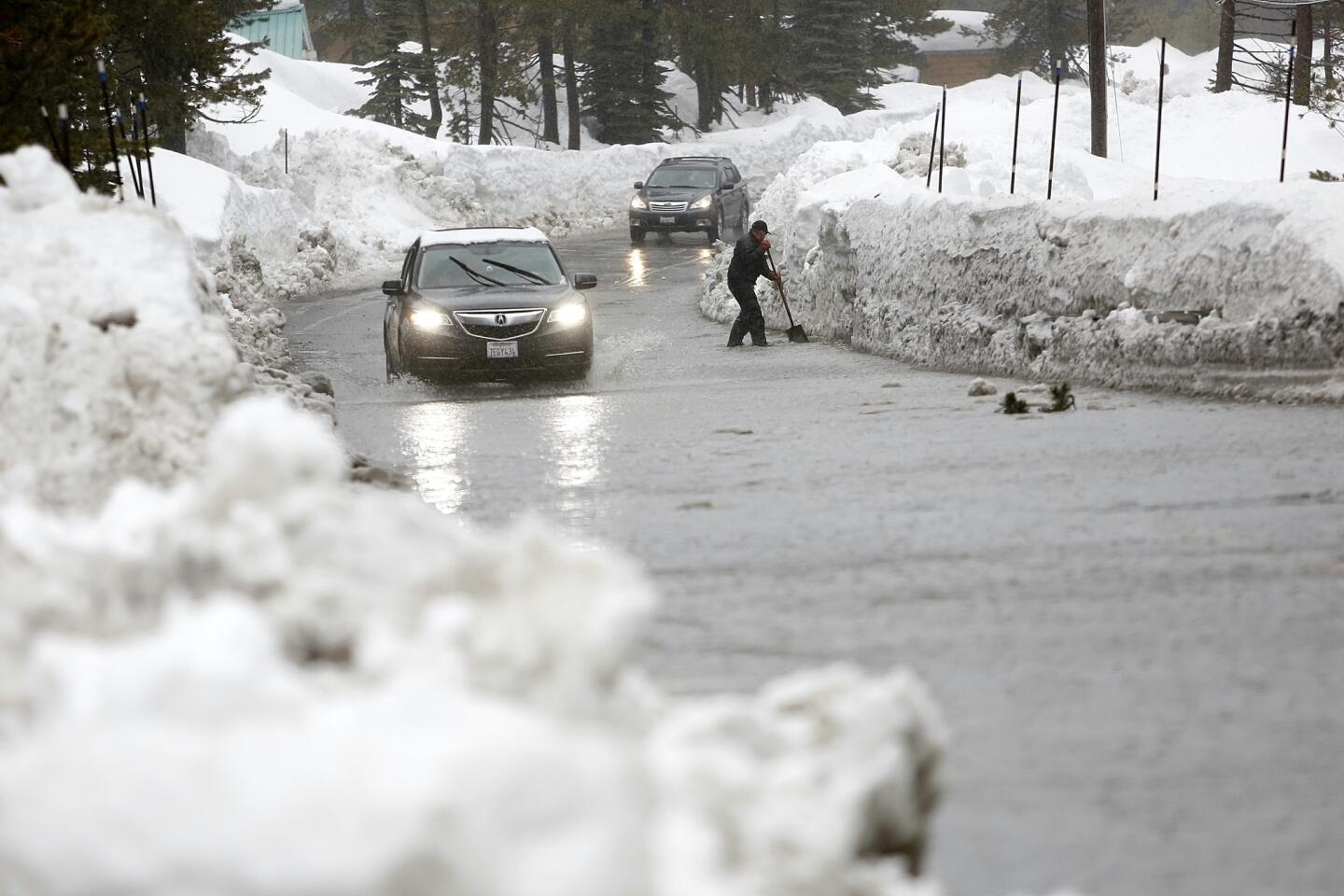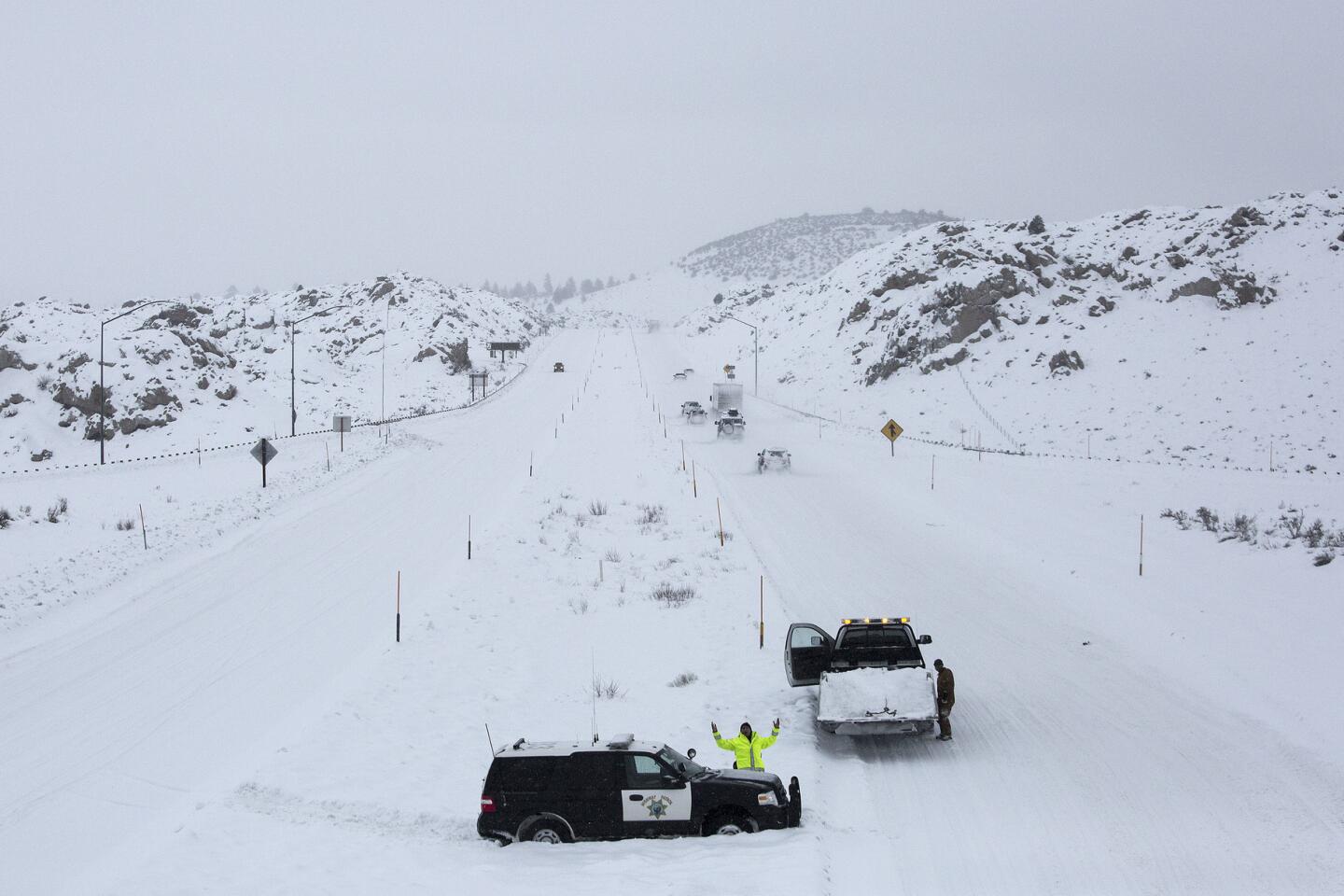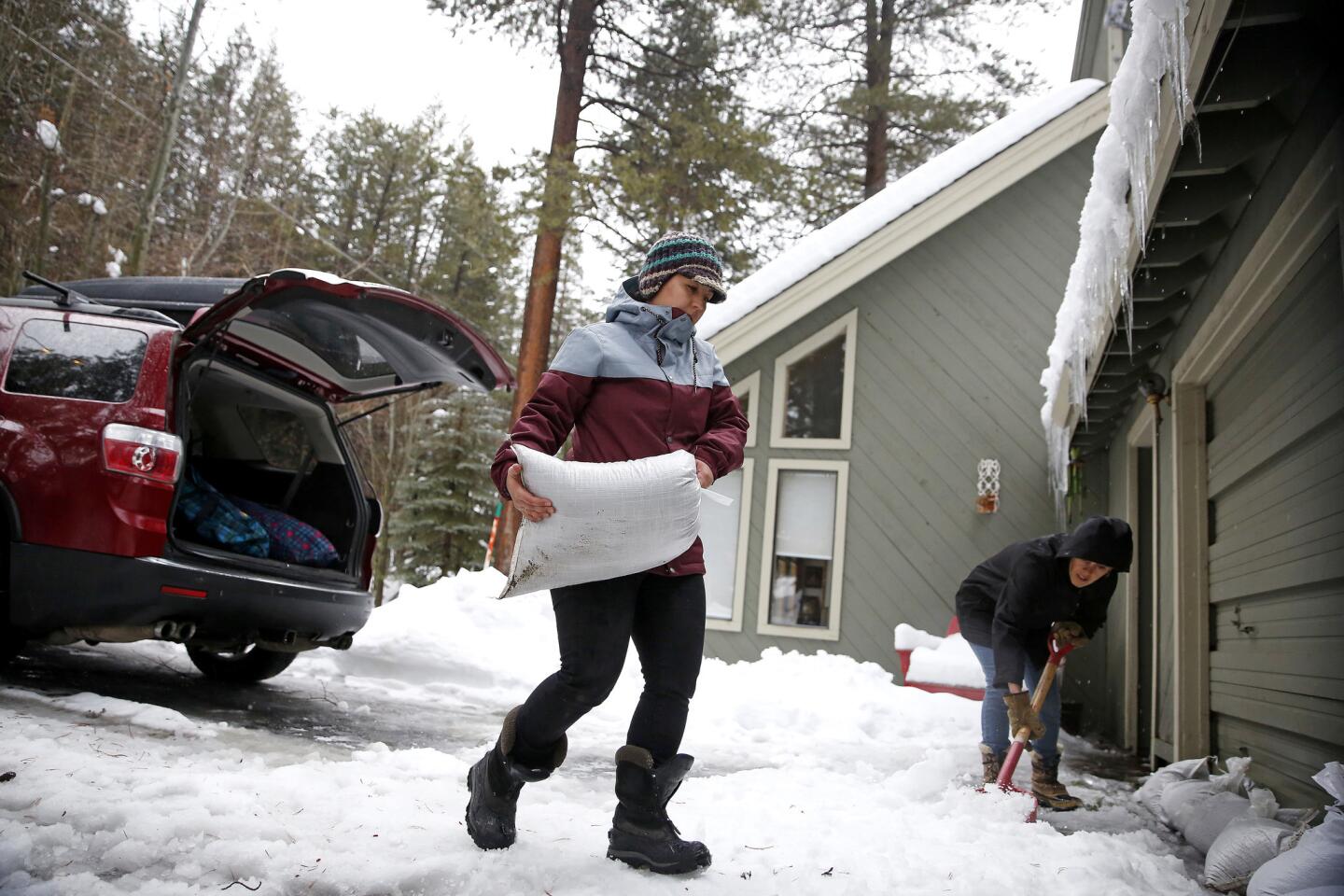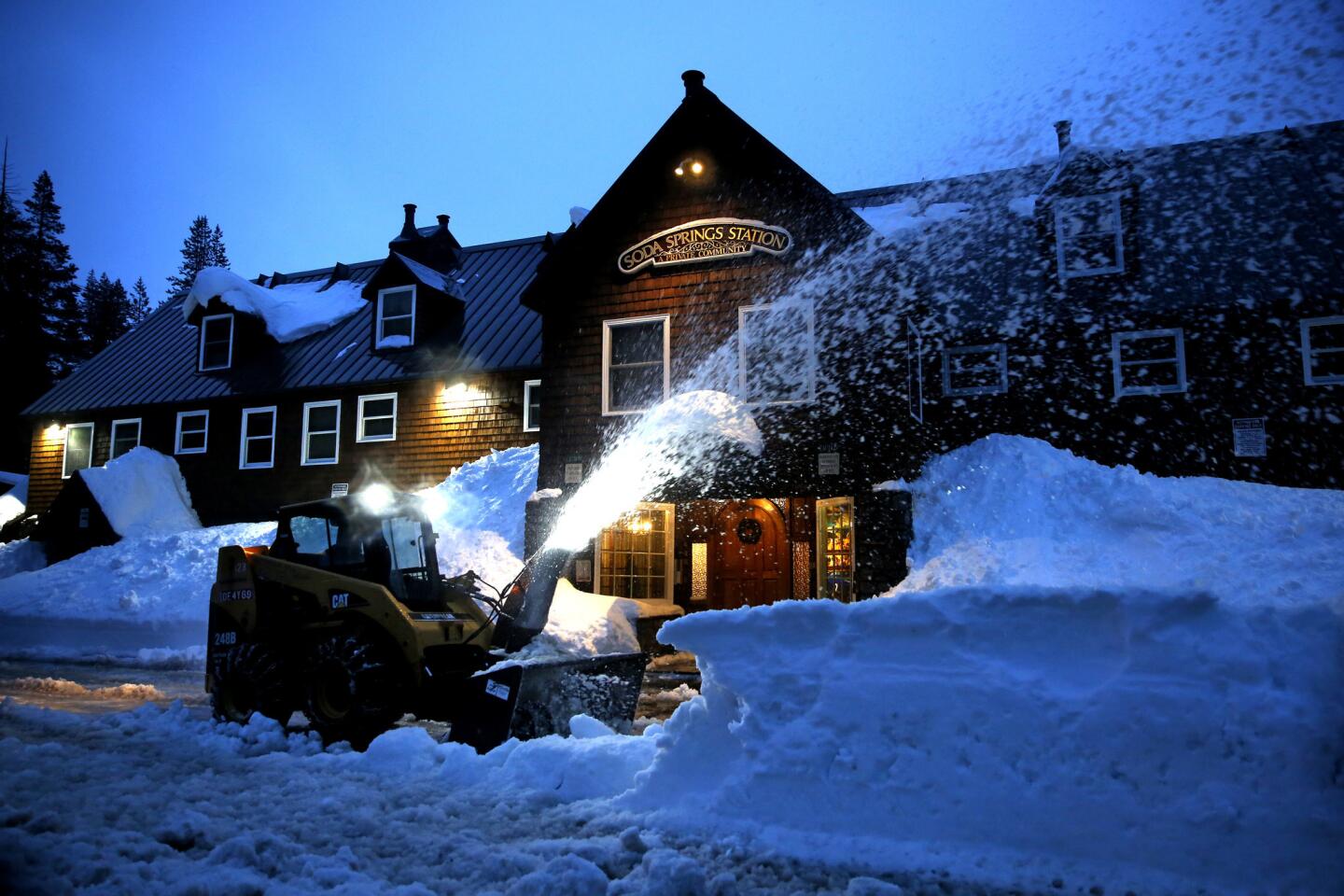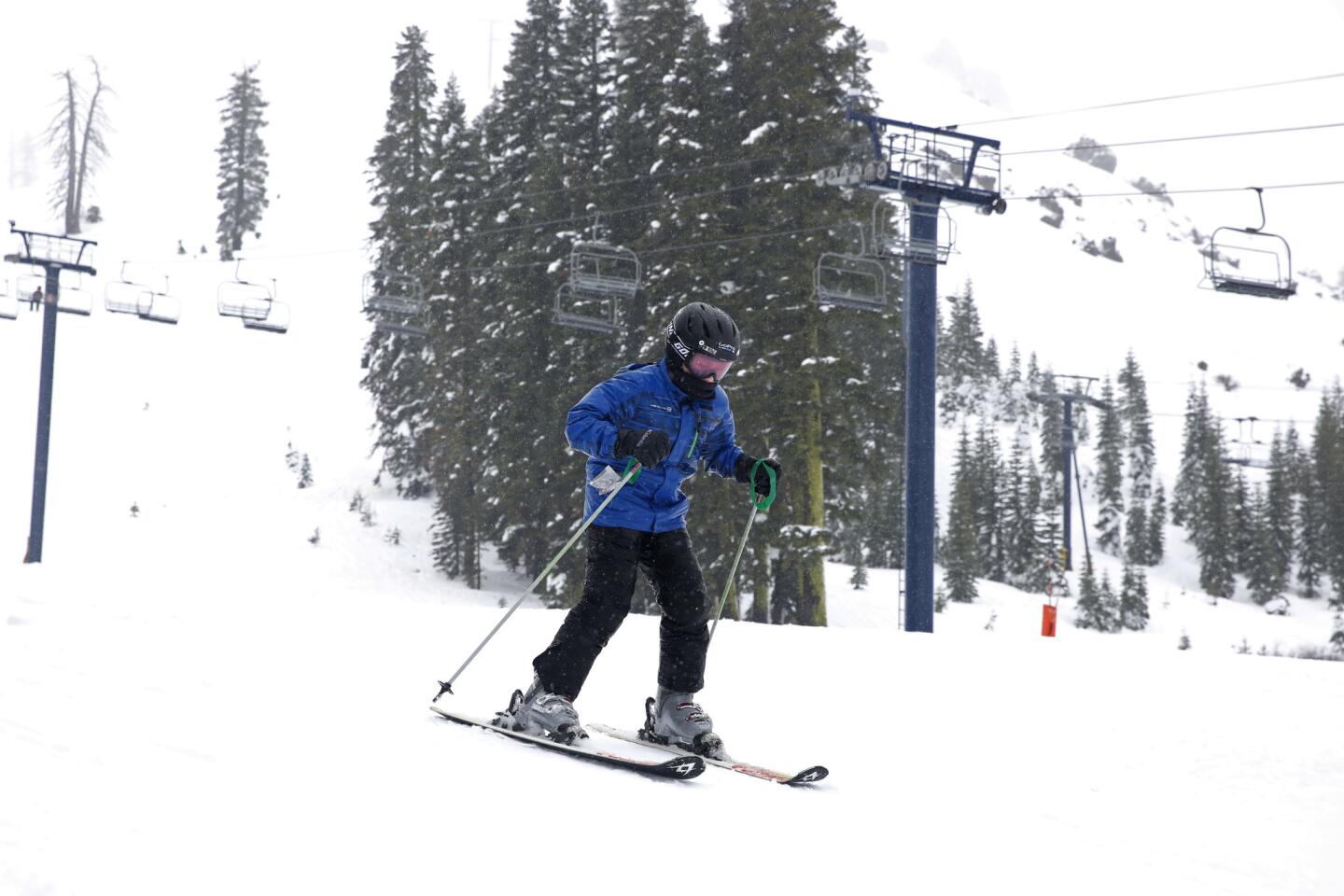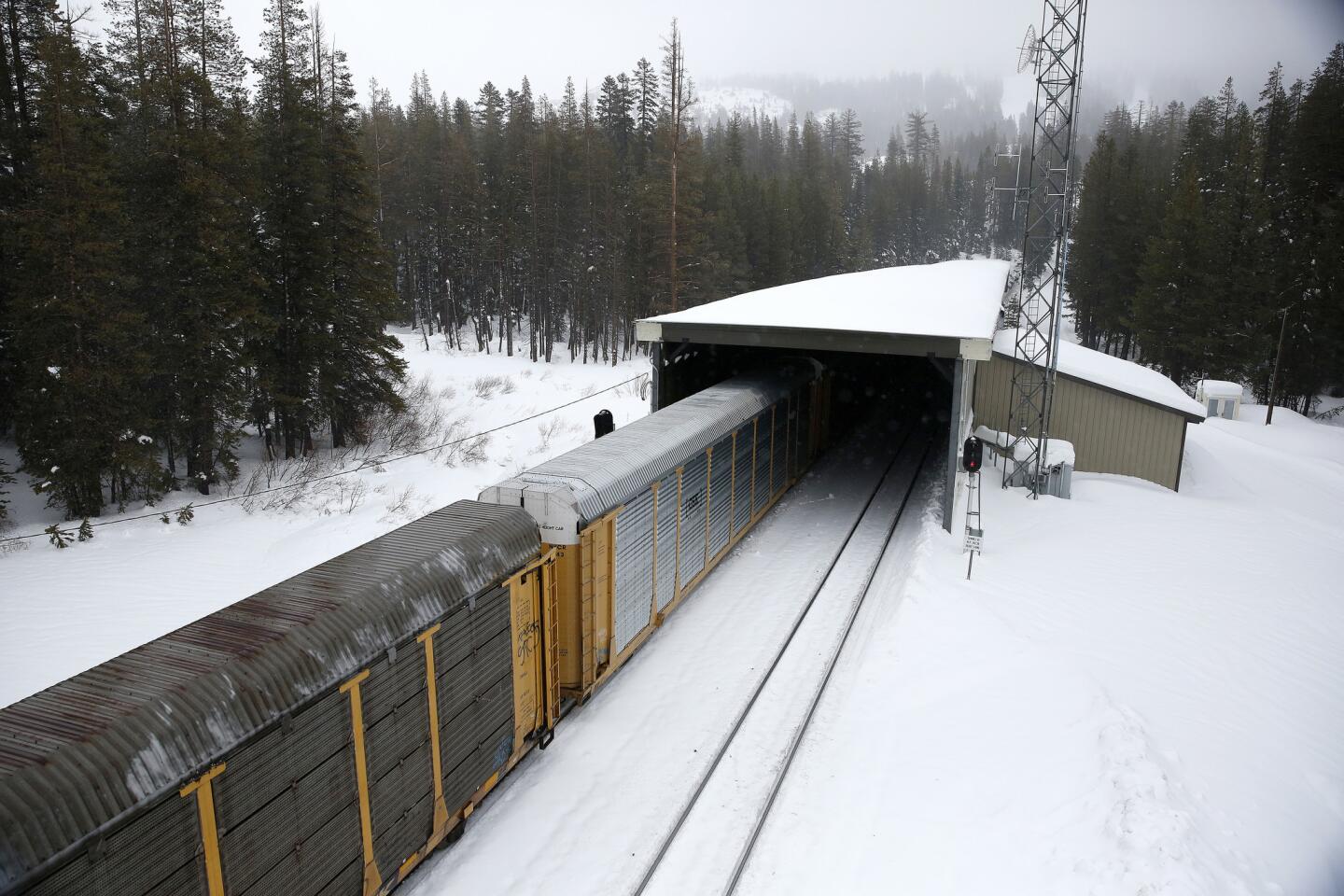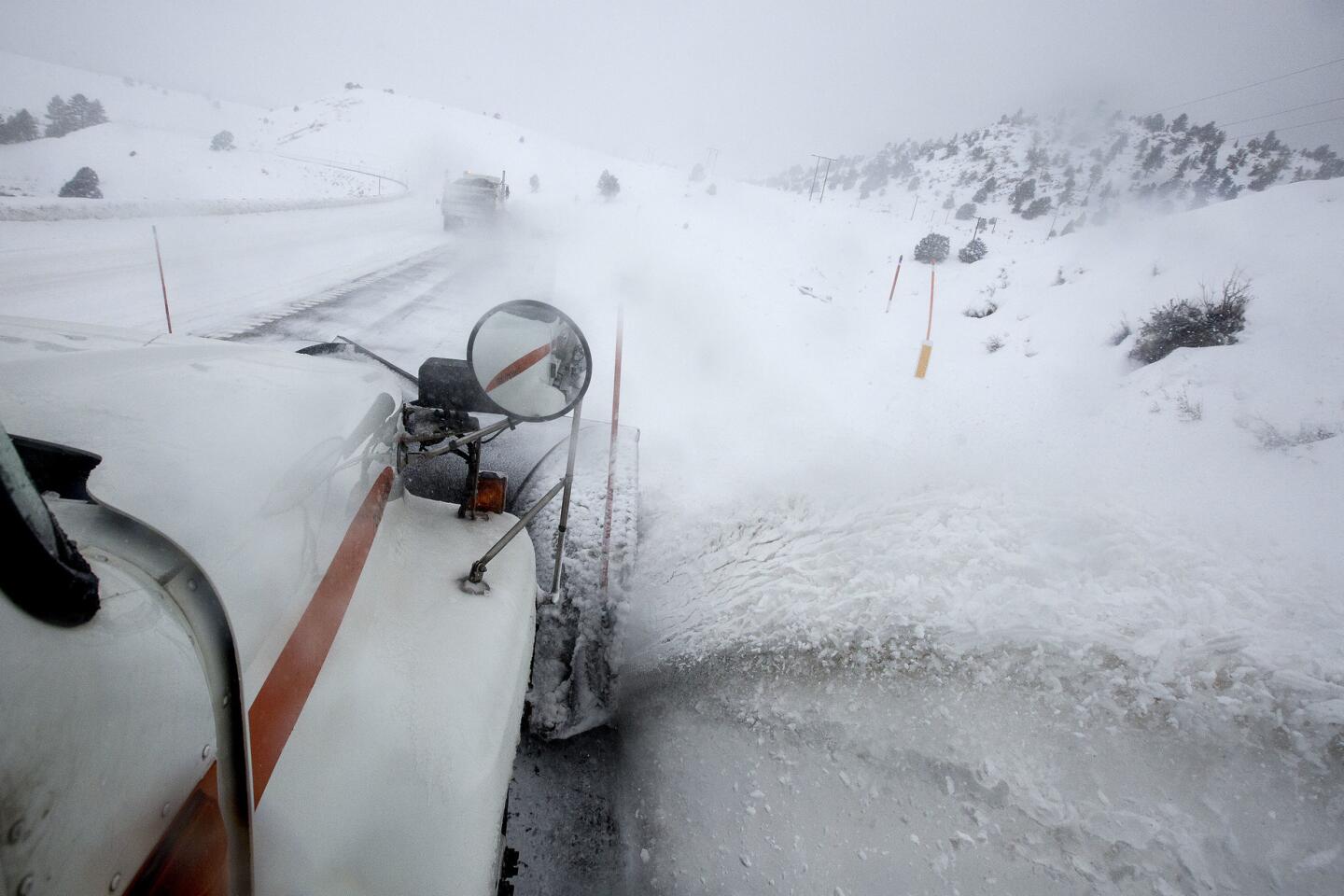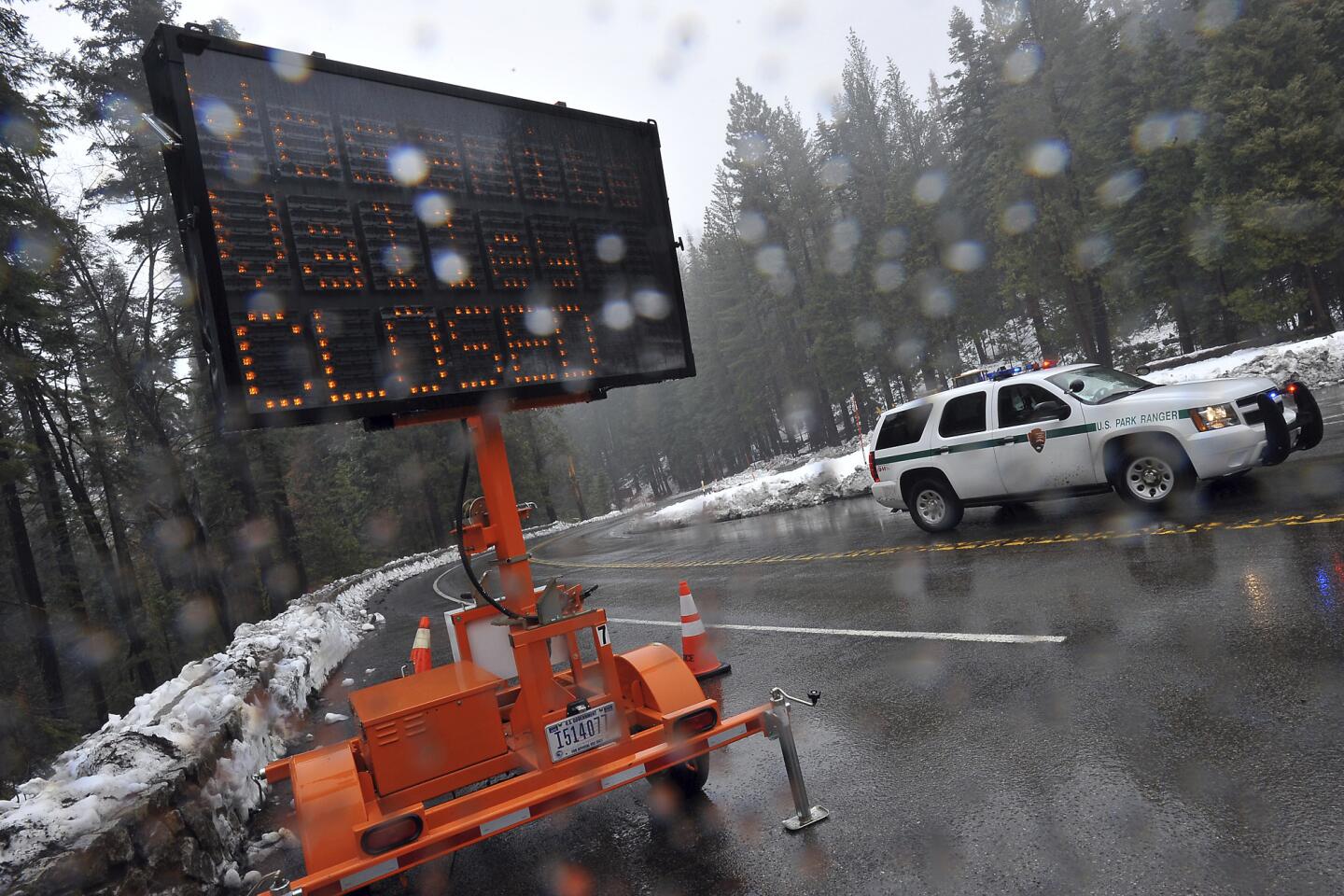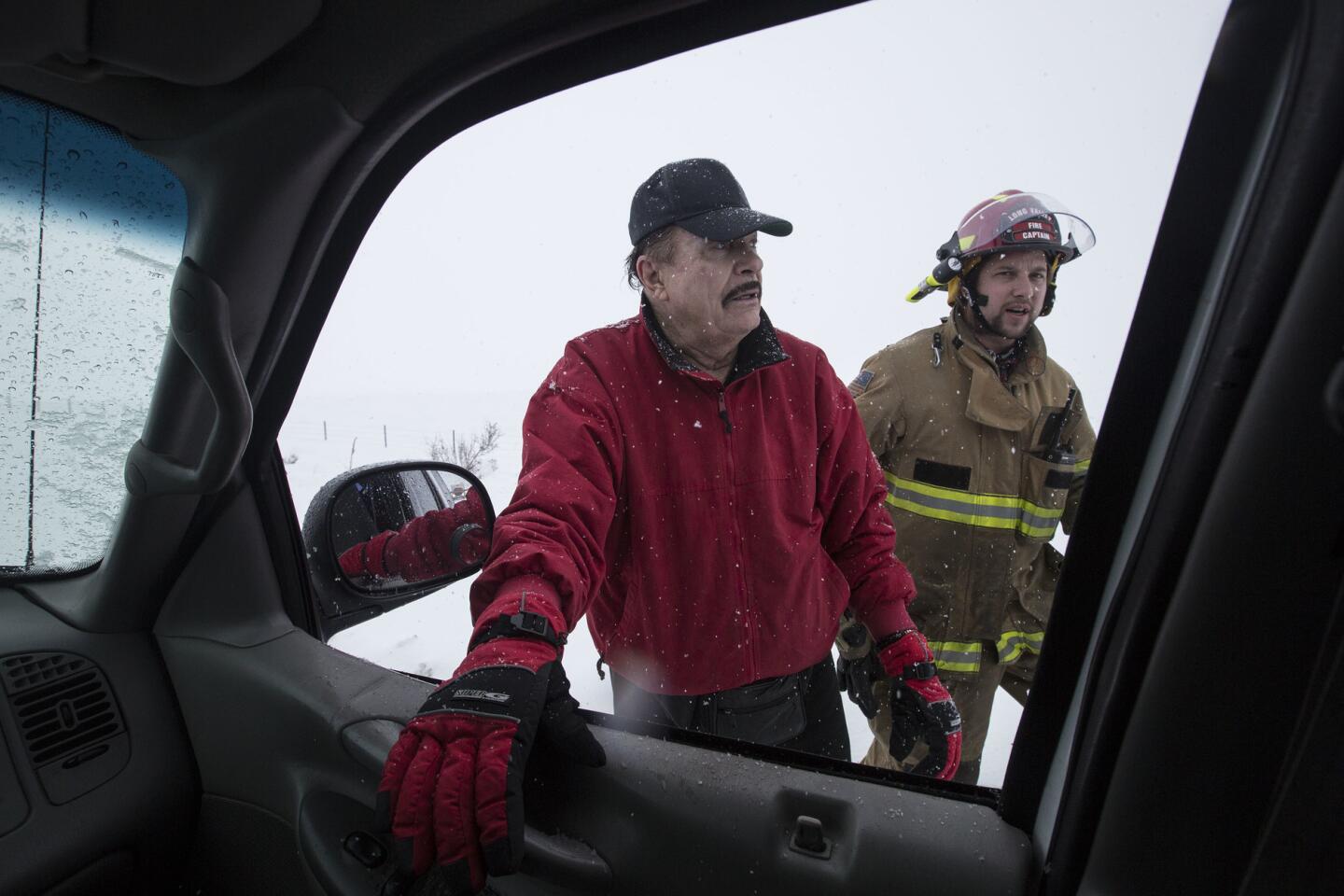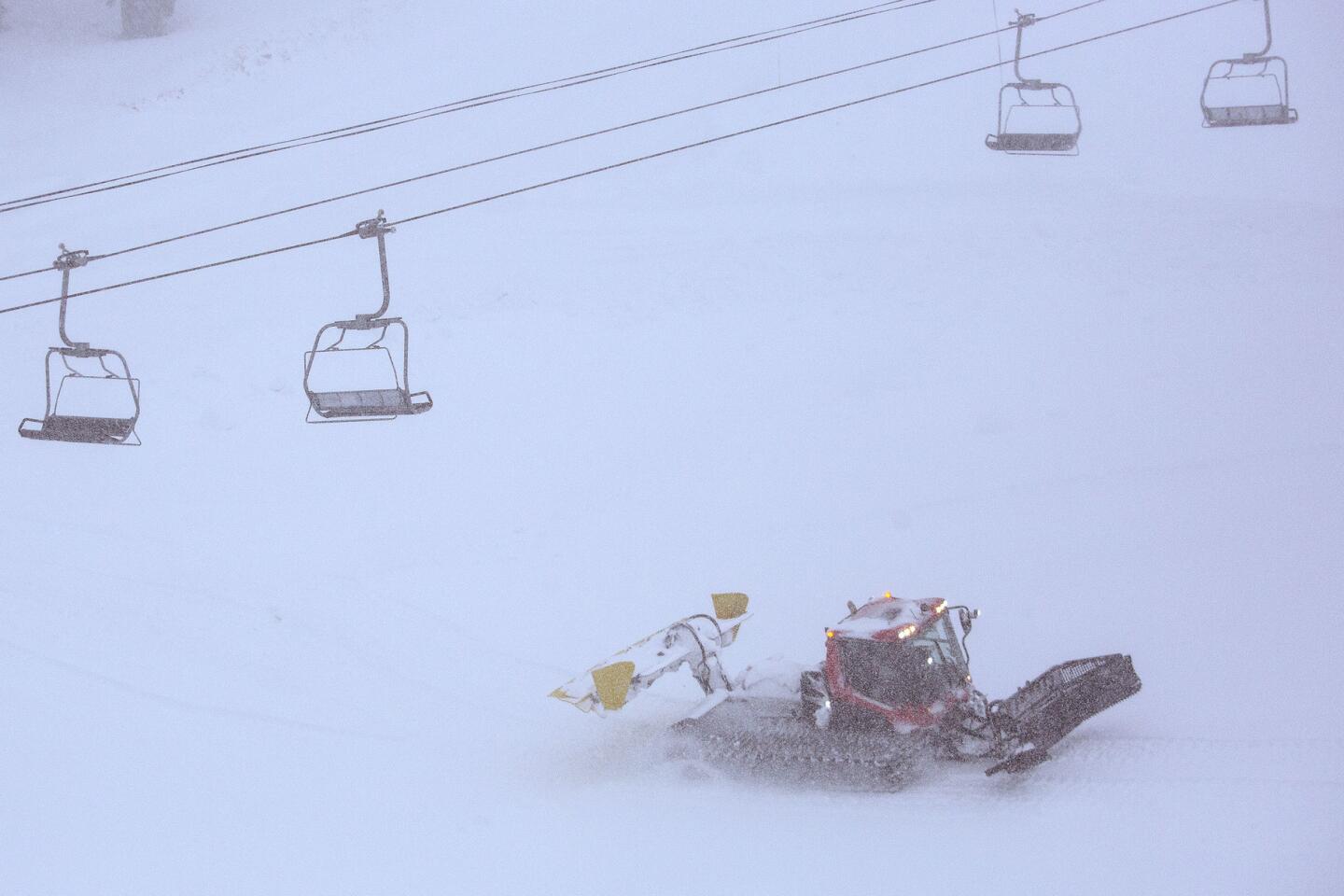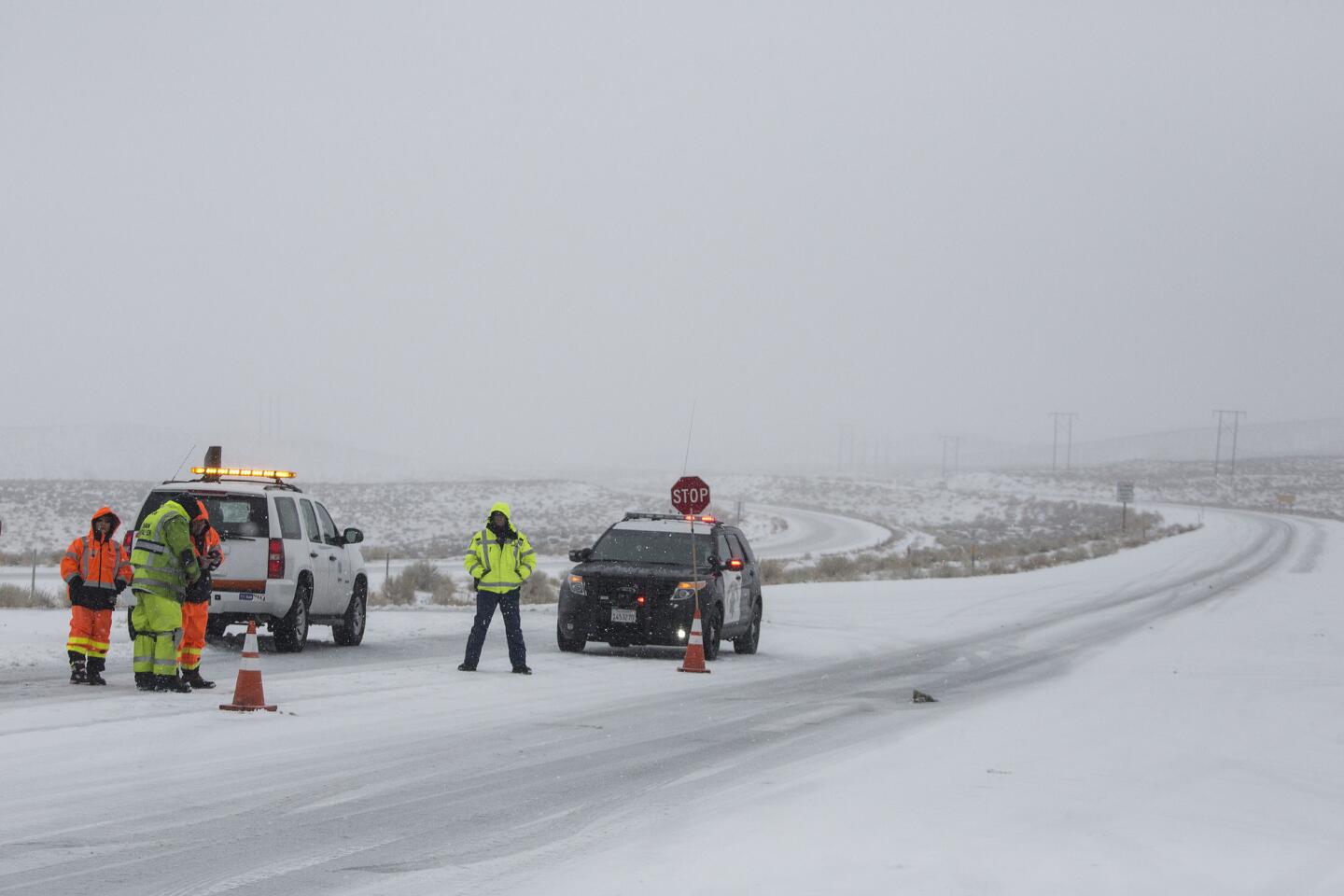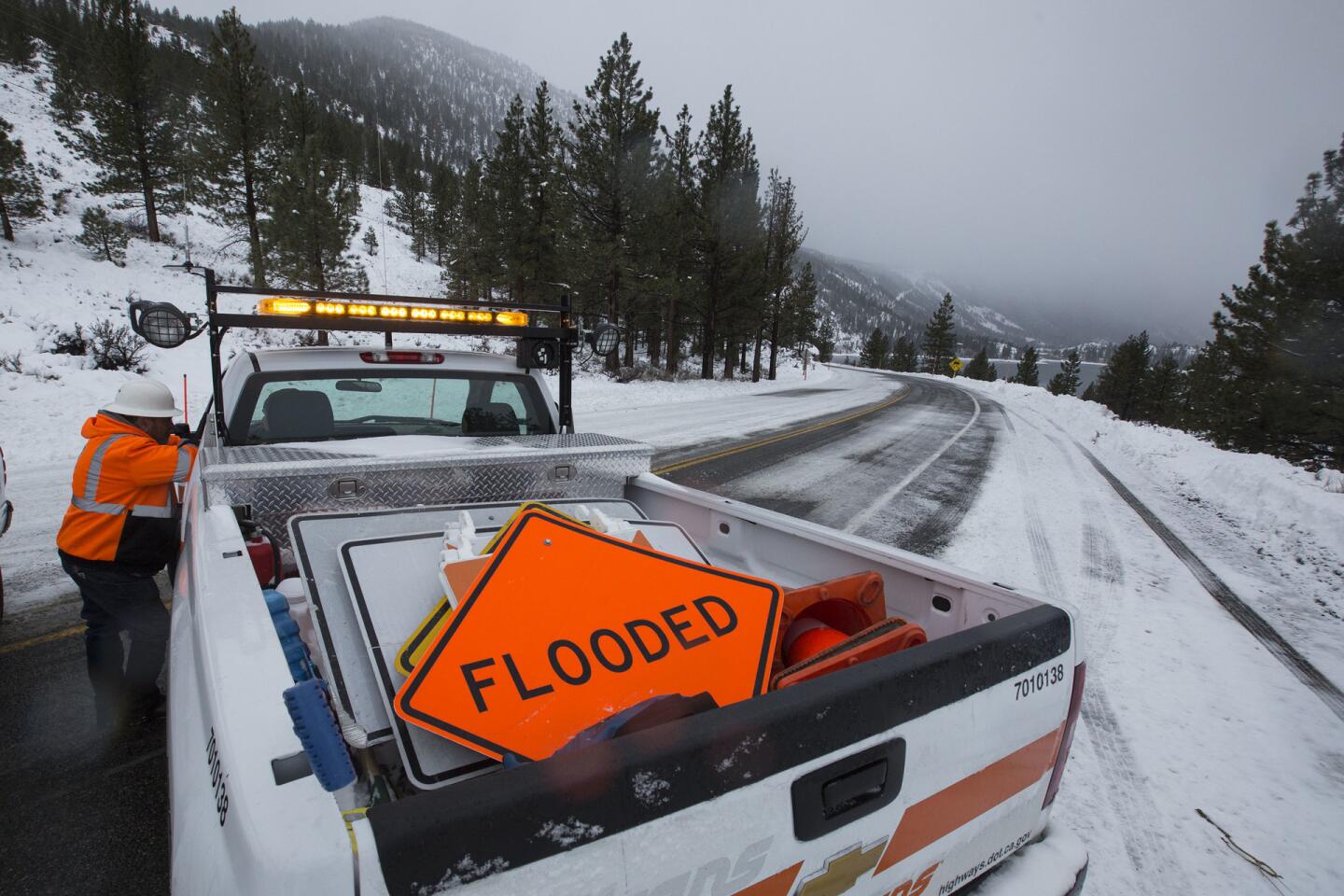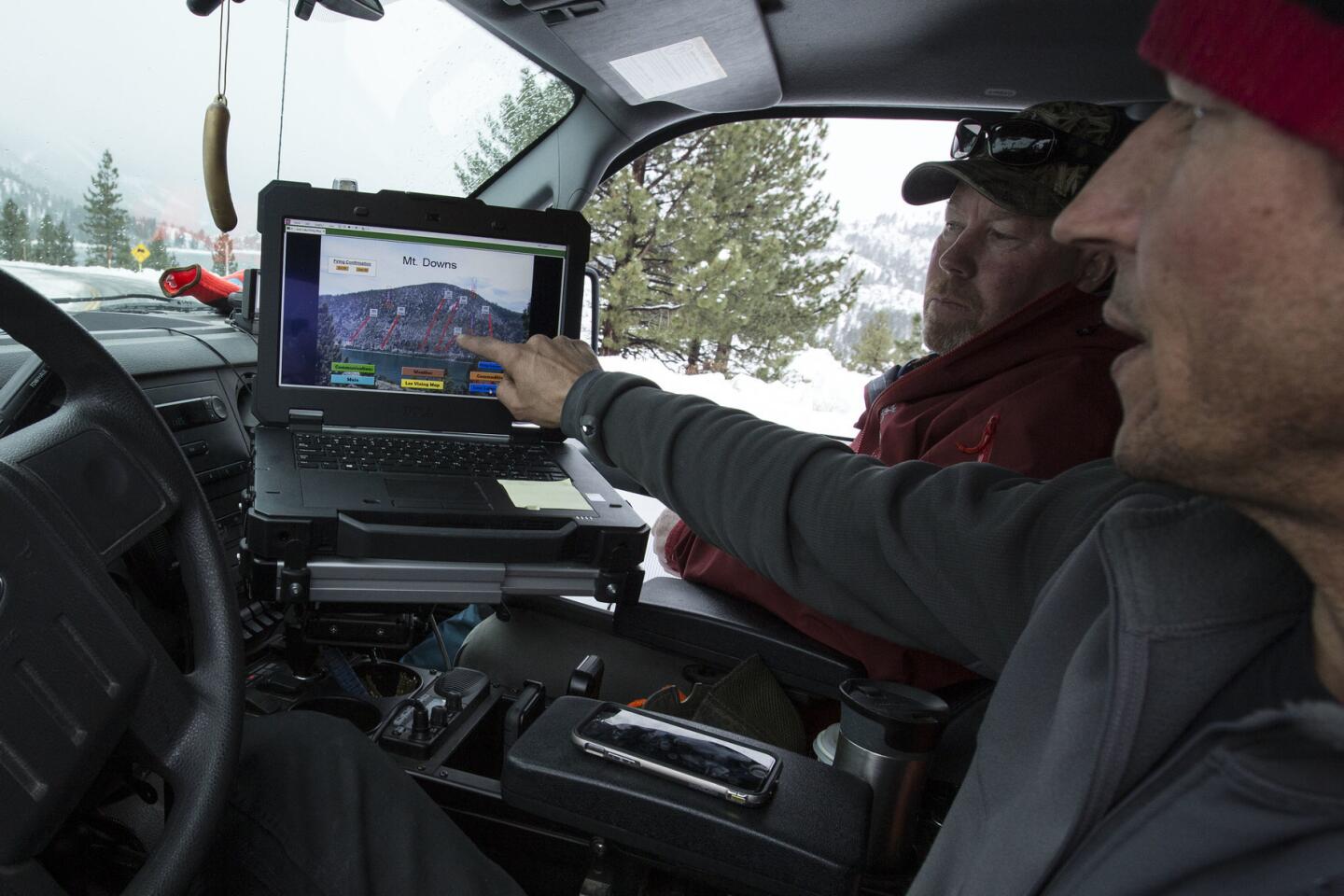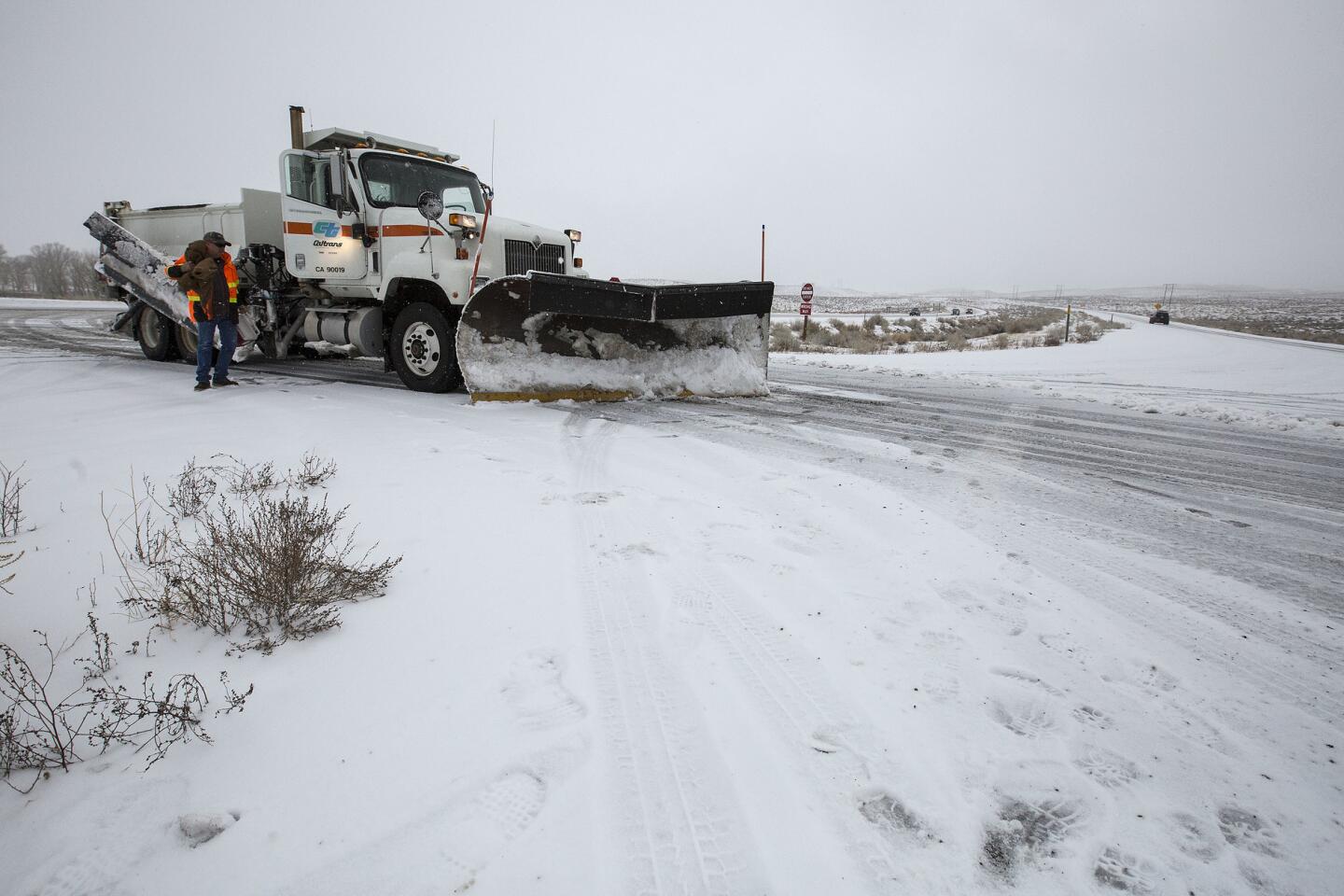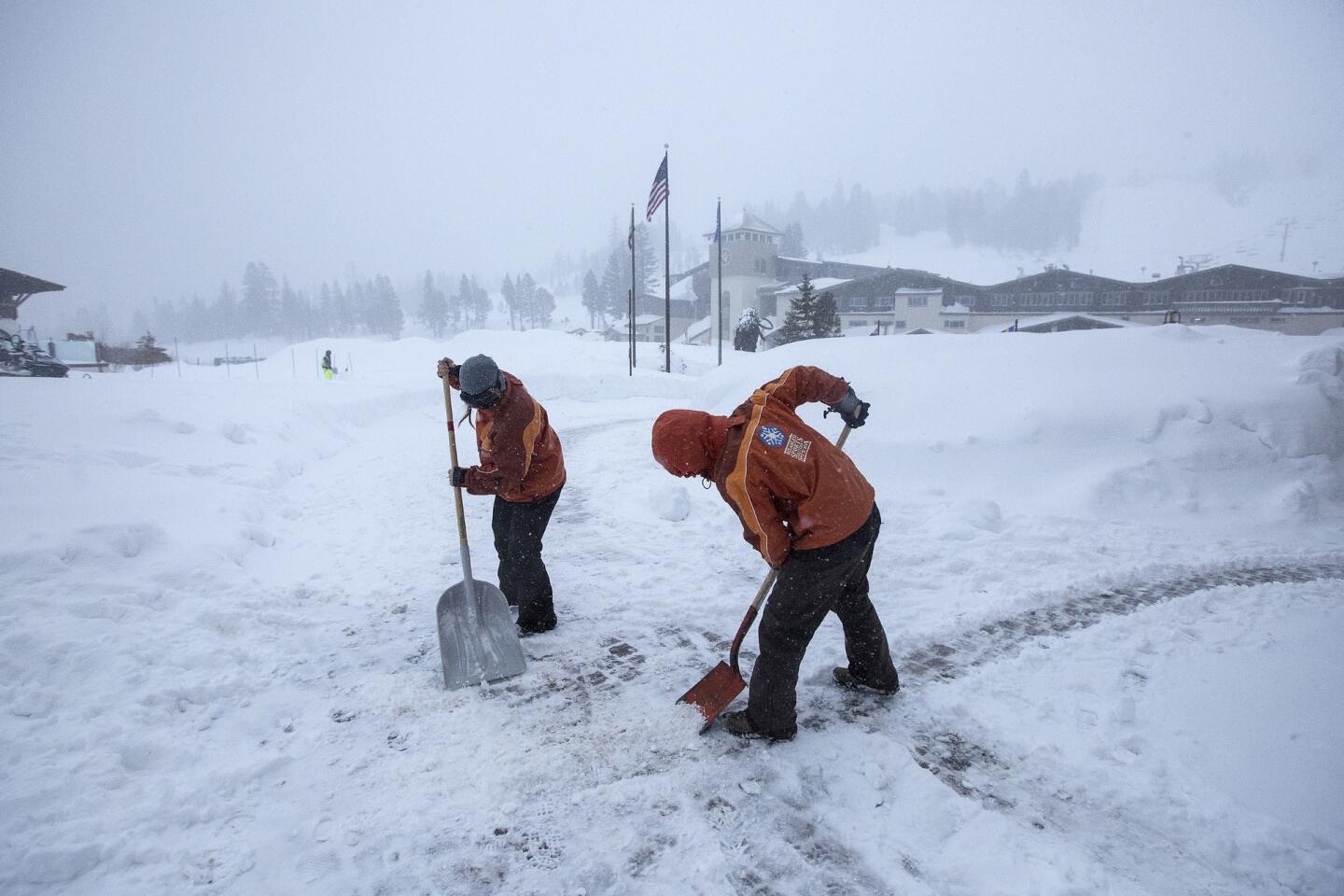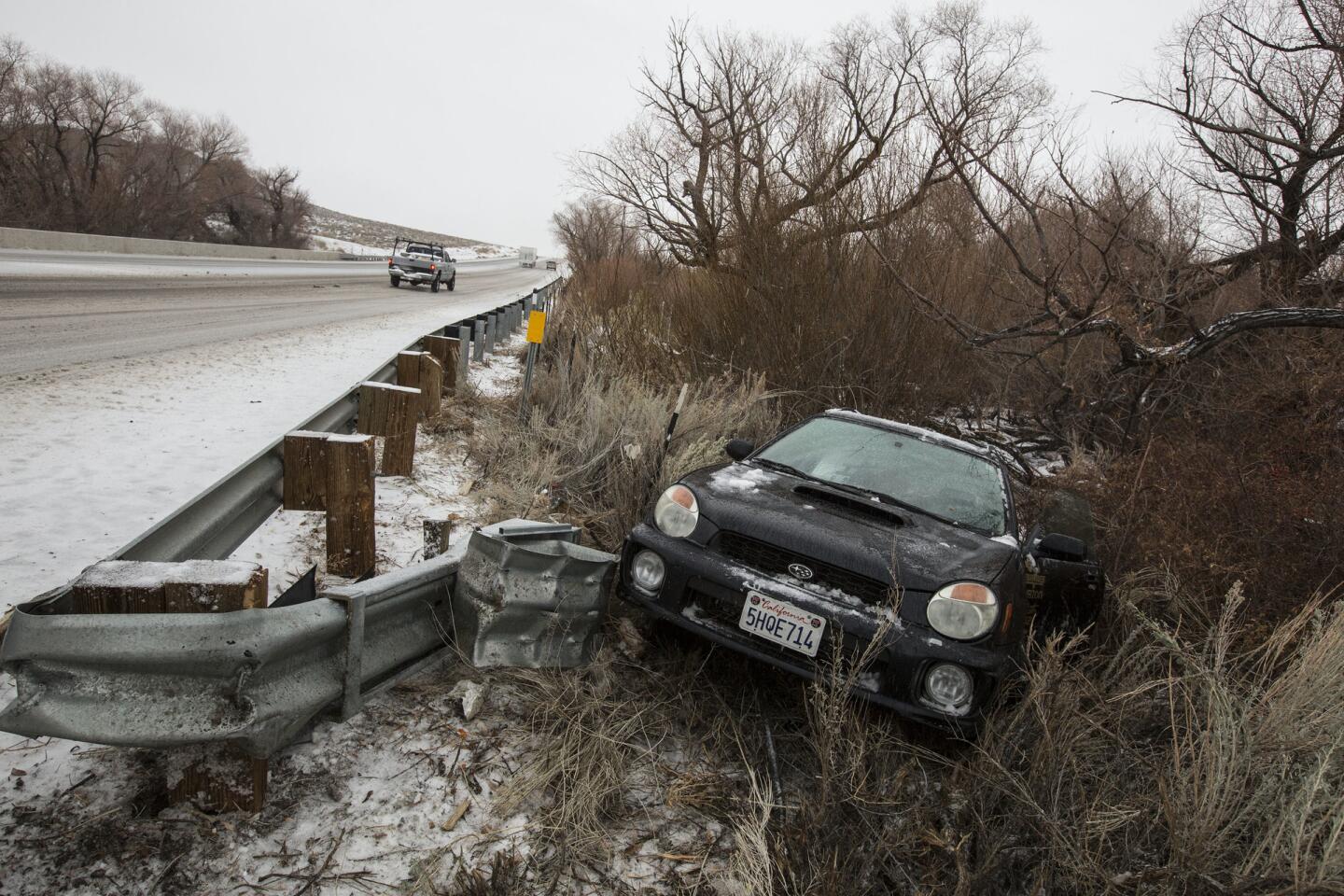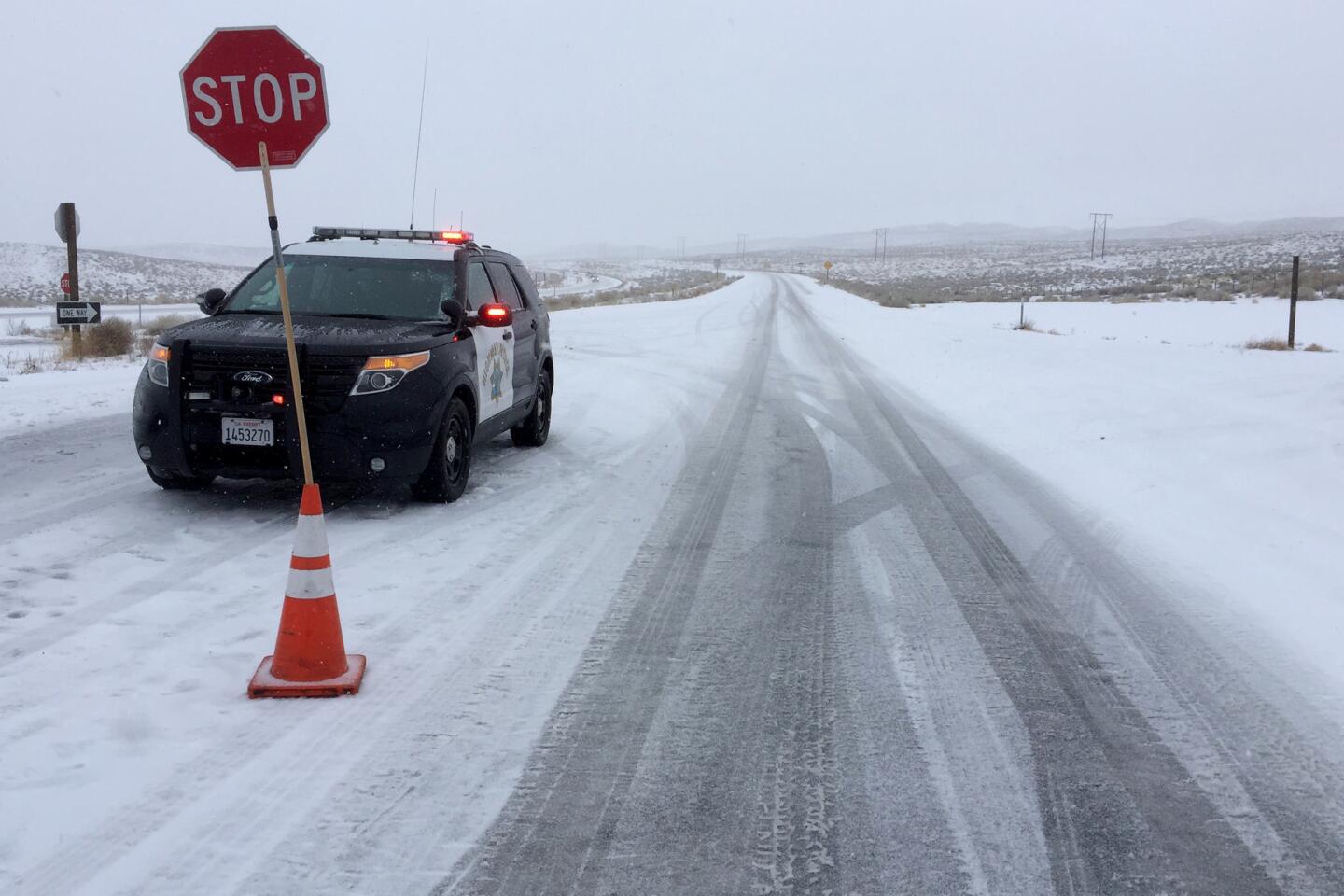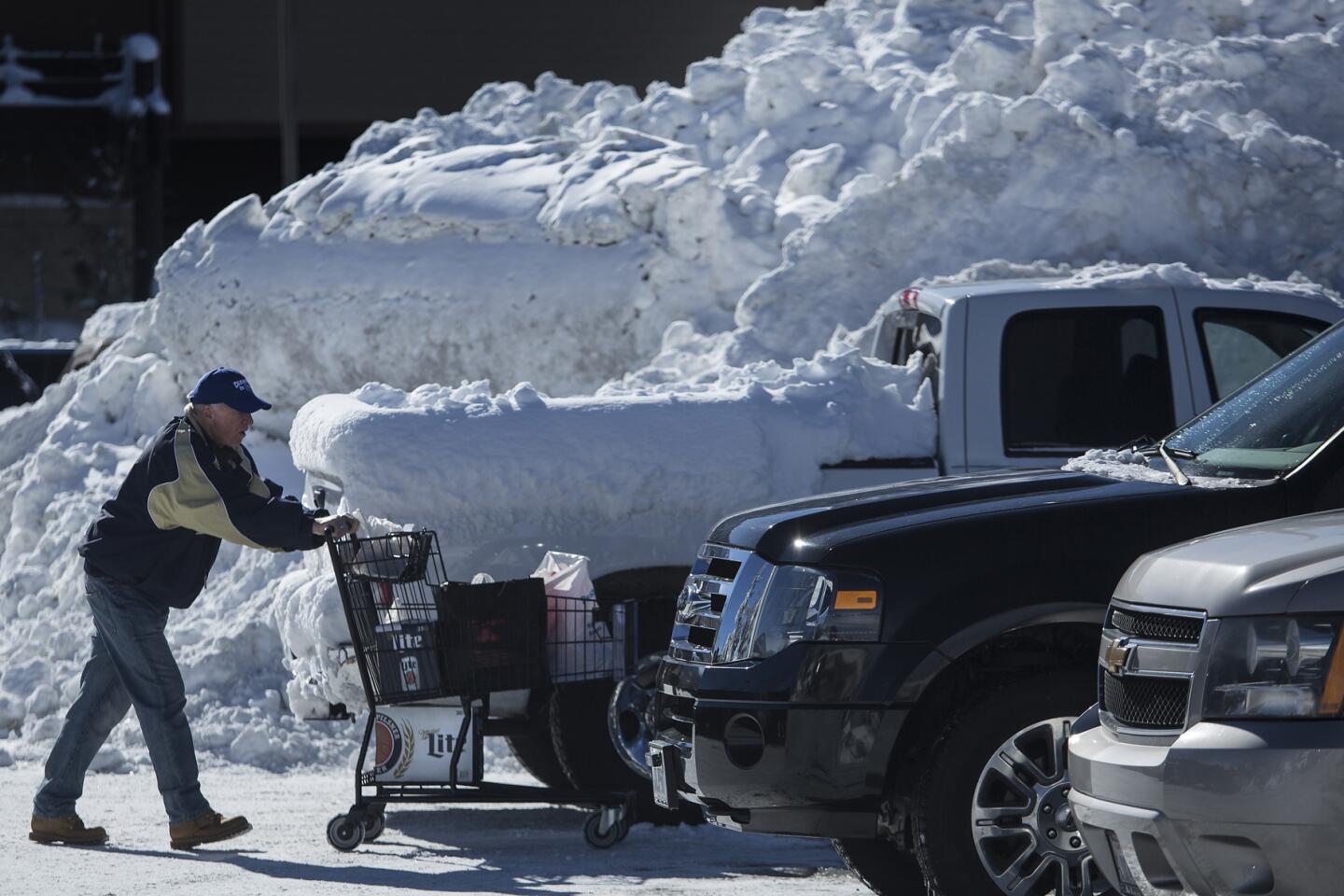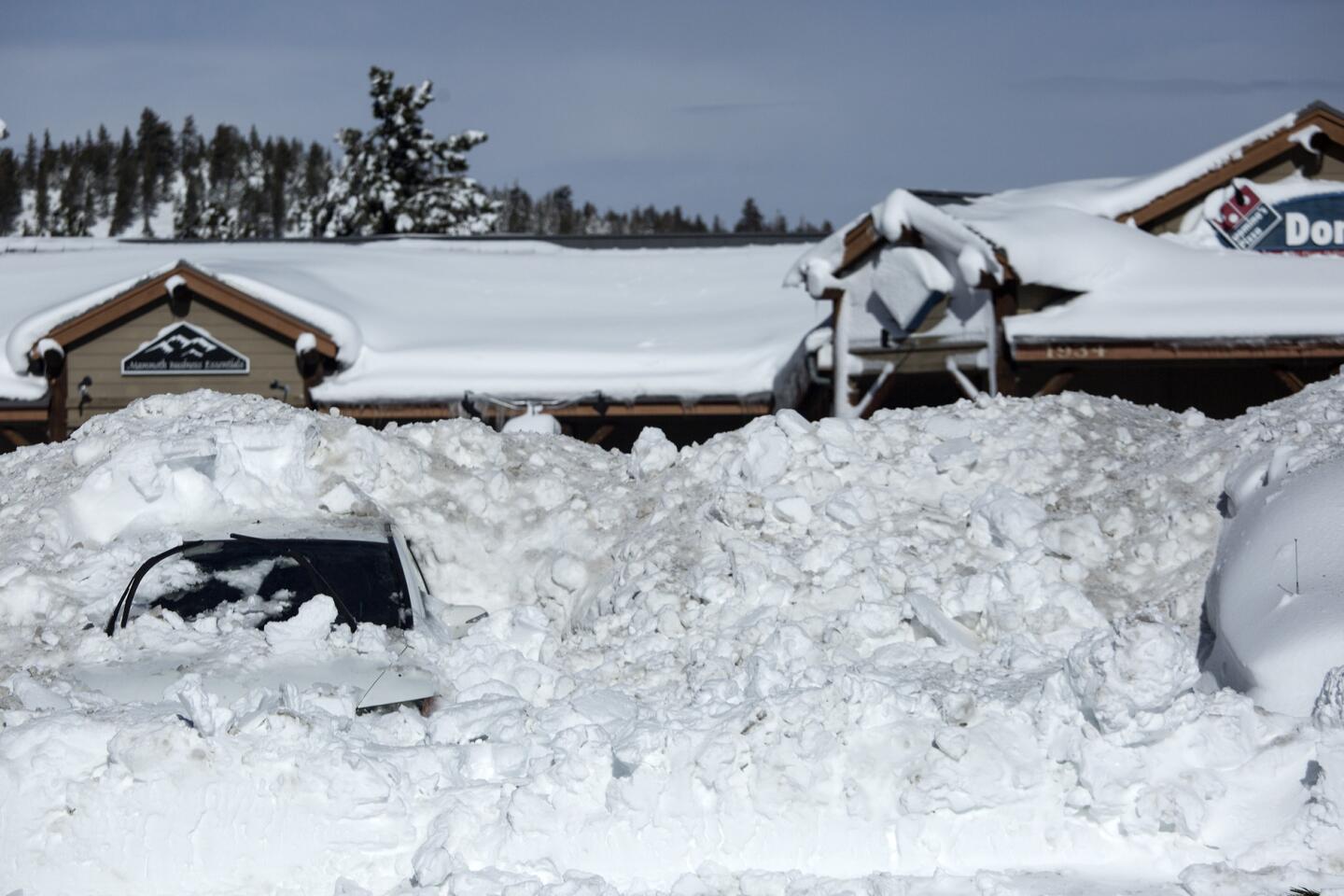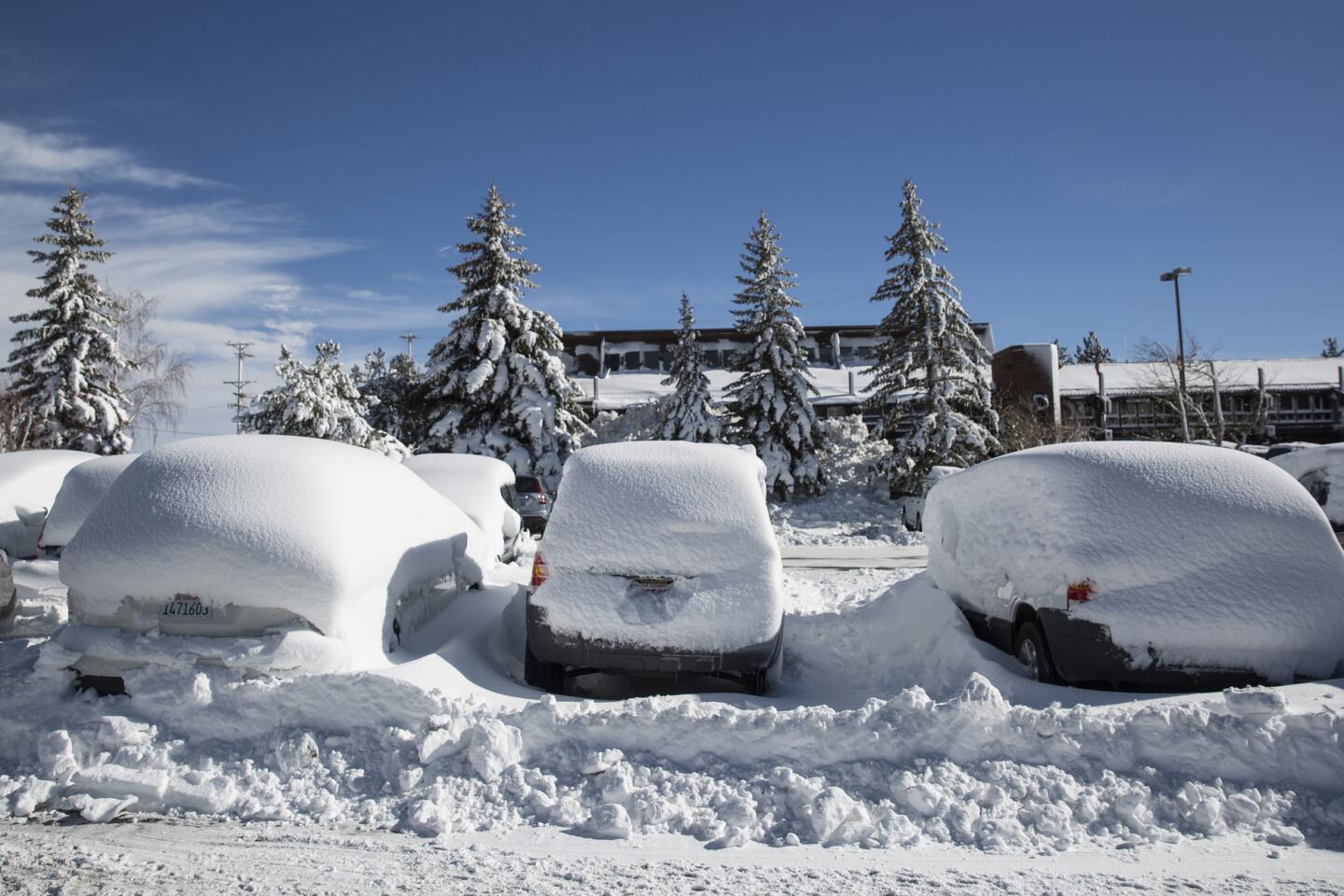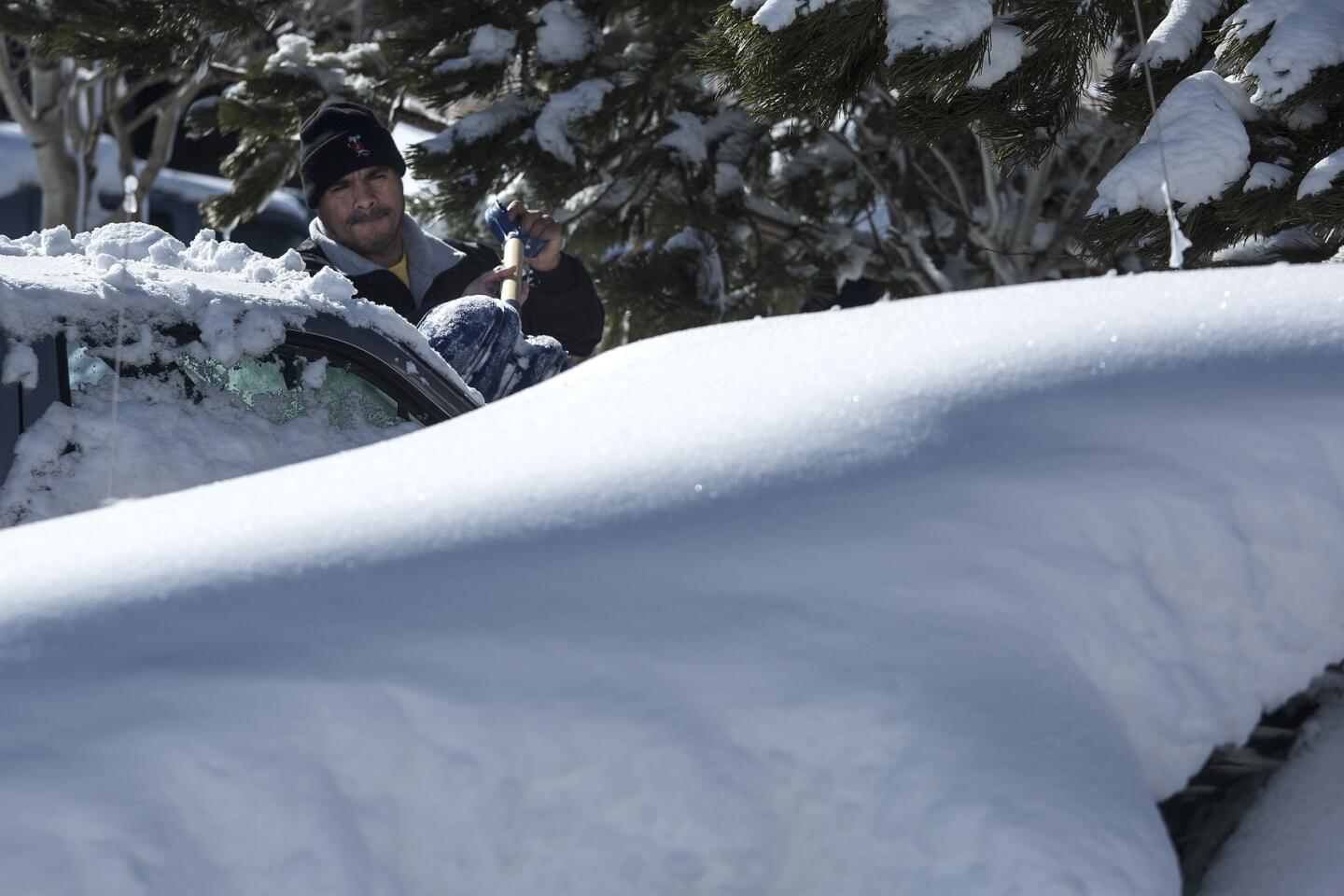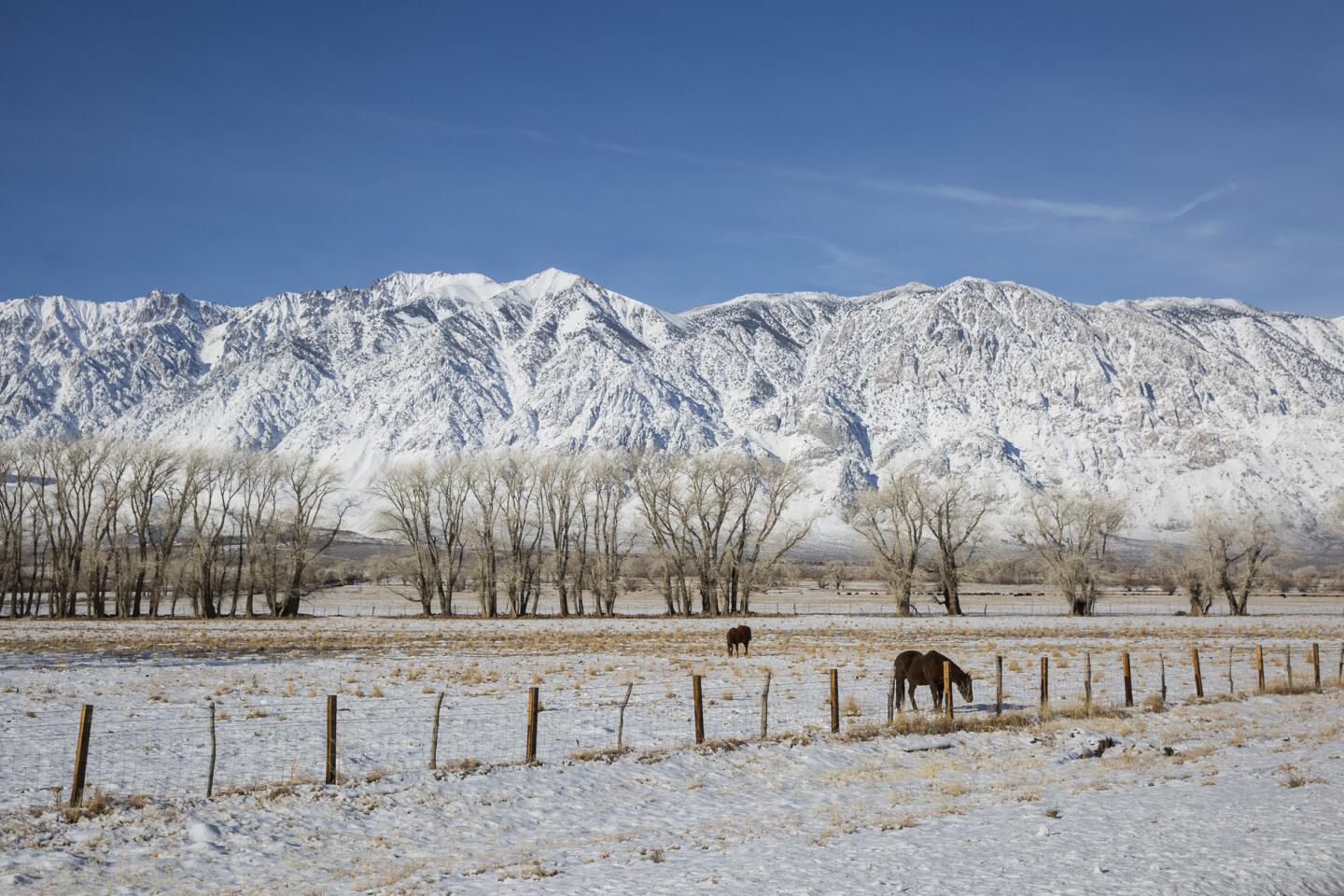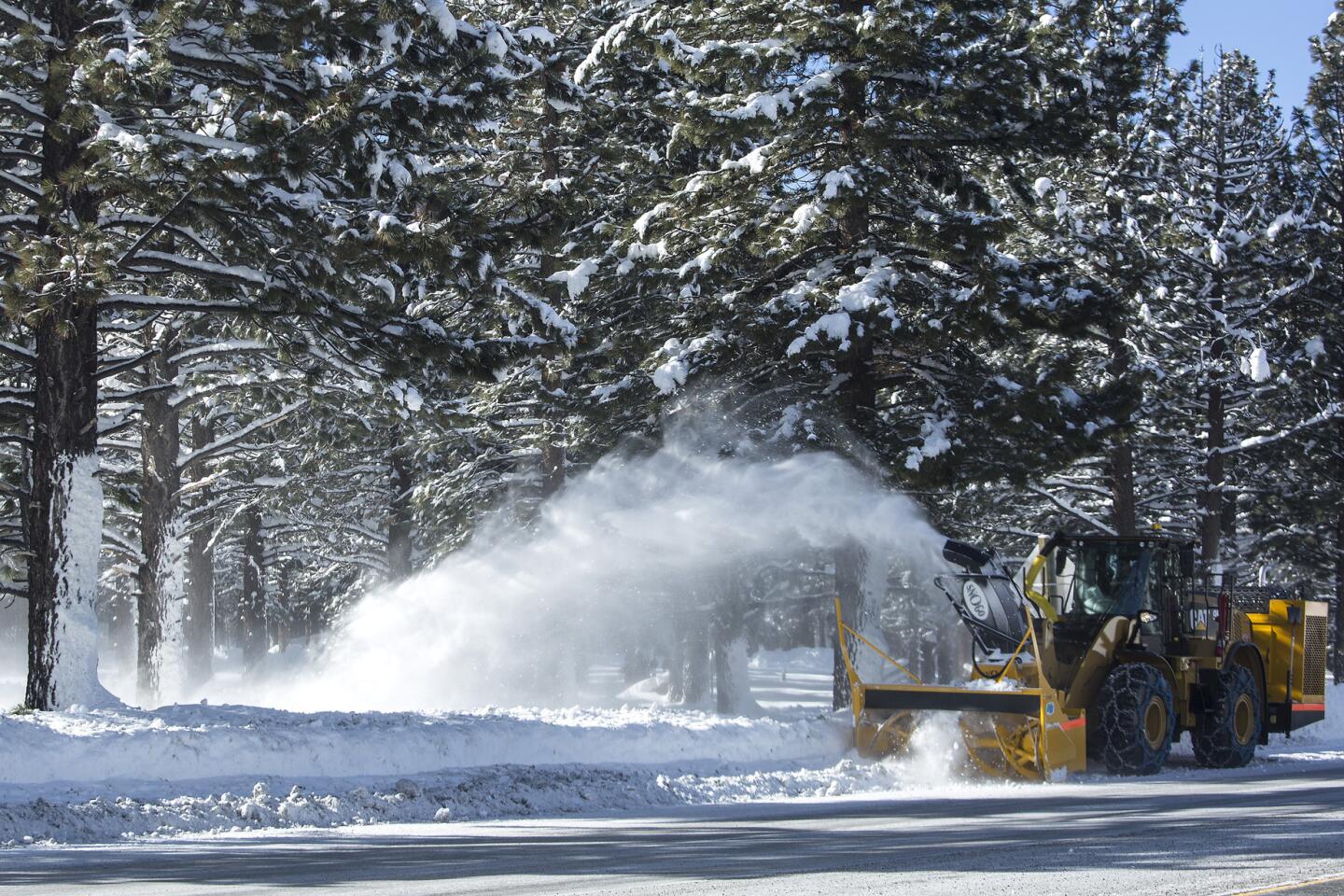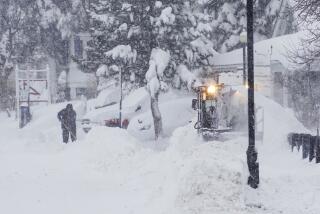Reporting from Truckee, Calif. — The roaring “Pineapple Express” weather system that drenched the northern Sierra Nevada over the weekend has begun to ease, but forecasters warned Monday that it would soon be replaced by yet another storm and plummeting temperatures.
“It’s not over yet,” said Alex Hoon, a meteorologist in the National Weather Service’s Reno station. “The flooding concerns are going to start going down, but everything is going to get a little colder.”
The latest storm, the third in a series of weather events that have pounded the Sierra Nevada and swollen Central California rivers, could bring seven feet of snow in higher elevations and three feet at lower altitudes, according to the National Weather Service.
“Now our threat has changed again to heavy amounts of snow, blizzard conditions, white-out conditions and avalanche dangers,” Hoon said.
On Monday, the weather service issued a storm warning for Northern California, western Nevada and southern Oregon for Tuesday through Thursday. During that time, several feet of snow are expected to pile up in high mountain passes and valleys, forecasters said.
Already, the storms have boosted seasonal rainfall totals to levels not seen in years across California, and wreaked havoc on transportation arteries over the rugged Sierra.
1/67
Surfer and Huntington Beach lifeguard Jachin Hamborg watches the dramatic sky and waves after surfing following his lifeguarding shift at dusk at the Huntington Beach pier.
(Allen J. Schaben / Los Angeles Times) 2/67
A man is silhouetted against a dramatic sky at sunset while walking on the Huntington Beach pier.
(Allen J. Schaben / Los Angeles Times) 3/67
A pedestrian takes to flight crossing 4th Street in Santa Ana after heavy rain flooded the area.
(Allen J. Schaben / Los Angeles Times) 4/67
Snowplows clear Highway 18 during a storm on Jan. 12, 2017, in Running Springs.
(Gina Ferazzi / Los Angeles Times) 5/67
Jessica Pompa and Albert Arroyo make a snowman at Firehouse Park in Running Springs.
(Gina Ferazzi / Los Angeles Times) 6/67
Michelle Graves keeps an eye on the sky as she waits to cross Spring Street in downtown Los Angeles.
(Luis Sinco / Los Angeles Times) 7/67
Laurel Canyon Boulevard remained closed in both directions Thursday morning in the Hollywood Hills after part of a home’s concrete foundation tumbled down a hillside after a round of rainfall.
(Al Seib / Los Angeles Times) 8/67
News crews gather on Laurel Canyon Blvd, which remained closed in both directions Thursday morning in the Hollywood Hills when part of a home’s concrete foundation tumbled down a hillside after a round of rainfall.
(Al Seib / Los Angeles Times) 9/67
A pedestrian wades through a flooded 4th Street in Santa Ana.
(Allen J. Schaben / Los Angeles Times) 10/67
Traffic moved slowly on a snowy Highway 18 in the Running Springs area.
(Gina Ferazzi / Los Angeles Times) 11/67
Members of a film crew shelter under umbrellas as the rain comes down in front of L.A. City Hall.
(Luis Sinco / Los Angeles Times) 12/67
A pedestrian wades through a flooded 4th Street in Santa Ana carrying her daughter.
(Allen J. Schaben / Los Angeles Times) 13/67
A man crossing the street gets caught in a heavy burst of rain on 4th Street in Santa Ana.
(Allen J. Schaben / Los Angeles Times) 14/67
A Guernville resident walks down steps toward the foodwater surrounding his home.
(Justin Sullivan / Getty Images) 15/67
A portable toilet is submerged in floodwaters at a vineyard in Forestville. (Justin Sullivan / Getty Images)
16/67
A woman walks through water from a king tide that flooded onto the Embarcadero in San Francisco on Wednesday.
(Jeff Chiu / Associated Press) 17/67
Caltrans worker Brad Larson is whipped by high winds on Tuesday as he mans a checkpoint closing all northbound traffic at U.S. 395 and State Route 203 near Mammoth Lakes.
(Brian van der Brug / Los Angeles Times) 18/67
Caltrans worker Mark Reistetter tells a Reno-bound truck driver his options at a checkpoint closing all northbound traffic at U.S. 395 and State Route 203 near Mammoth Lakes.
(Brian van der Brug / Los Angeles Times) 19/67
More than 100 trucks line Main Street in Lone Pine on Tuesday, stranded as U.S. 395 closed to high-profile vehicles in both directions because of high winds.
(Brian van der Brug / Los Angeles Times) 20/67
A Mammoth Mountain employee directing traffic is dwarfed by a snow removal vehicle on Minaret Road leading to the Mammoth Mountain ski area in Mammoth Lakes.
(Brian van der Brug / Los Angeles Times) 21/67
A tow truck driver pulls a pickup truck out of a snowbank in the median of U.S. 395 near Mammoth Lakes.
(Brian van der Brug / Los Angeles Times) 22/67
Clouds drift over the Owens Valley in a view from above Round Valley near Bishop.
(Brian van der Brug / Los Angeles Times) 23/67
Emma Soriano jumps in a puddle on the Manhattan Beach Pier after posing for pictures for her dad.
(Jay L. Clendenin / Los Angeles Times) 24/67
With the Manhattan Beach Pier in the distance, surfers scan the waves of Hermosa Beach.
(Jay L. Clendenin / Los Angeles Times) 25/67
Morgan Harris of Hermosa Beach rides home along The Strand after a couple of hours of surfing south of Hermosa Beach.
(Jay L. Clendenin / Los Angeles Times) 26/67
A biker at Hermosa Beach, where people were dealing with a lingering rainstorm.
(Jay L. Clendenin / Los Angeles Times) 27/67
A break in a series of storms moving across California highlights the snow-covered White Mountains looming over U.S. Highway 395 in Crowley Lake.
(Brian van der Brug / Los Angeles Times) 28/67
Traffic moves slowly at the Donner Pass Road exit on snowy Interstate 80 in Soda Springs.
(Gary Coronado / Los Angeles Times) 29/67
The Green Church, a beloved landmark along U.S. 395, is partly obscured by snow during a break in a series of storms in the Eastern Sierra Nevada near Mammoth Lakes.
(Brian van der Brug / Los Angeles Times) 30/67
Snow falls along Interstate 80 at Exit 184 in Truckee.
(Gary Coronado / Los Angeles Times) 31/67
A break in a series of storms in the Eastern Sierra Nevada highlights the snow-covered White Mountains near Convict Lake.
(Brian van der Brug / Los Angeles Times) 32/67
A plow removes freshly fallen snow along Donner Pass Road in Soda Springs, Calif.
(Gary Coronado / Los Angeles Times) 33/67
On a snowy day, a sign makes it clear that chains are required on this stretch of Interstate 80 in Truckee.
(Gary Coronado / Los Angeles Times) 34/67
Snow-covered mountains provide a dramatic backdrop for Crowley Lake. (Brian van der Brug / Los Angeles Times)
35/67
Jack Ryan and his family came out to see firsthand water cresting the south bank of the American River, flooding American River Parkway in Sacramento’s Discovery Park.
(Gary Coronado / Los Angeles Times) 36/67
Folsom Lake continues to rise as the Folsom reservoir releases water into the American River.
(Gary Coronado / Los Angeles Times) 37/67
Caltrans worker Wendy Payne clears debris after heavy rains caused flooding along Highway 89 near Truckee. (Gary Coronado / Los Angeles Times)
38/67
Traffic is backed up while CalTrans removes falling rocks and mud which closed one westbound lane along Interstate 80 east of Truckee, near Floriston, Calif.
(Gary Coronado / Los Angeles Times) 39/67
Wendy Payne of CalTrans clears debris along Highway 89 near Truckee.
(Gary Coronado / Los Angeles Times) 40/67
Christian Ochoa of CalTrans removes debris to allow water to flow into the Truckee River. (Gary Coronado / Los Angeles Times )
41/67
Park Ranger Cullen Tucker walks across a bridge during a rain storm on the Merced River in Yosemite National Park.
(Gary Kazanjian / Associated Press) 42/67
Resident June Barnard checks the level of the Truckee River at Bridge 11 along Highway 89. (Gary Coronado / Los Angeles Times)
43/67
Mammoth Mountain ski patrolman Cliff Klock, left, and Forest Service member Jeff Karl fire a 105-millimeter howitzer on Sunday to mitigate avalanche paths at the top of the ski area in Mammoth Lakes, Calif.
(Brian van der Brug / Los Angeles Times) 44/67
Mammoth Mountain ski patrolman Cliff Klock prepares to load a 105-millimeter shell into the breach of a 1943 howitzer.
(Brian van der Brug / Los Angeles Times) 45/67
Heavy rains and ice dams cause flooding along Donner Pass Road in high Sierra Nevada, Soda Springs, CA, Jan. 8, 2017. (Gary Coronado / Los Angeles Times) (Gary Coronado / Los Angeles Times)
46/67
A CHP officer proclaims “aw man!” as he is photographed after becoming stuck in heavy snow in the median of US 395 near Crowley Lake as snow falls on the Eastern Sierra Nevada.
(Brian van der Brug / Los Angeles Times) 47/67
Monique Long hauls sandbags from her SUV to make a barrier to divert the rain and melting snow from flooding her garage, while her friend Jenna Shropshire, right, helps shovel snow, in Truckee, Calif.
(Gary Coronado / Los Angeles Times) 48/67
Mitch Brown operates a skid steer removing snow so water can flow freely preventing flooding in Soda Springs, Calif.
(Gary Coronado / Los Angeles Times) 49/67
Skiers coming off the mountain endured rainy conditions all day at the Sugar Bowl Ski Resort, in Norden, Calif.
(Gary Coronado / Los Angeles Times) 50/67
The train passes under an avalanche tunnel near the Sugar Bowl Ski Resort, in Norden, Calif., on Jan. 7, 2017.
(Gary Coronado / Los Angeles Times) 51/67
Caltrans snowplows clear heavy snow from the northbound lanes oh highway 395 as snow falls on the Eastern Sierra near Sherwin Summit, Calif.
(Brian van der Brug / Los Angeles Times) 52/67
A sign at Wawona and Glacier Point roads alerts visitors that roads into Yosemite Valley in Yosemite National Park are closed. (Silvia Flores / Associated Press)
53/67
Actor Max Baer Jr., left, talks with emergency responders after flipping over his SUV in white-out conditions while traveling northbound on U.S. 395 near Crowley Lake as heavy snow falls on the Eastern Sierra Nevada, Calif. The star of The Beverly Hillbillies said his was not injured.
(Brian van der Brug / Los Angeles Times) 54/67
A snowcat moves snow in near whiteout conditions on the slopes at Mammoth Mountain.
(Brian van der Brug / Los Angeles Times) 55/67
A CHP officer maintains a checkpoint to ensure vehicles are compliant with R2 chain restrictions on the northbound 395 just north of Bishop as snow falls on the Eastern Sierra Nevada.
(Brian van der Brug / Los Angeles Times) 56/67
Caltrans crews have a road-flooded sign in case of heavy rain and snow near the Eastern Sierra Nevada town of June Lake, Calif.
(Brian van der Brug / Los Angeles Times) 57/67
Caltrans avalanche crew members Sky Greytak, right, and Pat Brannen, left, prepare to set off explosive charges remotely from a laptop during avalanche control operations near the Eastern Sierra Nevada town.
(Brian van der Brug / Los Angeles Times) 58/67
Caltrans snowplow operator Mike Morgan prepares to turn his plow around after making loops on the 395 between Bishop and Tom’s Place, a route he drives 12 hours a day clearing heavy snow in the Eastern Sierra.
(Brian van der Brug / Los Angeles Times) 59/67
Mammoth Mountain employees clear paths as snow falls lightly Saturday morning.
(Brian van der Brug / Los Angeles Times) 60/67
A car spun out and off the road just outside Bishop in sloppy road conditions as the snowfall level fell below 5000.
(Brian van der Brug / Los Angeles Times) 61/67
California Highway Patrol has established a chain checkpoint near Bishop.
(Brian van der Brug / Los Angeles Times) 62/67
Supermarket shoppers stock up before the big storm. (Brian van der Brug / Los Angeles Times)
63/67
Snow covers vehicles in a parking lot in Mammoth Lakes.
(Brian van der Brug / Los Angeles Times) 64/67
Snow covers vehicles in a parking lot in Mammoth Lakes. (Brian van der Brug / Los Angeles Times)
65/67
Jorge Gaydam digs out his truck in a parking lot.
(Brian van der Brug / Los Angeles Times) 66/67
Snow blankets the Sierra Nevada crest north of Bishop along U.S. Highway 395 in Round Valley.
(Brian van der Brug / Los Angeles Times) 67/67
A plow removes snow from state Highway 203 in Mammoth Lakes.
(Brian van der Brug / Los Angeles Times) With additional snow this week, some Sierra Nevada peaks could have received up to 20 feet of snow in the first two weeks of the year, Hoon said.
Lake Tahoe and Mammoth Mountain could receive up to 4 feet of snow by Thursday, and higher elevations could see twice that, Hoon said. The people who should be the most concerned are residents there and any unlucky motorist who has to drive across the mountains. Interstate 80 could be closed, as it was this weekend following a huge mudslide Sunday, Hoon said.
The overnight closure on the 80 was lifted Monday.
Elsewhere in the state, the atmospheric river event caused widespread flooding, downed trees and unleashed mudslides.
“I mean, we’re in the heart of our wet season where these storms can happen,” said state climatologist Mike Anderson.
The storms have dropped enough water that Folsom Reservoir, among others, was forced to release water Monday for flood control, Anderson said. The back-to-back storms from last week and the weekend have also most certainly helped replenish depleted groundwater basins depleted from years of drought, though the full benefits of the rain won’t be known for some time, he said.
“We haven’t seen an event of this magnitude in at least a decade,” Anderson said.
The upcoming storm is colder than the weekend one, meaning it should add more to California’s snowpack, a precious water supply a third of the state relies on in the spring and summer months when it melts.
The Sierra Nevada snowpack statewide was at 126% of its average for this time of year on Monday, the California Department of Water Resources stated.
Whiteout conditions caused by blowing snow on U.S. 395 near Convict Lake, Calif., Monday afternoon. (Brian van der Brug / Los Angeles Times)
One of those areas hard-hit by the weekend storm was Yosemite National Park, which closed popular Yosemite Valley over the weekend in anticipation of the Merced River flooding. Though the waters did overwhelm the river, it wasn’t to the degree that park officials anticipated. Yosemite Valley will reopen to the public Tuesday morning, officials said.
On Sunday, hundreds of people were evacuated from their homes as rivers overflowed their banks. Several key highways including Interstate 80, Interstate 280, U.S. 395 and U.S. 101 were closed for periods because of hazardous conditions.
Authorities were trying to determine whether the deaths of three people in the Bay Area — one killed by a falling tree, two others by car accidents — were related to the storm.
In Sonoma County, emergency officials issued voluntary evacuation orders to hundreds of households along the Russian River and the Truckee River in Reno as the rivers reached the flood stage.
The Truckee River topped its banks, submerging picnic tables on riverside campgrounds along Highway 89 north of Lake Tahoe. Forecasts from the U.S. Geological Survey called for the river to rise another 3 feet, imperiling private bridges to cabins alongside both banks.
Along the Russian River, about 650 homes and a handful of businesses in the low-lying areas of Monte Rio and Guerneville were advised to evacuate. County officials expected the river to reach flood stage late Sunday and stay at flood levels through Tuesday.
Ten homes in the Carmel Valley were partly flooded late Sunday after a river swelled from the heavy rain, authorities said.
Rising flood waters have also triggered actions to protect the town of Sacramento itself.
For the first time in a decade, the floodgates of the Sacramento River opened Monday morning, releasing a wall of water downstream into the Yolo Bypass. The National Weather Service warned farmers in that region of the Sacramento River valley to have livestock and farm equipment moved out of the way. The California Department of Water Resources last opened the gates of the manually operated weir, built in 1916, in 2005.
The low-level Yolo Bypass is one of several drainage areas designed to catch floodwaters in such situations, but is used for farming in dry years.
Perhaps most worrisome, the storm is one of a string that is expected to continue dumping more rain and snow through Thursday, part of a so-called atmospheric river of moisture known as the Pineapple Express.
“This is a serious situation,” said Mark Faucette, a National Weather Service forecaster based in Reno. “There’s a significant threat to life and property as we go through the next couple of days with widespread flooding, continued road closures and high water in low-lying areas.”
Live updates on the storms »
The powerful storms are the latest in a series of weather systems that are beginning to make a dent in California’s six-year drought.
Officials said the drought still persists but that 2017 could mark a turning point if the deluge of rain and snow continues into the spring.
In Southern California, rain rolled in late Sunday and was expected to bring up to 2 inches of rain to Los Angeles County, disrupting the Monday morning commute.
After a brief lull Monday afternoon, another storm is expected to roll through the Southland on Tuesday night and Wednesday, delivering up to half an inch of rain. That system will bring potential snowfall above 6,000 feet. A third storm late Thursday could bring snow as low as 4,000 feet and affect the commute in mountain passes, including Interstate 5 at the Grapevine.
The rainfall totals in Southern California over the weekend were less than in the northern parts of the state, but officials said that the speed of the downpour — up to a half-inch per hour — elevated the risk of flash floods and mudslides.
In Nevada, where Gov. Brian Sandoval issued a state of emergency, Washoe County officials asked residents to stay home Monday, when courts and several government offices were closed. Local high schools were quickly transformed into evacuation centers.
The storm toll included one of Calaveras County’s oldest residents, a giant sequoia called the Pioneer Cabin for the tunnel that had been carved into its broad base 137 years ago. It was located in Calaveras Big Trees State Park and toppled Sunday during the storm.
“We lost an old friend today,” wrote county resident Jim Allday, who posted a picture of the fallen titan on Facebook . His photos show the tree trunk splintered heavily at its base. The giant sequoias in the state park are estimated to be more than 1,000 years old.
As heavy rain fell Sunday, melting mounds of piled-up snow and sending water and slush into the streets of the eastern Sierra Nevada ski town of Mammoth Lakes, residents girded for flooding.
“My garage is flooding with 2 inches of water,” said Nick Criss, 40, as he shoveled sand into bags at the town’s public works yard.
Criss, a 12-year Mammoth Lakes resident, worries that his home and many others will be damaged by the gush of rainwater and melted snow.
“There’s nowhere for the water to go,” he said.
Lifts at Mammoth Mountain resort were shut down Sunday because of high winds, thunder and lightning. They were reopened Monday, according to the resort’s website.
[email protected] | [email protected] | [email protected] | [email protected]
Barboza and Sahagun reported from Mammoth Lakes, St. John from Truckee and Hamilton from Los Angeles. Times staff writers Deborah Netburn and Soumya Karlamangla contributed to this report.
ALSO
Powerful storm causes widespread flooding in Northern California, evacuations in Sonoma County and neighboring Nevada
How much rain did we get? Ask the iRain app, created at UC Irvine
Skiers and snowboarders are inundating resorts, paying higher lift prices
With snow piling up in the Sierra, what will it take to end California’s drought?
UPDATES:
6:18 a.m. Jan. 10: This article was updated to reflect the floodgates of the Sacramento River were opened.
2:55 p.m.: This article was updated with comments from a state climatologist.
10:50 a.m.: This article was updated with details on a mudslide on Interstate 80.
9:05 a.m.: This article was updated with details on the Sacramento River.
8:15 a.m.: This article was updated with a new forecast.
7:50 a.m.: This article was updated with Carmel flooding.
6:55 a.m.: This article was updated with the latest flooding news.
This article was originally published at 3 a.m. Jan. 9.


